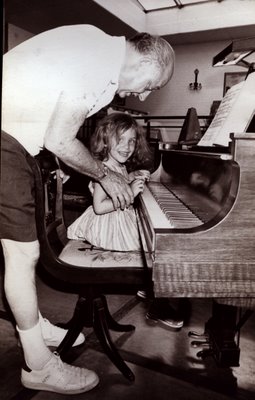
Yesterday I found myself having a pleasant short walk (a very cold but clear evening) from my house to the Unity Church on Oak and 42 Street. I was going to a Early Music Vancouver concert featuring the Axelrod Quartet the resident Smithsonian Museum of American History chamber music quartet. The Axelrod is headed by our very own Marc Destrubé (Pacific Baroque Orchestra, Turning Point Ensemble and several more etcs!) on first violin. Marilyn McDonald played the second violin, James Dunham, viola and Kennth Slowik, violoncello.
Slowik explained in a charming pre-concert talk with slides and some piano-playing-show-and-tell. The music of the evening consisted of an early and a late Felix Mendelssohn Bartholdy ( 1809-1827) quartet for strings and the phenomenal and ever popular Octet for Strings in E-flat Major, Op. 20 (1825). Slowik pointed out that the connection of the evening’s concert to the mandate of Early Music Vancouver was twofold. The concert was being played in instruments more or less from or adapted to the time Mendelssohn’s music was first performed. Thus the sound would be pretty close to what the people of the time would have been used to. Then Slowik told us that Dunham’s viola had been built in the late 1500s!
But this blog is not about last night’s concert per se (even though I enjoyed it immensely), but about two people and the prints of Jack Shadbolt.
I had never been inside this church. There are no crosses that I could discern inside and instead of pews they had upholstered seating much like in a cinema. The only religious symbol I found was a print of a shepherd holding a sheep on altar right. The altar itself was bare except for many plants and the musicians’ chairs. On the side walls I noticed about 16 beautifully framed bold, multi-coloured Jack Shadbolt prints. I was so amazed that I questioned Dr. Stephen Drance, a lover of music who believes in donating money in order to listen to his preferences. “I don’t think it is out of the ordinary, after all this is the 21st century!” While Dr Drance is much older than I am, he is certainly the younger man.
Whenever I go to theatre, dance, opera, ballet and concerts of all types I run into a short friendly French Canadian, Denis Bouvier. I affectionately have given him the nick name of Inspector Clouseau. Bouvier has been with Radio Canada since I first arrived in Vancouver in 1975. He is the “Réalisateur”of a two hour long afternoon radio program called Le pont des Arts. Imagine two hours full of cultural entertainment when the English side, of our local CBC Radio, perhaps features at the most 15 minutes per day!
I like the French word for producer Réalisateur because it is much like it is in Spanish realizador. It means to make true. This Radio Canada producer makes our wishes come true with an enthusiasm that is as palpable as his smile.
As I see that smile on Bouvier’s face I wonder what it is that Radio Canada knows about cultural coverage that seems to elude the English side where culture is placed at the bottom. As a CBC Radio producer told me with a promise to not use his/her name, “In Vancouver and especially in the interior its sports and labour problems.”
I was introduced by Turning Point Orchestra trombonist Jeremy Berkman to a friendly woman, Yolaine Mottet who is the Animatrice for Bouvier’s Le pont des Arts. I asked her point blank what it was they knew about culture and arts programs that the English CBC did not know. She said nothing. I asked her who on the English side would be responsible for the no-culture programming. Again not only did she say nothing but she turned her hands up in a “How should I know?” I have a feeling that many other people challenge her with the same question.
I pressed further. “How can you find people who speak French for you daily programs? You must run out quickly." With that smile of hers she told me that they had interviewed Axelrod Quartet cellist Kenneth Slowik who had not spoken French for some years but magically remembered enough of it quickly, to give them a good interview.
Thinking about Dr. Drance’s liberal non surprise at seeing Shadbolts in a church and mulling in my head Bouvier’s all-encompassing appreciation and love for all art (or at the very least this man has varied tastes) Milton Glasser came to mind. Not Milton Glasser the famous designer of the little red heart of I love NY fame but another who was an important mentor in my appreciation of music.
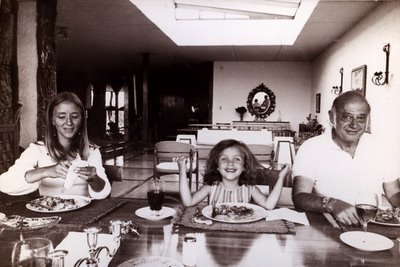
My Milton Glasser was a Jewish dentist from New York who once told me, “I have always tickled the ivories. I used to when I was a dentist and I keep on now when I accompany Jean on the piano.” Retired dentist Glasser had moved to Mexico City in the early 70s with his virtuoso violinist and violist wife Jean who had been hired as principal violinist for the orchestra of the University of Mexico. The Glassers invited us to their home for pre-concerts which featured Jean’s excellent cooking. We treasured those afternoons at the Glasser and they became our eldest daughter’s first exposure to performed music.
I got into several arguments with Milton Glasser (in the second picture that's my wife Rosemary on the left) about music. I told him I had a preference for Italian baroque and for Bach. “I am not interested in the least in what followed, especially those Romantics.” Glasser with a kind smile on his face told me repeatedly but gently, “You will change your mind one day. Mark my words.” I now realize that at age 31 I was an ignorant, biased and opinionated idiot. There are some (including my wife) who would say that I have not changed except that I am older.
The Glassers had a son, Alan, who was (and is) a plasma physicist of fame. He played the clarinet so when he visited his parents we were exposed to trios of clarinet, piano and violin or viola. This is how I first heard the music of Ernest Bloch. But my favourite was a trio version of Pablo de Sarasate’s Zigeunerweisen. One day Milton Glasser sat at the piano and played some confusing music that I almost liked. It was interesting. “What is it? “I asked. It is one of Darius Milhaud’s Saudades do Brazil. He wrote 10. He lived in Brazil for some years and fell in love with it.” In spite of my youthful ignorance I knew that one of my fave jazz pianists Dave Brubeck had studied under Milhaud. Suddenly I could hear a little Brubeck in those Milhaud piano sonatas.
And while I am sure the Glassers are no longer alive in New York, I am sure that in some way, from somewhere they smile upon my more varied and universal tastes in music. Back then I would not have been caught dead listening to a Mendelssohn quartet.
Could it be that it has taken me this long to find out something that the French have always known?
Simone Orlando Blurs It Sharply & God Talks To Me
Friday, February 27, 2009

Last night's premiere of The Goldberg Variations – Side 2: Adam & Eve & Steve, by Ballet BC at the Queen Elizabeth Theatre was a felicitous event. It was more so as my companion was not my granddaughter Rebecca who is suddenly eschewing all dance for the dressing up of celebrities at Stardoll. My companion was her mother, my daughter Hilary, who had not been to the ballet for some time. She greeted The Goldberg Variations and Jean Grand-Maître's Carmen with awe, delight, smiles and contented attacks on our stock of dark bitter chocolate. In short it was an evening that Hilary and I will not soon forget.
From the point of view of this amateur, Kudelka's work consists of an inner core of three dancers, Simone Orlando, Jones Henry and Shannon Smith and an outer frame (much like a beautiful and ornate gold leaf frame at an expensive gallery) of dancers, Marrianne Bauer-Grobbelaar, Alexis Fletcher, Maggie Forgeron, Shannon Ferguson, León Feizo-Gas, Connon Gnam, Peter Smida and Daniel da Silva. This frame of beautiful young boys in short shorts and girls in costumes so light in texture and in substance (designed by Nancy Bryant) revealed more well-formed and muscular thighs (the girls’, I mean, and I must point out that Alexis Fletcher has thighs and legs to compete with those of my idol-of-legs actress Alexis Smith) that I have ever seen in any ballet of memory. It was exotic eye candy with movements that were all classical ballet.
During the action I trained my eyes to blur them out a bit as I was transfixed by veteran dancer Jones Henry whom Kudelka has managed to elicit a performance that would suggest that as soon as Ballet BC secures funds they might have to raise his salary to keep him on! I found myself watching his face as well as Simone Orlando's and Shannon Smith's for the delicate expressions of confusion and doubt (Jones Henry) warmth and understanding (Simone Orlando) and perfect confidence (Shannon Smith). These three, used movements that were striking, in their almost anti-balletic look. They contrasted with the constant swerving and swirling of the outer Corps de Ballet. And I watched, and watched Simone Orlando and how her beautiful dress (for more read below) swished at Kudelka's beckoning much in the same way as so many years ago Lauri Stalling's hair had done so for his 15 Heterosexual Duets. All in all, The Goldberg Variations was an unsettling, pleasing and demanding work with substance in an age that unsettles, pleases with banalities and substance is absent.
I have been upset of late in the knowledge that both the strong Donald Sales and the tall and cool Edmond Kilpatrick are gone from Ballet BC. I feel better. I am a new fan of Australian Shannon Smith who was perfect in his contrast to the pathos of the confused (so wonderfully confused) Jones Henry whose face and a few small and calculated steps seemed to be a window into his soul.
Of Carmen I can only say that Hilary thinks that Shannon Smith is a most manly Don José. Jones Henry pulled all sorts of dazzling veronicas in spite of not having a matador's cape. Makailla Wallace's performance as Carmen's foil, Micaella (the last time around she played Carmen) had shades of that classical ballerina of a Ballet BC recent past, Andrea Hodge who is now the company's Ballet Mistress along with Beverley Bagg.
Of Marianne Bauer-Grobbelaar's Carmen, her red hair and that crooked smile brought me unsettling (the more unsettling for this old man of 66) responses in my nether parts as she reminded me of Vancouver's best ever exotic dancer Tarren Rae. Her performance was as spirited as that of a haughty mustang in heat. But her temper tantrums (only for me I vouch) did not convince me as much as that of the fiery ones of that real kitchen-plate-smasher and Ballet BC's first Carmen, Sandrine Cassini.
----------------------------------------------------------------------------------------------------------------------------------
Of Simone Orlando's Photo Above, of Nancy Bryant's Wonderful Dress and James Kudelka's Instructions
Years ago when I started shooting variety shows at the CBC when it has just moved to its modern premises on Hamilton Street I had to compete with a few photographers for jobs. The jobs paid well so we all tried to out-compete each other. On of my competition was photographer David Cooper who pretty well shoots most of dance and theatre in Vancouver. Cooper has always looked ahead and he was one of the first to see the rapid preeminence of digital over film. Cooper went beyond even that and learned to make digital montages that were seamless in their perfection. He most certainly has earned his reputation of being the best not only in Vancouver but in the rest of Canada.
While I was wrapping my cameras in thick Argentine wool blankets ( a hole in front for the lens and a hole in the back to look through) to prevent the director from throwing me out for making clicking noises during the show tapings I noticed that Cooper had an expensive and well made Lucite blimp. This device (the best are made in California for professional golf photographers) envelops a camera but leaves room for the photographer's manual control. It was easy to see that Cooper finally abandoned the declining business of TV variety shows and shifted with his blimp to shooting theatre.
When I started shooting dance around 1995 for the Georgia Straight I had to make a decision. How was I going to shoot dancers? Would I try to out-Cooper Cooper and shoot dancers in the air in perfect and graceful poise looking as if they were indeed swans in flight? To begin with I did not have a large studio with a very high ceiling and a coved back wall to give the illusion of an infinite background. Since I have always been a portrait photographer I decided that I would shoot portraits of dancers at rest and I would even avoid dancerly poses.
This decision has served me well until last week when the Straight assigned me to photograph Simone Orlando in her part of the principal dancer of James Kudelka's The Goldberg Variations – Side 2: Adam & Eve & Steve. The shot would involve the only pre premiere look (Thursday) use of the specially designed dress by Nancy Bryant. Kudelka, a man of precision even sent me instructions on how to take the pictures via Ballet BC's most pleasant publicist Laura Murray. In private Ms Murray must have had reservations on how I would take being directed in a shoot considering that in most editorial photographic shoots the photographer must have independence over the organization to be photographed. Initially I was a bit put out but I then decided to rise up to the challenge and that I would try to please a man (I have yet to meet him.) who as artistic director of the National Ballet of Canada would know more about what he wanted in a photograph of the principal female lead of his ballet than I. There was one problem. It seemed he wanted me to do Cooper.
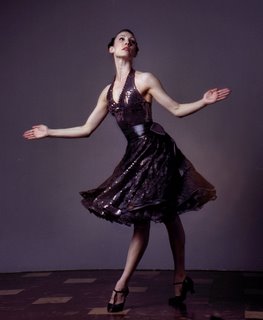
For the first time in many years I was worried, not sure of what I was going to do. What kept me going was the realization that I would have Simone Orlando, all to myself in my studio. No matter how close you sit at a Ballet BC performance or how powerful your binoculars may be, having Orlando in front of you a foot or two away has no comparison. Orlando began to explain what the dance was all about. I had been denied the opportunity to watch a rehearsal. I had nothing to go on. Orlando told me that in this dance she was sort of a Fascist and her moves were un-ballet, quite rigid and soldier-like, but here is the catch, from the waist down her beautiful dark sequined skirt would swirl with the movement. I was to catch both. Then Orlando used a word I have never heard before, "The picture must not be balletic." I asked for clarification. It seemed that the image she had in mind (as well as Kudelka's mind) was a picture that did not show a dancer in graceful flight, all perfect form. I warmed to the idea immediately!
To take the picture you see here I exposed 10 frames of 120 Ektachrome 100G. I set my exposure at between f-11 and f-16 knowing that if I set my shutter at 1/2 second, the quartz modeling light of my 3x4 ft softbox would cast enough light to expose the film and blur the skirt. I put a piece of tape on the floor and Orlando moved to the position while I pressed the shutter. Just in case I shot a roll of colour negative which gives more allowance for exposure error. Orlando's favourite from that roll is here. The colour and the look is different from the slide.
I was not entirely alone with Simone Orlando in my studio. We had Ballet BC wardrobe manager, Kate Burrows who brought Orlando a new pair of shoes and did last minute alterations of that sequined dress. With the guidance of the two women I was bound to succeed. I managed to catch the elusive Kudelka backstage (God to many in the ballet world). God spoke, "Alex you got some movement in that photograph."
Mario Hertzberg The Jew & Bishop Richard Williamson
Thursday, February 26, 2009

On April 7, 2007, Holy Saturday, I wrote part of what is below here. I reflected on those words tonight (I am writing this, late Wednesday). I had left much unsaid. I knew I had to somehow correct my mistake of omission. My friend Mark Budgen and I have been following via e-mail, he by the web-based Manchester Guardian, me by the on-line Argentine La Nación, the events that culminated with the expulsion,a couple of days ago, from Argentina of Bishop Richard Williamson a fervent denier of the Holocaust.
Perhaps my grandmother would have been shocked at it all or perhaps her anti-Semitic stance was only a Spanish 19th century upbringing. On Good Fridays, In Buenos Aires around the late 40s, and the beginning of the 50s I was not allowed to turn on the radio and at 3 pm we would kneel on the living room floor in our Coghlan home and she would take us through the Stations of the Cross in Latin. I distinctly remember her telling me how the evil Jews had crucified Him. When describing people's faces she would sometimes say, "She has the map of Jerusalem on her face." Or she would switch to her alternate, “Es un paisano de Jesucristo,” "He is one of Jesus' countrymen."
But she never ever uttered a critical word about my best friend who lived across the street on Melián 2779. He was Mario Hertzberg. He, Miguelito (I have long forgotten his Calabrian surname) and I were inseparable and we were known as the inglesito (the English boy) el tano (the Italian) and el judío (the Jew).
Mario had two brothers but he once showed me the photograph of a third who looked much the same as he did except he was fatter and wore glasses. "That was my older brother but he died at a place called Auschwitz." At age 8 I did not have enough curiousity to pursue the subject any further.
One day Mario and I went to see a Tarzan movie at the Saturday series sponsored by our local Capuchin monks who were building a very large new church next door to the little community center and movie house. They charged us a token fee but we knew our money was going to a good cause. As we left after the show we were approached by a chubby Capuchin who asked us our names. He asked me to what church I went to. When he questioned Mario, Mario replied, "I don't go to church I am a Jew." I will never forget the Capuchin’s smile as he placed his hand on Mario's arm and told us, "We share the same God and that is what is important." I thought about that for the rest of the day but I never confronted my grandmother with what to me was a clear difference of opinion.
I lost track of Mario Hertzberg when I was 21.
When I wrote the above I was candid to a point. But I did not elaborate. I had returned to Argentina from my home in Mexico to do my military service. This was the reason I had given my mother. The real reason was that I was going to search for my father whom my mother and grandmother had abandoned some ten years before in 1954, with me in tow, because he had become an impossible alcoholic. I felt a pull for my father and for Buenos Aires. I was an impossible romantic and I talked about “my country” and “my land.” My father was part of that landscape, the Argentine pampa.
When I arrived to Buenos Aires I searched for Mario in the hopes that he might know my father’s whereabouts. I was immediately offered the hospitality of his home. He still lived on Melián 2779 in Coghlan. His father had died. I was greeted warmly by his mother. Mario had a beautiful girlfriend who looked exactly like Susan Strasberg. While I was being enrolled into the Argentine Navy, I had some time to search for my father. Mario told me had spotted him walking the nearby street of Monroe near the Pirovano Hospital. A couple of times my father had approached Mario and asked him if he knew where I had been taken to. In the end I did locate my father and that is a story I have told before in another posting.
I remember my bed at Mario’s. It had an under sheet and above me was a large heavy duvet. I had never seen or slept under one before. Mrs. Hertzberg told me I could stay for as long as I wanted until I found a place or, worse, was sent to some remote naval base, and, even worse, some antiquated tin can like the battleship General Belgrano.
In the interim I had contacted the Irish branch of my family, the O’Reilly’s and the English branch, the Haywards. My uncle Freddy Hayward, after much persistent nagging on my part, told me that my father had approached him for information on me, “I gave him some money and sent him away.”
Inesita O’Reilly, my godmother and first cousin offered her home for me to stay until my boarding situation was solved. I recall that one of my nephews said something like, “You cannot possibly want to stay in that house with that Jew.” I remember to my embarrassment that I said nothing. One day during the afternoon I left Mario’s house with all my belongings. I did not leave a note. As my grandmother would have said, “Te despediste a la francesa,” or you left without saying goodbye. To this day the Spanish use this expression in commemoration of the hasty retreat of the French army when Wellington’s troops entered Spain. I never saw Mario again. Or at least that's the way I would like to remember it.
One year later, when I was getting off a train in Retiro (I was in uniform) I spotted Mario and he recognized me. I turned around and left the train by another door.
Four years before I had argued with many who confronted me with the news that Adolf Eichmann had been captured and then kidnapped by Israeli agents in 1960.
Eichmann was apprehended by a team of Mossad and Shabak agents in a suburb of Buenos Aires on May 11, 1960, as part of a covert operation. The Mossad agents had arrived in Buenos Aires in April 1960 after Eichmann's identity was confirmed. After observing Eichmann for an extensive period of time, a team of Mossad agents waited for him as he arrived home from his work as foreman at a Mercedes Benz factory. One kept lookout waiting for his bus to arrive while two agents pretended to be fixing a broken down car. An unconfirmed fourth would ride on the bus to make sure he would leave. Once Eichmann alighted and began walking the short distance to his home, he was asked by the agent at the car, Zvi Aharoni, for a cigarette. When Eichmann reached in his pocket he was set upon by the two by the car. Eichmann fought but team member Peter Malkin, a Polish Jew and a black belt in karate, knocked Eichmann unconscious with a strike to the back of his neck and bundled him into the car and took him to the safe house. In the safe house a preliminary interrogation was conducted and it was proved that Klement (Clement) was undoubtedly the Nazi Eichmann.
I argued up and down that no matter how heinous his crimes, Eichmann was an Argentine citizen and the Israelis had denied him due process. My friends looked at me in horror. I remember telling them that the world was black or white and gray did not exist. Things were either this way or that way and the law was the law.
My only excuse now is probably an indefensible and distorted impetuosity of youthful idealism blended with out and out ignorance.
In the picture above, taken on my birthday on August 31st, 1951, the little boy in darkness on the left is Mario. That's me in the centre in the front row and my father is in the back.
Mario, even if it is far too late, I am sorry.
Wednesday, February 25, 2009
"Use a Butterfly?" Child said.
"No. Mark V."
"Fast or slow?"
"Fast, "Coen said "Where do you hit?"
"At home. I hate the clubs."
Blue Eyes, Jerome Charyn, 1973
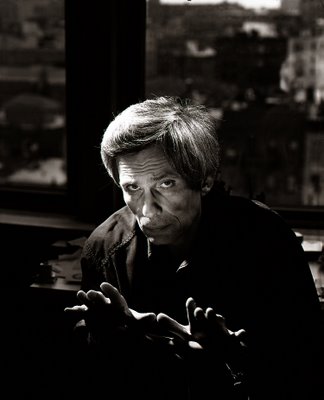
There is only one sport I ever excelled at. When I played it, it had the lowly name of ping-pong. Bats where called racquets and they came in two types, sandpaper or a thin rubber surface on both sides. By the time I was really good at table tennis, my bat was a Butterfly with a thick layer of spin-inducing foam, I had to worry about making ends meet. I abandoned the sport. But I have kept hidden in my small repertoire of talents a mean slam that I can pick up with the ball barely over the table and direct it to the opposite side of wherever my opponent might be standing.
I learned to play at St Ed’s in the late 50s and most of my bag of tricks came courtesy of a Hungarian classmate, Istvan Rozanich, whom I always managed to defeat. He would lose his cool. Pin-pong is all about not losing your cool. I would precipitate the situation by taunting him, "ro-sunof-a-beech."
In 1966 on board an Argentine merchant marine Victory ship for three months I learned to play the sport at a table that pitched during equatorial storms. It put the finishing touch on my slam and improved my dancing. Dancing can be helpful in playing the game.
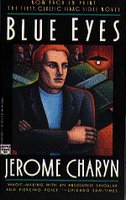
Perhaps my affinity to the game lured me into reading the Issac novels of Newyorican author Jerome Charyn, above. Who but Charyn (a table tennis shark) would ever write a novel, Blue Eyes, about a NY plainclothes cop, Coen, with beautiful blue eyes and a mean chop with his Mark V bat? Who else but Charyn would have his tragic protagonist gunned down while playing the game in a ping-pong club of ill repute?
All the Chinaman got from Coen was grief. “Draw on me Polish. Show me who you are. You have a trigger. Just move your right hand.” Coen held on to the Mark V. He smiled into the Chinaman’s face. Measuring Coen’s smile, the Chinaman understood that there would be no satisfactions for him this far uptown, and he gripped the Police Special with both hands, conceived a target in his head a good three feet around Coen, and fired into the target. The bat jumped over the Chinaman’s ears. Coen felt a crunch from his teeth down through his groin and into the pit of his legs. He tasted blood behind his nose. His shoes were in his face. He couldn’t determine how he had gotten from the table to the wall. He was thirsty now. He remembered a peach he had bought during maneuvers in Worms, a giant red peach, a “colorado” for which he paid the equivalent of fifty cents, because the fruitman swore to him in perfect English that the “colorado” had come from South America in a crib of ice. Coen scrubbed the peach in canteen water, his fingers going over the imperfections in the red and yellow fuzz. He cut into the fuzz with his pack knife, finding it incredible that a peach, whatever its nationality, should have wine-colored flesh all around the stone. He ate for half an hour, licking juice from his thumbs, prying slivers of fruit out of the stone, savoring his own sweet spit. There was blood in his ear when he tried to swallow. His eyes turned pink. His chin was dark from bubbles in his mouth. Only one of his nostrils pushed air.
Blue Eyes, Jerome Charyn, 1973
What does ping-pong mean to Jerome Charyn? In his Sizzling Chops & Devilish Spins – Ping-Pong And The Art Of Staying Alive (2001) he writes:

“Whenever I find myself growing grim about the mouth; whenever it is a damp drizzly November in my soul,” writes Melville in Moby Dick, “I account it high time to get to sea as soon as I can.” But I’m not a sailor and I can’t even swim. When I feel my own damp November, I grab my sports bag and rush to the Bastille, where my ping-pong club is located, on a little side street. I represent the subway workers of Paris and their gathering of clubs, Union Sportive du Metro. I play in a little league, against aggressive youngsters who have a serve that’s so wicked, I can barely see the ball. But it doesn’t matter. My own special racquet is like a samurai’s blade, masked with soft rubber pimples that’s called a picot. I can neutralize some of the youngsters, who can’t seem to solve the riddle of my bat. Others tear right through the soft rubber mask. But it’s a curious sport, were graybeards like myself can compete against the young killer sharks and sometimes win. I live for the sound of the ball, the pock my racquet makes while I bend my skinny knees. The fierce concentration pulls me into the fabric of a whirlwind. I dance. I dream.
In the day that I spent with Jerome Charyn in New York some years ago I learned from him that New Yorkers aren't, but Newyoricans are. He taught me to pour a bit of decent balsamic vinegar on a bowl of blackberries and vanilla ice cream. I found out that he liked to put Roumanians (his spelling) into his novels because he had once lived in a building with many Roumanians. But I was never able to rustle up enough nerve to challenge him to a game of ping-pong. Had I, I would probably not be alive to write this.
more Jerome Charyn
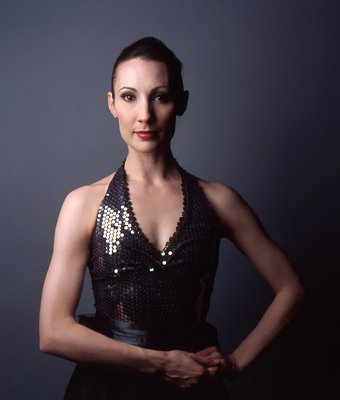
Amidst all the attention given to the sciences as to how they can lead to the cure of all diseases and daily problems of mankind, I believe that the biggest breakthrough will be the realization that the arts, which are conventionally considered "useless," will be recognized as the whole reason why we ever try to live longer or live more prosperously. The arts are the science of enjoying life.
John Maeda
Muriel Cooper professor of media arts and sciences at the Media Laboratory of the Massachusetts Institute of Technology.
In the last few weeks I have come to understand my failure as a parent. I can use as an excuse the ignorance of youth or the stress of having to find work to explain this failure. I have come to understand that to teach our children an appreciation for the arts, of culture; to inculcate reading habits and a desire to take on challenging pursuits are the responsibility of parents and not of our schools, our government or our media. Schools, governments and the media can only reinforce.
As soon as we arrived to Vancouver in 1975 Rosemary and I made sure that our two daughters Ale and Hilary had swimming, skating and skiing lessons. We suggested and ultimately forced both girls to take ballet lessons at the Vancouver School of Music and we further insisted that Ale take guitar lessons. When Ale wanted to quit her ballet and her guitar we told her she could only quit one of them. She quit her ballet. Their teacher was a martinet who only catered to the students she thought had talent and a potential career in ballet. The woman’s attitude poisoned our two daughter’s appreciation for ballet forever. This does not mean that we didn’t try. Every time a renowned foreign ballet or modern dance company came to town we took the girls. Only one performance remains in my memory and that was Revelations by the Alvin Ailey Dance Company. The black troupe appeared on stage in dazzling all-white costumes and parasols. The rest of the dance companies that came to Vancouver are a blur.
I never invited my daughters to accompany me to classical or baroque concerts. I rarely took them to theatre. My contribution to their “culture” was a curtailment of their TV viewing time although I permitted them to watch Gilligan’s Island as I loved that program, too. I left in a huff (to punk concerts at the Smiling Buddha) when Rosemary and the girls would watch the Oscars, Dallas or Dynasty. My eldest daughter could identify Art Bergmann, the Subhumans and DOA but would probably not recognize the Brandenburg Concertos as such. I was so proud of Ale in relation to the former (the punks) that overlooked the balancing of her education with the latter.
We sent our daughters abroad to help them keep their Spanish fluency. But we did not pursue further cultural diversity even though both girls attended and ultimately finished their high school studies in French Immersion.
It is my belief that I never transferred to them my passion for reading and an interest in jazz, classical and varied music. I was not even able to interest them in photography. Ale, has only in the last 10 years come to share our interest in heavy duty gardening.
I took my girls to ballet and modern dance because I felt it was my responsibility as a father of two girls. I was not remotely interested in dance of any kind.
This all changed sometime around 1995 when I first saw, noticed and fell madly in love with Evelyn Hart. Suddenly I was interested in ballet and in most dance (although I have always excluded tap dancing except when it is Gene Kelley or Fred Astaire in an American musical). I began to explore dance in all its forms in Vancouver. I found there were many dance companies with a varied repertoire. I found out that choreographers like Judith Garay had a bit of Martha Graham in her including a love for swirling and blurring fabric. I actually made an effort, because I was suddenly interested, to find out who Graham had been.
With Ballet BC performances I watched the exciting transition when a brand new artistic director, John Alleyne, slowly and surely dragged his company from 19th century ballet and its swans to the modern repertoire. He choreographed new modern dance performances which broke ground and introduced Vancouver audiences (so lazy for change) to choreographers like William Forsythe and Serge Bennathan.
But there was another choreographer, then artistic director of the National Ballet of Canada, James Kudelka’s 15 Heterosexual Duets that made my head turn and finally make me an unabashed fan of dance. These duets (as danced by dancers of Ballet BC in several remountings of this work) featured 8 couples showing the variety, delights and conflicts of human love and interaction. One of the dances featured a woman with long hair (except once when Alleyne cast Acacia Schachte, a short-haired woman in the part!) who in her movements with her male partner magically swirled her hair swirled not unlike (but please discount my crass comparison!) a very good TV shampoo commercial. Kudelka in this particular duet had almost played God and choreographed hair to his bidding!
I had Ballet BC dancer Simone Orlando in my studio on Saturday. I had been commissioned by the Straight to take her picture for this Thursday in anticipation of her performance of James Kudelka’s The Goldberg Variations – Side 2: Adam & Eve & Steve. She put on a wonderful dress. You cannot see all of it here as it is good editorial manners not to place a picture in this blog that will appear in a magazine on Thursday. In magazine parlance it's called "first rights". The picture here is a different one.
Orlando explained that this dance has her moving almost in a jerky mechanical manner from the waist up, while her flared skirt swirls below. Shades of those wonderful 15 Heterosexual Duets?
The excitement in my anticipation of watching the premiere performance of this dance this Thursday can only be marred by the possible disappointment if Rebecca (11) refuses to accompany me. I can only hope that her mother, my daughter, might just find out soon that the curtailment of TV (computer time, etc) while important is not all if we are to strive to a balanced and rich education for our children. What is important is for us to first become interested and by example to transfer our interest, and who knows, maybe even our passion, to our children. Only when that happens will our Ballet BC, our VSO, our Pacific Baroque Orchestra, our various dance companies and theatre companies, the Vancouver Opera and our many art galleries really be open for business. It is only then when our children (and not only this old man, but at least and at long last) will be positively thrilled at having a real live shimmering ballerina like Simone Orlando in my studio or going to see them backstage. Those who practice the arts in our Vancouver should rightfully be our idols and heroes. They are idols and heroes with no need for red carpets.
But they are in need of our acknowledgment and our support.
"Use a Butterfly?" Child said.
"No. Mark V."
"Fast or slow?"
"Fast, "Coen said "Where do you hit?"
"At home. I hate the clubs."
Blue Eyes, Jerome Charyn, 1973

There is only one sport I ever excelled at. When I played it, it had the lowly name of ping-pong. Bats where called racquets and they came in two types, sandpaper or a thin rubber surface on both sides. By the time I was really good at table tennis, my bat was a Butterfly with a thick layer of spin-inducing foam, I had to worry about making ends meet. I abandoned the sport. But I have kept hidden in my small repertoire of talents a mean slam that I can pick up with the ball barely over the table and direct it to the opposite side of wherever my opponent might be standing.
I learned to play at St Ed’s in the late 50s and most of my bag of tricks came courtesy of a Hungarian classmate, Istvan Rozanich, whom I always managed to defeat. He would lose his cool. Pin-pong is all about not losing your cool. I would precipitate the situation by taunting him, "ro-sunof-a-beech."
In 1966 on board an Argentine merchant marine Victory ship for three months I learned to play the sport at a table that pitched during equatorial storms. It put the finishing touch on my slam and improved my dancing. Dancing can be helpful in playing the game.

Perhaps my affinity to the game lured me into reading the Issac novels of Newyorican author Jerome Charyn, above. Who but Charyn (a table tennis shark) would ever write a novel, Blue Eyes, about a NY plainclothes cop, Coen, with beautiful blue eyes and a mean chop with his Mark V bat? Who else but Charyn would have his tragic protagonist gunned down while playing the game in a ping-pong club of ill repute?
All the Chinaman got from Coen was grief. “Draw on me Polish. Show me who you are. You have a trigger. Just move your right hand.” Coen held on to the Mark V. He smiled into the Chinaman’s face. Measuring Coen’s smile, the Chinaman understood that there would be no satisfactions for him this far uptown, and he gripped the Police Special with both hands, conceived a target in his head a good three feet around Coen, and fired into the target. The bat jumped over the Chinaman’s ears. Coen felt a crunch from his teeth down through his groin and into the pit of his legs. He tasted blood behind his nose. His shoes were in his face. He couldn’t determine how he had gotten from the table to the wall. He was thirsty now. He remembered a peach he had bought during maneuvers in Worms, a giant red peach, a “colorado” for which he paid the equivalent of fifty cents, because the fruitman swore to him in perfect English that the “colorado” had come from South America in a crib of ice. Coen scrubbed the peach in canteen water, his fingers going over the imperfections in the red and yellow fuzz. He cut into the fuzz with his pack knife, finding it incredible that a peach, whatever its nationality, should have wine-colored flesh all around the stone. He ate for half an hour, licking juice from his thumbs, prying slivers of fruit out of the stone, savoring his own sweet spit. There was blood in his ear when he tried to swallow. His eyes turned pink. His chin was dark from bubbles in his mouth. Only one of his nostrils pushed air.
Blue Eyes, Jerome Charyn, 1973
What does ping-pong mean to Jerome Charyn? In his Sizzling Chops & Devilish Spins – Ping-Pong And The Art Of Staying Alive (2001) he writes:

“Whenever I find myself growing grim about the mouth; whenever it is a damp drizzly November in my soul,” writes Melville in Moby Dick, “I account it high time to get to sea as soon as I can.” But I’m not a sailor and I can’t even swim. When I feel my own damp November, I grab my sports bag and rush to the Bastille, where my ping-pong club is located, on a little side street. I represent the subway workers of Paris and their gathering of clubs, Union Sportive du Metro. I play in a little league, against aggressive youngsters who have a serve that’s so wicked, I can barely see the ball. But it doesn’t matter. My own special racquet is like a samurai’s blade, masked with soft rubber pimples that’s called a picot. I can neutralize some of the youngsters, who can’t seem to solve the riddle of my bat. Others tear right through the soft rubber mask. But it’s a curious sport, were graybeards like myself can compete against the young killer sharks and sometimes win. I live for the sound of the ball, the pock my racquet makes while I bend my skinny knees. The fierce concentration pulls me into the fabric of a whirlwind. I dance. I dream.
In the day that I spent with Jerome Charyn in New York some years ago I learned from him that New Yorkers aren't, but Newyoricans are. He taught me to pour a bit of decent balsamic vinegar on a bowl of blackberries and vanilla ice cream. I found out that he liked to put Roumanians (his spelling) into his novels because he had once lived in a building with many Roumanians. But I was never able to rustle up enough nerve to challenge him to a game of ping-pong. Had I, I would probably not be alive to write this.
more Jerome Charyn
James Kudelka's Shimmering Swirls & Simone Orlando Obliges
Tuesday, February 24, 2009

Amidst all the attention given to the sciences as to how they can lead to the cure of all diseases and daily problems of mankind, I believe that the biggest breakthrough will be the realization that the arts, which are conventionally considered "useless," will be recognized as the whole reason why we ever try to live longer or live more prosperously. The arts are the science of enjoying life.
John Maeda
Muriel Cooper professor of media arts and sciences at the Media Laboratory of the Massachusetts Institute of Technology.
In the last few weeks I have come to understand my failure as a parent. I can use as an excuse the ignorance of youth or the stress of having to find work to explain this failure. I have come to understand that to teach our children an appreciation for the arts, of culture; to inculcate reading habits and a desire to take on challenging pursuits are the responsibility of parents and not of our schools, our government or our media. Schools, governments and the media can only reinforce.
As soon as we arrived to Vancouver in 1975 Rosemary and I made sure that our two daughters Ale and Hilary had swimming, skating and skiing lessons. We suggested and ultimately forced both girls to take ballet lessons at the Vancouver School of Music and we further insisted that Ale take guitar lessons. When Ale wanted to quit her ballet and her guitar we told her she could only quit one of them. She quit her ballet. Their teacher was a martinet who only catered to the students she thought had talent and a potential career in ballet. The woman’s attitude poisoned our two daughter’s appreciation for ballet forever. This does not mean that we didn’t try. Every time a renowned foreign ballet or modern dance company came to town we took the girls. Only one performance remains in my memory and that was Revelations by the Alvin Ailey Dance Company. The black troupe appeared on stage in dazzling all-white costumes and parasols. The rest of the dance companies that came to Vancouver are a blur.
I never invited my daughters to accompany me to classical or baroque concerts. I rarely took them to theatre. My contribution to their “culture” was a curtailment of their TV viewing time although I permitted them to watch Gilligan’s Island as I loved that program, too. I left in a huff (to punk concerts at the Smiling Buddha) when Rosemary and the girls would watch the Oscars, Dallas or Dynasty. My eldest daughter could identify Art Bergmann, the Subhumans and DOA but would probably not recognize the Brandenburg Concertos as such. I was so proud of Ale in relation to the former (the punks) that overlooked the balancing of her education with the latter.
We sent our daughters abroad to help them keep their Spanish fluency. But we did not pursue further cultural diversity even though both girls attended and ultimately finished their high school studies in French Immersion.
It is my belief that I never transferred to them my passion for reading and an interest in jazz, classical and varied music. I was not even able to interest them in photography. Ale, has only in the last 10 years come to share our interest in heavy duty gardening.
I took my girls to ballet and modern dance because I felt it was my responsibility as a father of two girls. I was not remotely interested in dance of any kind.
This all changed sometime around 1995 when I first saw, noticed and fell madly in love with Evelyn Hart. Suddenly I was interested in ballet and in most dance (although I have always excluded tap dancing except when it is Gene Kelley or Fred Astaire in an American musical). I began to explore dance in all its forms in Vancouver. I found there were many dance companies with a varied repertoire. I found out that choreographers like Judith Garay had a bit of Martha Graham in her including a love for swirling and blurring fabric. I actually made an effort, because I was suddenly interested, to find out who Graham had been.
With Ballet BC performances I watched the exciting transition when a brand new artistic director, John Alleyne, slowly and surely dragged his company from 19th century ballet and its swans to the modern repertoire. He choreographed new modern dance performances which broke ground and introduced Vancouver audiences (so lazy for change) to choreographers like William Forsythe and Serge Bennathan.
But there was another choreographer, then artistic director of the National Ballet of Canada, James Kudelka’s 15 Heterosexual Duets that made my head turn and finally make me an unabashed fan of dance. These duets (as danced by dancers of Ballet BC in several remountings of this work) featured 8 couples showing the variety, delights and conflicts of human love and interaction. One of the dances featured a woman with long hair (except once when Alleyne cast Acacia Schachte, a short-haired woman in the part!) who in her movements with her male partner magically swirled her hair swirled not unlike (but please discount my crass comparison!) a very good TV shampoo commercial. Kudelka in this particular duet had almost played God and choreographed hair to his bidding!
I had Ballet BC dancer Simone Orlando in my studio on Saturday. I had been commissioned by the Straight to take her picture for this Thursday in anticipation of her performance of James Kudelka’s The Goldberg Variations – Side 2: Adam & Eve & Steve. She put on a wonderful dress. You cannot see all of it here as it is good editorial manners not to place a picture in this blog that will appear in a magazine on Thursday. In magazine parlance it's called "first rights". The picture here is a different one.
Orlando explained that this dance has her moving almost in a jerky mechanical manner from the waist up, while her flared skirt swirls below. Shades of those wonderful 15 Heterosexual Duets?
The excitement in my anticipation of watching the premiere performance of this dance this Thursday can only be marred by the possible disappointment if Rebecca (11) refuses to accompany me. I can only hope that her mother, my daughter, might just find out soon that the curtailment of TV (computer time, etc) while important is not all if we are to strive to a balanced and rich education for our children. What is important is for us to first become interested and by example to transfer our interest, and who knows, maybe even our passion, to our children. Only when that happens will our Ballet BC, our VSO, our Pacific Baroque Orchestra, our various dance companies and theatre companies, the Vancouver Opera and our many art galleries really be open for business. It is only then when our children (and not only this old man, but at least and at long last) will be positively thrilled at having a real live shimmering ballerina like Simone Orlando in my studio or going to see them backstage. Those who practice the arts in our Vancouver should rightfully be our idols and heroes. They are idols and heroes with no need for red carpets.
But they are in need of our acknowledgment and our support.
Monday, February 23, 2009
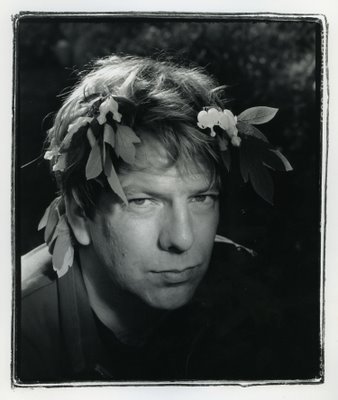
Vancouver has always been a frigid place even during those rare days of stifling heat in August. Water from the tap is always very cold (cold in spite of its purity) and Vancouverites are just as cold, too. After many years of living in Mexico City where people hug you or in Buenos Aires where those who you hardly know kiss you, Vancouver is a downer into the cold.
In my 35 years in Vancouver I have rarely experienced out-and-out passion from those who live here. I remember the few times I talked to Alderman Harry Rankin that here was a man with a loud purpose who had passion for what he did. Most of the rest remind me of a Miles Davis muted trumpet.
It is that same kind of Harry Rankin passion that I have always felt present at the many live Art Bergmann concerts that through the years I have been so fortunate to attended. Unlike Johnny Thunders, Bergmann was a bit kinder with himself. Some of us went to to Johnny Thunders gigs to see if in that particular night he would make his final exit by that chemical high road. Not so with Art. Bergmann may have been loaded at some concerts but he always delivered all he could. All he could was always much more than just about anybody else could deliver stone sober. And then there were those nights when Bergmann would have broken guitar strings. I always knew they would be the best.
I have received several e-mails advising me that Art Bergmann (who has terrible bouts of rheumatoid arthritis) will be in town from his new home in Alberta. He will be playing on Richards on Richards, Thursday, March 26. Do I want to wait until late in the evening to listen to this man play?
On another Thursday, this coming one, I will be attending a sophisticated performance of Ballet BC's Carmen choreogrpahed by Jean Grand-Maitre and James Kudelka's The Goldberg Variations - Side 2: Adam & Eve & Steve. I am sure that I will we wowed by the cool passion of Simone Orlando and the brilliance of Kudelka's choreography. It will be a pleasant evening at the ballet that will lead towards a fireworks finale just a few blocks away a month later. I have a suspicion that if I show up at Richards on Richards and I stare at Art Bergmann enough he just might play and extra fast (and very loud) Data Redux.

And that would be sizzling passion, passion from the heart, at its best.
"video of Goldberg Variations rehearsal Courtesy of Vancouver Sun
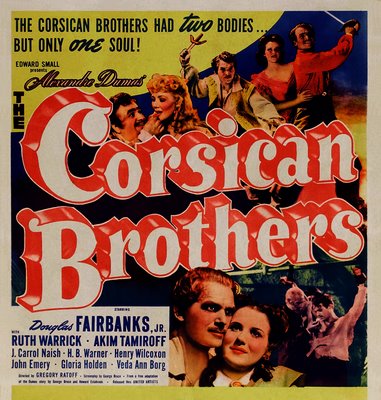
Yesterday afternoon Ballet BC dancer and choreographer, Simone Orlando faced my camera in my studio. I had my light very close and to one side. The dark side of her face had a luminous triangle of light underneath her eye. This triangle is the essence of Rembrandt lighting. That patch of light, in conjunction with her face, was magic.
Today is Oscar night and our family had an Oscar tradition for many years. It was an evening when my two daughters and Rosemary would go down to the basement (the place where for a long time I exiled our family TV) and watch the Oscars. I was never interested much in listening to actors thank their mothers. I enjoyed not being part of the group. At the same time I could discern a lovely bond among the three women. When Rebecca was born, 11 years ago, all it meant is that the three girls eventually became four. It changed further when Ale, my oldest daughter moved to Lillooet two years ago. I also brought our TV up from the cold into our den. Oscar night became Oscar night at Hilary’s. This involved the addition of yet another girl, Hilary’s mother-in-law.
Today it is even more different as my son-in-law will be there. Does he not know? Rosemary was almost listless about going. As we watch more films in the Turner Classic Movie channel she has even said to me, “I don’t even know who many of those actors and actresses who are nominated are." We both miss Ale.
At lunch today after her piano lessons Rebecca said, “Robert Pattinson is going to be present at the Oscars." Even though I had seen the film Twilight with Rebecca I had no idea who he was. Neither did Rosemary.
On Saturday I told Rosemary to call up Rebecca and ask her if she would want to be my assistant in my studio date with Simone Orlando. Rebecca politely declined, “No, I am going to play outside.”
A couple of years ago I took Rebecca back stage after a performance of Ballet BC. We were met by Simone Orlando who took Rebecca to her dressing room. Rebecca emerged some time later with a pair of Orlando’s point shoes. Rebecca was thrilled. My guess is that she must have placed them under her pillow that night.
I mulled over the above all day today and arrived at a conclusion.
One of the most lasting memories of my childhood (I was 8 or 9) is an image of Douglas Fairbanks Jr. (I did not know it was Fairbanks at the time nor did I care) galloping in pursuit in Los Hermanos Corso (the Corsican Brothers). His face crept up in The Prisoner of Zenda and that wonderful film (one of Rebecca’s favourites) the 1939 Gunga Din with Douglas Fairbanks Jr, Cary Grant, Victor McLaglen and Joan Fontaine.
I remember drinking Toddy, the great Argentine powdered chocolate with my milk because in the Toddy-sponsored radio program Tarzán Rey de la Jungla which I listened to without fail every week Tarzan told us we could grow up to be strong like he was if we had it three times a day.
I was completely overwhelmed in admiration of Randolph Scott when I saw Colt .45. I saw him in the film because my grandmother loved westerns and we would go and see a string of them (until our stomachs ached) on Avenida Lavalle. It was from my mother that I heard first hand who these actor and actresses were, Douglas Fairbanks Jr, Ronald Colman (“His wonderful voice, Alex, his wonderful voice in A Tale Of Two Cities!”), Gary Cooper in Beau Geste, Orson Welles in The Third Man, Humphrey Bogart in Casablanca and the Maltese Falcon, Leslie Howard in Romeo and Juliet, Vivien Leigh in Gone With the Wind, the two sisters, Olivia de Havilland and Joan Fontaine, Ralph Richardson in The Four Feathers, James Mason in The Desert Fox and 5 Fingers. I appreciated all her stories and I agreed with her preferences until she took me to see a film with Katherine Hepburn (who wore pants) and I found myself being confused and repelled. Then my mother placated me with The African Queen and I didn’t find her as scary. Through the years I have never confused the role that Gary Cooper played (ah! that romantic troofer of the French Foreign Legion) with his role as a film actor.
When it came to playing in the garden with my friends with our wooden swords, toy guns and rifles I found that I wasn’t really Douglas Fairbanks Jr, or Johnny Weissmuller of Randolph Scott. I was the characters they played in those films. I was the good Corsican twin, Tarzan, the cowboy with the loud Colt .45s, and Captain Blood not Louis Hayward. My concept of celebrity was limited as we had no TV and I read no magazines or newspapers. My concept of celebrity came from the stories my father and my mother told me. My mother told me of meeting up with Einstein at Princeton. She told me of being on the same ship as the electrical genius Steinmetz. She told me of a crazed piano player of the 20s called Moskosky. I was 6 when, while combing my hair, she told me my hair was like Hitler’s. “Who’s Hitler?” I asked. “A very bad man, “she answered.
My idea of celebrity was connected to what these celebrities did. Fairbanks was an espadachín (swordsman), Scott was a cowboy, Lois Hayward was a dashing pirate. I wanted to be an espadachín, a cowboy, a dashing pirate or a soldier like John Wayne.
The difference then between my concept of celebrity and Rebecca’s is that she does not want to do what Lindsay Lohan might want to do in a film, or be who Lindsay Lohan is in a film. Rebecca wants to be like Lindsay Lohan (the Lohan of celebrity magazines and TV programs) or even Lindsay Lohan herself. For Rebecca the celebrity is the person herself and not the role.
This means that Rebecca at age 11 does not associate with or want to be a ballet dancer like Simone Orlando, or a young pianist (she studies the piano) she might have seen on a program, or be a young female doctor working in Africa or be a hot young tennis player playing in the Australian Open. She doesn't even want to be actress. This is because in the celebrity age we live in she wants to be just the celebrity. there is to be no consideration of the role of that celebrity, be it an actress, athlete, scientist etc.
I may be off the mark when I equate Rebecca playing the computer game of dressing up celebrity girls and women with the game of playing being a celebrity who is dressing up for an Oscar night.
The aches and pains of endless rehearsals of a ballet dancer are too far from the idea of celebrity. When Simone Orlando was in my studio I could admit she was beautiful, intelligent and a super star of ballet. It was not important to me. What was important was that she is a ballerina. She has a skill that takes effort and time to achieve. Perhaps like Rebecca I don't think of all that effort. I think of the magic of being a ballerina, of being a dancer. It's not about Randolph Scott being a actor that acts. It's about Scott being the cowboy. It is about Simone Orlando being a dancer not a dancer who happens to dance. It is almost as if I could dream of riding that horse like Douglas Fairbanks Jr. I could somehow be Orlando's partner in a ballet in another time and place. Has our celebrity world dampened our ability to dream?
There are no more soldiers, swordsmen, cowboys, and private eyes. There are no more Pavlovas and Artur Rubensteins. There are celebrities and us.
And put another way I am into the dancer that is Simone and not as much into Simone the dancer.

Vancouver has always been a frigid place even during those rare days of stifling heat in August. Water from the tap is always very cold (cold in spite of its purity) and Vancouverites are just as cold, too. After many years of living in Mexico City where people hug you or in Buenos Aires where those who you hardly know kiss you, Vancouver is a downer into the cold.
In my 35 years in Vancouver I have rarely experienced out-and-out passion from those who live here. I remember the few times I talked to Alderman Harry Rankin that here was a man with a loud purpose who had passion for what he did. Most of the rest remind me of a Miles Davis muted trumpet.
It is that same kind of Harry Rankin passion that I have always felt present at the many live Art Bergmann concerts that through the years I have been so fortunate to attended. Unlike Johnny Thunders, Bergmann was a bit kinder with himself. Some of us went to to Johnny Thunders gigs to see if in that particular night he would make his final exit by that chemical high road. Not so with Art. Bergmann may have been loaded at some concerts but he always delivered all he could. All he could was always much more than just about anybody else could deliver stone sober. And then there were those nights when Bergmann would have broken guitar strings. I always knew they would be the best.
I have received several e-mails advising me that Art Bergmann (who has terrible bouts of rheumatoid arthritis) will be in town from his new home in Alberta. He will be playing on Richards on Richards, Thursday, March 26. Do I want to wait until late in the evening to listen to this man play?
On another Thursday, this coming one, I will be attending a sophisticated performance of Ballet BC's Carmen choreogrpahed by Jean Grand-Maitre and James Kudelka's The Goldberg Variations - Side 2: Adam & Eve & Steve. I am sure that I will we wowed by the cool passion of Simone Orlando and the brilliance of Kudelka's choreography. It will be a pleasant evening at the ballet that will lead towards a fireworks finale just a few blocks away a month later. I have a suspicion that if I show up at Richards on Richards and I stare at Art Bergmann enough he just might play and extra fast (and very loud) Data Redux.

And that would be sizzling passion, passion from the heart, at its best.
"video of Goldberg Variations rehearsal Courtesy of Vancouver Sun
Douglas Fairbanks Jr., The Oscars & Simone Orlando
Sunday, February 22, 2009

Yesterday afternoon Ballet BC dancer and choreographer, Simone Orlando faced my camera in my studio. I had my light very close and to one side. The dark side of her face had a luminous triangle of light underneath her eye. This triangle is the essence of Rembrandt lighting. That patch of light, in conjunction with her face, was magic.
Today is Oscar night and our family had an Oscar tradition for many years. It was an evening when my two daughters and Rosemary would go down to the basement (the place where for a long time I exiled our family TV) and watch the Oscars. I was never interested much in listening to actors thank their mothers. I enjoyed not being part of the group. At the same time I could discern a lovely bond among the three women. When Rebecca was born, 11 years ago, all it meant is that the three girls eventually became four. It changed further when Ale, my oldest daughter moved to Lillooet two years ago. I also brought our TV up from the cold into our den. Oscar night became Oscar night at Hilary’s. This involved the addition of yet another girl, Hilary’s mother-in-law.
Today it is even more different as my son-in-law will be there. Does he not know? Rosemary was almost listless about going. As we watch more films in the Turner Classic Movie channel she has even said to me, “I don’t even know who many of those actors and actresses who are nominated are." We both miss Ale.
At lunch today after her piano lessons Rebecca said, “Robert Pattinson is going to be present at the Oscars." Even though I had seen the film Twilight with Rebecca I had no idea who he was. Neither did Rosemary.
On Saturday I told Rosemary to call up Rebecca and ask her if she would want to be my assistant in my studio date with Simone Orlando. Rebecca politely declined, “No, I am going to play outside.”
A couple of years ago I took Rebecca back stage after a performance of Ballet BC. We were met by Simone Orlando who took Rebecca to her dressing room. Rebecca emerged some time later with a pair of Orlando’s point shoes. Rebecca was thrilled. My guess is that she must have placed them under her pillow that night.
I mulled over the above all day today and arrived at a conclusion.
One of the most lasting memories of my childhood (I was 8 or 9) is an image of Douglas Fairbanks Jr. (I did not know it was Fairbanks at the time nor did I care) galloping in pursuit in Los Hermanos Corso (the Corsican Brothers). His face crept up in The Prisoner of Zenda and that wonderful film (one of Rebecca’s favourites) the 1939 Gunga Din with Douglas Fairbanks Jr, Cary Grant, Victor McLaglen and Joan Fontaine.
I remember drinking Toddy, the great Argentine powdered chocolate with my milk because in the Toddy-sponsored radio program Tarzán Rey de la Jungla which I listened to without fail every week Tarzan told us we could grow up to be strong like he was if we had it three times a day.
I was completely overwhelmed in admiration of Randolph Scott when I saw Colt .45. I saw him in the film because my grandmother loved westerns and we would go and see a string of them (until our stomachs ached) on Avenida Lavalle. It was from my mother that I heard first hand who these actor and actresses were, Douglas Fairbanks Jr, Ronald Colman (“His wonderful voice, Alex, his wonderful voice in A Tale Of Two Cities!”), Gary Cooper in Beau Geste, Orson Welles in The Third Man, Humphrey Bogart in Casablanca and the Maltese Falcon, Leslie Howard in Romeo and Juliet, Vivien Leigh in Gone With the Wind, the two sisters, Olivia de Havilland and Joan Fontaine, Ralph Richardson in The Four Feathers, James Mason in The Desert Fox and 5 Fingers. I appreciated all her stories and I agreed with her preferences until she took me to see a film with Katherine Hepburn (who wore pants) and I found myself being confused and repelled. Then my mother placated me with The African Queen and I didn’t find her as scary. Through the years I have never confused the role that Gary Cooper played (ah! that romantic troofer of the French Foreign Legion) with his role as a film actor.
When it came to playing in the garden with my friends with our wooden swords, toy guns and rifles I found that I wasn’t really Douglas Fairbanks Jr, or Johnny Weissmuller of Randolph Scott. I was the characters they played in those films. I was the good Corsican twin, Tarzan, the cowboy with the loud Colt .45s, and Captain Blood not Louis Hayward. My concept of celebrity was limited as we had no TV and I read no magazines or newspapers. My concept of celebrity came from the stories my father and my mother told me. My mother told me of meeting up with Einstein at Princeton. She told me of being on the same ship as the electrical genius Steinmetz. She told me of a crazed piano player of the 20s called Moskosky. I was 6 when, while combing my hair, she told me my hair was like Hitler’s. “Who’s Hitler?” I asked. “A very bad man, “she answered.
My idea of celebrity was connected to what these celebrities did. Fairbanks was an espadachín (swordsman), Scott was a cowboy, Lois Hayward was a dashing pirate. I wanted to be an espadachín, a cowboy, a dashing pirate or a soldier like John Wayne.
The difference then between my concept of celebrity and Rebecca’s is that she does not want to do what Lindsay Lohan might want to do in a film, or be who Lindsay Lohan is in a film. Rebecca wants to be like Lindsay Lohan (the Lohan of celebrity magazines and TV programs) or even Lindsay Lohan herself. For Rebecca the celebrity is the person herself and not the role.
This means that Rebecca at age 11 does not associate with or want to be a ballet dancer like Simone Orlando, or a young pianist (she studies the piano) she might have seen on a program, or be a young female doctor working in Africa or be a hot young tennis player playing in the Australian Open. She doesn't even want to be actress. This is because in the celebrity age we live in she wants to be just the celebrity. there is to be no consideration of the role of that celebrity, be it an actress, athlete, scientist etc.
I may be off the mark when I equate Rebecca playing the computer game of dressing up celebrity girls and women with the game of playing being a celebrity who is dressing up for an Oscar night.
The aches and pains of endless rehearsals of a ballet dancer are too far from the idea of celebrity. When Simone Orlando was in my studio I could admit she was beautiful, intelligent and a super star of ballet. It was not important to me. What was important was that she is a ballerina. She has a skill that takes effort and time to achieve. Perhaps like Rebecca I don't think of all that effort. I think of the magic of being a ballerina, of being a dancer. It's not about Randolph Scott being a actor that acts. It's about Scott being the cowboy. It is about Simone Orlando being a dancer not a dancer who happens to dance. It is almost as if I could dream of riding that horse like Douglas Fairbanks Jr. I could somehow be Orlando's partner in a ballet in another time and place. Has our celebrity world dampened our ability to dream?
There are no more soldiers, swordsmen, cowboys, and private eyes. There are no more Pavlovas and Artur Rubensteins. There are celebrities and us.
And put another way I am into the dancer that is Simone and not as much into Simone the dancer.
Saturday, February 21, 2009

All my blogs on the Why Do I Blog? theme have featured a photograph of my granddaughter Rebecca who is now 11. This time around I have also placed a picture of her sister Lauren who is 6.
I posted my first blog, with no picture on January 20, 2006. On February 24, 2007 I wrote a blog that I projected while speaking at Northern Voice 2007, a blogging conference held at UBC. On February 23, 2008 I also spoke at Northern Voice 2008 and again projected a blog that day.
This year I will not be attending Northern Voice 2009. The conference sold out much too early and I was left out. The pleasure of chatting with like-minded souls will not come my way. I have decided to take advantage of the opportunity that this loss provides me to reflect on that initial question that I made and tried to answer back on February 24, 2007 - Why do I blog?
On that date the hot topic was Twitter. It took a couple of years for Twitter to make the mainstream. Last year cloud computing was the item of discussion in all corners of UBC's Forestry Sciences Centre where Northern Voice is held every year. In many respects this amateur blogger who does not understand the difference between Apache and Java, or what they are, knew that I was getting inside information before the hoi polloi (οἱ πολλοί) did.
But as I feel saddened by not seeing my friends this coming weekend I realize why I blog more than ever. The reasons I had before are still in effect. I want to write about my family and my granddaughters. While Rebecca (note her picture here) still looms large I have found a delightful interest in her sister Lauren. Lauren looks at me straight in the eye. I love her for it.

This blog is a safety valve for the frustrations I feel as a soon-to-be former magazine photographer and writer. I took pictures for magazines for many years and and when the market began to downturn I discovered that writing and taking pictures extended my worth just a bit more. I was paid less for the photographs and less for the writing. Adding both cheques made my earnings a bit more substantial. But that is rapidly ending when you consider that culture and the arts are now buried in our Vancouver Sun in the food section. The Vancouver Sun discourages freelance work, too. It was not too long ago that the travel editor for the Sun, after running a story I wrote about traveling with Rebecca to Argentina (the editor ran it front page with lots of pictures) told me that she didn't want to hear from me again as she had her little stable of writers.
Before I started this blog, my frustration in not being able to take pictures or to write was pushing me into a dangerous zone of bitterness. Bitterness and self-employment can be a devastating cocktail. The blog dissipated it, steam was released and I now feel much better for it. It is not important that I keep a count (I don't) on who reads or if anybody (as long as some of my family and friends do that's all that matters) reads this blog. Not having a comments section certainly diminishes the blog's chance for more popularity. But I have seen how comments have corroded away initial optimism of such good BC-based online news magazines like The Tyee. I would not want these ranters to contribute to my blog.
The blog gives me the opportunity to post pictures (I take many of them exclusively thinking of the blog) that magazines would not want to run with copy that might be too personal for mainstream magazines. In short I write about anything I want to write about and place pictures to accompany copy. It fulfills my desire to tell a story which I believe has to be a trait that is hard-wired in all of us.
In my 35 years in Vancouver I have amassed a huge archive. My eldest daughter Ale began for me some years ago the necessary and useful task of putting some order into it. I am not sure that my archive has any value except to my own self-worth but one has to soldier on in the same way that a friend of mine soldiers one with a novel knowing that finding a publisher in today's climate will be very tough. One has to make the motions if one is to get up from bed every day. This blog has helped me put an order into that archive. Sometimes I look through my files randomly for a blog idea. Sometimes I conjure it in bed in the middle of the night and rush down to look for the picture in my files. Right now Rosemary and I are putting our family pictures into files by year and in some cases in themes such as Christmas or self-portrait.
While the writing jobs are all but gone I find that I can write much more quickly today than I did three years ago. It was writer James Ellroy who told me, "Sometimes I open my manuscript in the morning and change a comma. And that's all I do for that day. But that is writing. And you have to write every day if you want to be a writer. Changing that comma is writing." He was right.
Most important, I blog because I value content. I value long, well written articles by professional journalists who work for hard copy dailies like the NY Times, the online Guardian and the Argentine La Nación. It is hard for me to find this content in Vancouver. The comments section of the Globe & Mail is as scary as any other. The fact that anybody can give an opinion does not necessarily make that opinion a good one.
Imagine a book conference that featured all you ever wanted to know about the making of paper for the books. A conference that would tell you about pagination and the cutting of pages and the stretching of cloth for cloth-bound books. If you were interested in the physical properties of books you might find the conference to your liking. If you were looking for lectures on the actual content of those books you might be a bit on the disappointed side. Similarly my only complaint for the yearly Northern Voice Blogging Conference is that there is too much emphasis on the mechanics of blogging and the computer language that supports the structure of a blog. The conference is a bit short on blog content. Next year I will make sure to sign up early so as to not be disappointed. I also hope that this year and next year they bring back a bit more as to why we blog and what we blog about.
I first heard of the concept of citizen journalism when Paul Sullivan (I worked for him when he edited West Magazine) talked about a site he had started Orato.com. The site coincided with the opening of Robert Pickton's trial and Sullivan hired former prostitutes and working prostitutes to cover it. I thought the experiment was interesting because I thought I respected the meaning of that serious sounding word citizen. The word being used these days does not sound so nice. Citizen journalism is now touted as amateur journalism.
I am not suggesting that my blog has content. I am suggesting that my blog is not a rehash of, "I read the other day that the city is going to enlarge left-turn lanes. And that is one terrible idea..." Just go to any Vancouver blog aggregator to see such mindless amateur journalist regurgitation of our daily news. You can look into food blogs that are ample example of why food photography is a difficult art. Digital photographs of stews or beans are always going to look like a digested and extruded dog's breakfast. While my deprecation on the value of amateur journalism could be contested few would argue that amateur food photography has a long way to go before it becomes an attractive medium.

At best magazines have always been a symbiotic relationship between copy and pictures, be they photographs or illustrations. At one time when I was assigned to take pictures for a magazine the editor would send me the copy to read. This would help me in being able to secure a photograph that would go hand in hand with what was written. Now I rarely get sent copy. More often than not I photograph people before they have been interviewed. And that interview can many time be on the phone and now, with increasing frquency, online. While I cannot vouch for the quality of what I write I can vouch that some of my photographs do have value and particularly now in an age when cameras have built-in telephones.
"We read not only because we cannot know enough people, but because friendship is so vulnerable, so likely to diminish or disappear, overcome by space,time, imperfect sympathies, and all the sorrows of familial and passional life."
I have inserted that quote from Harold Bloom's How to Read and Why many times in these blogs. When I first read it, it hit home. There are a few former friends of mine with whom I have consciously broken off after many years of knowing each other. In some cases circumstances of work produced this distancing. I wrote about that here
But read Bloom's sad apology for fading friendship while replacing read with blog. It makes as much sense. As my circle of friends fades, disappears, dies off, etc I could always resort to social networks. I could make new friends with Facebook or participate in forums (These degenerate into insults very quickly!) in photography web sites. I could tell people (and all those who would "follow" me with bated breath) what I am doing right now with Twitter. But I will not. I cannot abide with the idea of making friends with people I have never met and then exchange pleasantries with them on the net.
These social networks, with their false sense of intimacy, remind me of the glory holes of the pre AIDS era. Glory holes first became popular in San Francisco. Gay men would go to these establishments and enter compartments that sported a smallish hole on the wall. The man would insert his male member and someone on the other end would indulge him with intimacies of a paradoxically anonymous kind. In the mid 50s women would call us on the public phones that we had on each floor of our Catholic boarding school, St. Ed's in Austin Texas. They knew we were all boys, locked up for a week and probably also knew that the only woman on campus was an older cook. They would sweet talk us for hours. We would try to get an address, a return phone number and perhaps a date. But it was to no avail. They would hang up with the promise that they would call again. How were we to know that we were experiencing (without the use of a credit card, and at the time the only one was Diners Club) that yet-to-be-developed phenomenon that is phone sex?
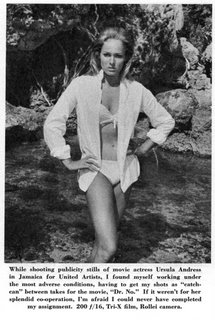
As I read my New York Times (the one made from forests) in bed in the morning, every morning, not having to see if anybody has left me any texting messages in my cell phone (It can but I don't let it.), I understand that I am a living anachronism with a memory for Plymouth Furies, Studebaker Golden Hawks and Packard Clippers. I know that the hottest Bond woman was Ursula Andress (photograph by Bunny Yeager), ample proof as to why the Swiss invented perpetual wrist movements for their chronometers. I know that I am an anachronism when I am wowed by the body of Esther Williams in Million Dollar Mermaid . Whom could I possibly call besides that other living (and much younger) anochronism friend of mine, John Lekich, who knows you never wear a button-down shirt with a bow tie? Who else can I tell that all my life I hated Esther Williams films with all that stupid (but now wonderful) synchronized swimming and that silly and perpetual smile of hers and that late in life (this past Tuesday) I have suddenly discovered she had a body to kill for?
As my world shrinks, blog I must.

All my blogs on the Why Do I Blog? theme have featured a photograph of my granddaughter Rebecca who is now 11. This time around I have also placed a picture of her sister Lauren who is 6.
I posted my first blog, with no picture on January 20, 2006. On February 24, 2007 I wrote a blog that I projected while speaking at Northern Voice 2007, a blogging conference held at UBC. On February 23, 2008 I also spoke at Northern Voice 2008 and again projected a blog that day.
This year I will not be attending Northern Voice 2009. The conference sold out much too early and I was left out. The pleasure of chatting with like-minded souls will not come my way. I have decided to take advantage of the opportunity that this loss provides me to reflect on that initial question that I made and tried to answer back on February 24, 2007 - Why do I blog?
On that date the hot topic was Twitter. It took a couple of years for Twitter to make the mainstream. Last year cloud computing was the item of discussion in all corners of UBC's Forestry Sciences Centre where Northern Voice is held every year. In many respects this amateur blogger who does not understand the difference between Apache and Java, or what they are, knew that I was getting inside information before the hoi polloi (οἱ πολλοί) did.
But as I feel saddened by not seeing my friends this coming weekend I realize why I blog more than ever. The reasons I had before are still in effect. I want to write about my family and my granddaughters. While Rebecca (note her picture here) still looms large I have found a delightful interest in her sister Lauren. Lauren looks at me straight in the eye. I love her for it.

This blog is a safety valve for the frustrations I feel as a soon-to-be former magazine photographer and writer. I took pictures for magazines for many years and and when the market began to downturn I discovered that writing and taking pictures extended my worth just a bit more. I was paid less for the photographs and less for the writing. Adding both cheques made my earnings a bit more substantial. But that is rapidly ending when you consider that culture and the arts are now buried in our Vancouver Sun in the food section. The Vancouver Sun discourages freelance work, too. It was not too long ago that the travel editor for the Sun, after running a story I wrote about traveling with Rebecca to Argentina (the editor ran it front page with lots of pictures) told me that she didn't want to hear from me again as she had her little stable of writers.
Before I started this blog, my frustration in not being able to take pictures or to write was pushing me into a dangerous zone of bitterness. Bitterness and self-employment can be a devastating cocktail. The blog dissipated it, steam was released and I now feel much better for it. It is not important that I keep a count (I don't) on who reads or if anybody (as long as some of my family and friends do that's all that matters) reads this blog. Not having a comments section certainly diminishes the blog's chance for more popularity. But I have seen how comments have corroded away initial optimism of such good BC-based online news magazines like The Tyee. I would not want these ranters to contribute to my blog.
The blog gives me the opportunity to post pictures (I take many of them exclusively thinking of the blog) that magazines would not want to run with copy that might be too personal for mainstream magazines. In short I write about anything I want to write about and place pictures to accompany copy. It fulfills my desire to tell a story which I believe has to be a trait that is hard-wired in all of us.
In my 35 years in Vancouver I have amassed a huge archive. My eldest daughter Ale began for me some years ago the necessary and useful task of putting some order into it. I am not sure that my archive has any value except to my own self-worth but one has to soldier on in the same way that a friend of mine soldiers one with a novel knowing that finding a publisher in today's climate will be very tough. One has to make the motions if one is to get up from bed every day. This blog has helped me put an order into that archive. Sometimes I look through my files randomly for a blog idea. Sometimes I conjure it in bed in the middle of the night and rush down to look for the picture in my files. Right now Rosemary and I are putting our family pictures into files by year and in some cases in themes such as Christmas or self-portrait.
While the writing jobs are all but gone I find that I can write much more quickly today than I did three years ago. It was writer James Ellroy who told me, "Sometimes I open my manuscript in the morning and change a comma. And that's all I do for that day. But that is writing. And you have to write every day if you want to be a writer. Changing that comma is writing." He was right.
Most important, I blog because I value content. I value long, well written articles by professional journalists who work for hard copy dailies like the NY Times, the online Guardian and the Argentine La Nación. It is hard for me to find this content in Vancouver. The comments section of the Globe & Mail is as scary as any other. The fact that anybody can give an opinion does not necessarily make that opinion a good one.
Imagine a book conference that featured all you ever wanted to know about the making of paper for the books. A conference that would tell you about pagination and the cutting of pages and the stretching of cloth for cloth-bound books. If you were interested in the physical properties of books you might find the conference to your liking. If you were looking for lectures on the actual content of those books you might be a bit on the disappointed side. Similarly my only complaint for the yearly Northern Voice Blogging Conference is that there is too much emphasis on the mechanics of blogging and the computer language that supports the structure of a blog. The conference is a bit short on blog content. Next year I will make sure to sign up early so as to not be disappointed. I also hope that this year and next year they bring back a bit more as to why we blog and what we blog about.
I first heard of the concept of citizen journalism when Paul Sullivan (I worked for him when he edited West Magazine) talked about a site he had started Orato.com. The site coincided with the opening of Robert Pickton's trial and Sullivan hired former prostitutes and working prostitutes to cover it. I thought the experiment was interesting because I thought I respected the meaning of that serious sounding word citizen. The word being used these days does not sound so nice. Citizen journalism is now touted as amateur journalism.
I am not suggesting that my blog has content. I am suggesting that my blog is not a rehash of, "I read the other day that the city is going to enlarge left-turn lanes. And that is one terrible idea..." Just go to any Vancouver blog aggregator to see such mindless amateur journalist regurgitation of our daily news. You can look into food blogs that are ample example of why food photography is a difficult art. Digital photographs of stews or beans are always going to look like a digested and extruded dog's breakfast. While my deprecation on the value of amateur journalism could be contested few would argue that amateur food photography has a long way to go before it becomes an attractive medium.

At best magazines have always been a symbiotic relationship between copy and pictures, be they photographs or illustrations. At one time when I was assigned to take pictures for a magazine the editor would send me the copy to read. This would help me in being able to secure a photograph that would go hand in hand with what was written. Now I rarely get sent copy. More often than not I photograph people before they have been interviewed. And that interview can many time be on the phone and now, with increasing frquency, online. While I cannot vouch for the quality of what I write I can vouch that some of my photographs do have value and particularly now in an age when cameras have built-in telephones.
"We read not only because we cannot know enough people, but because friendship is so vulnerable, so likely to diminish or disappear, overcome by space,time, imperfect sympathies, and all the sorrows of familial and passional life."
I have inserted that quote from Harold Bloom's How to Read and Why many times in these blogs. When I first read it, it hit home. There are a few former friends of mine with whom I have consciously broken off after many years of knowing each other. In some cases circumstances of work produced this distancing. I wrote about that here
But read Bloom's sad apology for fading friendship while replacing read with blog. It makes as much sense. As my circle of friends fades, disappears, dies off, etc I could always resort to social networks. I could make new friends with Facebook or participate in forums (These degenerate into insults very quickly!) in photography web sites. I could tell people (and all those who would "follow" me with bated breath) what I am doing right now with Twitter. But I will not. I cannot abide with the idea of making friends with people I have never met and then exchange pleasantries with them on the net.
These social networks, with their false sense of intimacy, remind me of the glory holes of the pre AIDS era. Glory holes first became popular in San Francisco. Gay men would go to these establishments and enter compartments that sported a smallish hole on the wall. The man would insert his male member and someone on the other end would indulge him with intimacies of a paradoxically anonymous kind. In the mid 50s women would call us on the public phones that we had on each floor of our Catholic boarding school, St. Ed's in Austin Texas. They knew we were all boys, locked up for a week and probably also knew that the only woman on campus was an older cook. They would sweet talk us for hours. We would try to get an address, a return phone number and perhaps a date. But it was to no avail. They would hang up with the promise that they would call again. How were we to know that we were experiencing (without the use of a credit card, and at the time the only one was Diners Club) that yet-to-be-developed phenomenon that is phone sex?

As I read my New York Times (the one made from forests) in bed in the morning, every morning, not having to see if anybody has left me any texting messages in my cell phone (It can but I don't let it.), I understand that I am a living anachronism with a memory for Plymouth Furies, Studebaker Golden Hawks and Packard Clippers. I know that the hottest Bond woman was Ursula Andress (photograph by Bunny Yeager), ample proof as to why the Swiss invented perpetual wrist movements for their chronometers. I know that I am an anachronism when I am wowed by the body of Esther Williams in Million Dollar Mermaid . Whom could I possibly call besides that other living (and much younger) anochronism friend of mine, John Lekich, who knows you never wear a button-down shirt with a bow tie? Who else can I tell that all my life I hated Esther Williams films with all that stupid (but now wonderful) synchronized swimming and that silly and perpetual smile of hers and that late in life (this past Tuesday) I have suddenly discovered she had a body to kill for?
As my world shrinks, blog I must.
Friday, February 20, 2009

During the Easter Vacation a student trip to Washington, D.C. was planned and carried through to a more than successful student activity under the direction of Brother Vincent de Paul and with some guidance from representatives of the Greyhound Bus Line a “Capitol to Capitol” tour was arranged with stop-overs and extended stays in such places as New Orleans, Chattanooga, Ashville, Roanoke and finally a four day vacation in Washington, D.C. A personal welcome in Washington by such people as Miss Grace Tully, Representative Thornberry, Senator Yarborough, Mr. Perry, and Senator Kilday from San Antonio, made the stay in Washington Memorable. Areas of the Eastern states, hitherto unknown to Texans and other foreign students revealed natural wondrous views as seen on these pages. Conducted tours through all the important government buildings and treasure houses of art and science plus seeing historical monuments made the trip an educational as well as a vocational venture. Holy Thursday Mass at St Ignatius Church and a Good Friday morning spent at the Franciscan Monastery allowed for devotional exercises which were climaxed by Easter Sunday Mass in Nashville, Tennessee. The names of the boys who made the trip are listed below:
Douglas Williamson, Henry Altmiller, David Burratti, Lawrence Ballard, Francisco Calderoni, John Clark, Thomas Canales, Cesar Diaz, Joe Davis, Richard Ferris, Robert Franzetti, Ivan Gaiennie, Victor Giancintti, John Fischer, Mike Graham, Jorge Hayward, Richard Isaac, John King, Emile Lapeyrouse, Pat Lynch, Kenneth Manion, Fernando Martinez, Walter Miller, Otto Ramsey, Briand Rene, Dan Sherrod, Vincent Taylor, Thomas Huddleston, Clarence Olson, Ted Dugey, Ed Maurer, Jose Jimenes.
Edwardian, 1959

The mind works in unexpected ways. Yesterday I watched Pygmalion with Rosemary's cat Toby on my lap. This is the original Pygmalion (they don't sing!) directed by Anthony Asquith and Leslie Howard. It stars Leslie Howard and Wendy Hiller with
Wilfrid Lawson almost stealing the show as Alfred Doolittle.
Here are some irrelevant facts about the original stage production in English of Pygmalion on April 11, 1914. It seems the play was premiered in German in Vienna on October 16, 1913. The London-staged play was directed by Bernard Shaw himself and it featured Mrs Patrick Campbell as Eliza and Sir Herbert Beerbohm Tree as Henry Higgins.
1. Shaw's play shocked Edwardian audiences with Eliza's swearing in the line "Not bloody likely!". Campbell was considered to have risked her successful career by speaking the line.
2. A story goes that Shaw, as part of an ongoing feud with Winston Churchill, sent Churchill tickets to the opening night of Pygmalion, with an attached note saying that "I have included two tickets so that you may bring a friend, if you have any." Churchill sent a reply: "I regret to say that I am unable to attend that night; I would like tickets to the second performance, if there is one."
3. Thanks to Pygmalion, George Bernard Shaw was the first person to have been awarded both a Nobel Prize (Literature - 1925) and an Academy Award (Pygmalion - 1939).
What is the relevance of the film Pygmalion to my trip to Washington D.C. in 1958? The tenuous link (not in the least for me) is my mother. In 1958 as a more-or-less single mother sending me to an expensive boarding school while earning the probably not too generous salary of a school teacher must have been hard-pressed to find money to send me on this trip when I asked her if I could go.
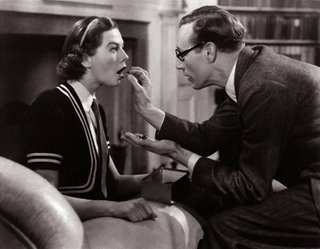
It is probably one of the most frequent tragedies of our existence that we don't appreciate what we have or get until we don't have it or until the person who gave it to us is long gone. While watching Leslie Howard (my mother's favourite actor, besides Joseph Cotten) I realized how good Howard was and how absolutely terrific Wendy Hiller was, so believable in ways that Audrey Hepburn wasn't. I had seen the film many years ago with my mother but I was too young to appreciate Bernard Shaw's wit uttered by the actors of Pygmalion. I was much too young to understand my mother's skill, sacrifice, taste and how they all influenced in making me a much better person than I surely was or could have been without her influence. I was not quite picked up from the gutter - and changed into a glamorous society butterfly! But close enough. The film hammered into my head how lucky I have been in having had the mother I had. The film gave me another indication on how that school in Texas had helped to transform me into the marginally better person I am today.
That trip to Washington DC in our very own rented Greyhound Scenicruiser made me fall in love with the United States, with its South and with Washington D.C. The American Civil War, that had so fascinated me all those years, became more immediate since we toured some of the battle grounds. In Washington D.C. a visit to the Willard Hotel (read paragraph below) became a wonderful sleeper virus that led me to take Rosemary and Rebecca, so many years later to the very same hotel and many of those other places that Brother Vincent de Paul and Brother Dunstan took us. It was in Washington where I bought my first real camera (in a pawnshop) an Agfa Silette. I quicky outgrew it and my subsequent purchase of a Pentacon-F pushed me finally into what I do today.
The high point then (I wasn't that dense or stupid) and more so even now is that my mother had allerted her sister Dolly Humphrey that I was going to Washington D.C. My Aunt Dolly's husband, Bill had a sister, Helen Humphrey who was a highfalutin lawyer in DC. Aunt Helen picked me up after getting a green light after being under the critical scrutiny of Brother Vincent de Paul (below, right), and took me to a session of the US Supreme Court. After that she took me for tea to the Willard. I remember her probing intelligence and her quiet and easy charm.
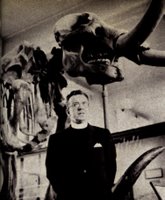
There is one more interesting connection with Pygmalion. It is with a book that has been in my possession since 1977. I like to re-read it every few years. It is Computer Power and Human Reason - From Judgment To Calculation by Joseph Weizenbaum. On page 3 Weizenbaum writes:

I chose the name ELIZA (the author's bold) for the language analysis program because like the Eliza of Pygmalion fame, it could be taught to "speak" increasingly well. Because conversations must be about something, that is, because they must take place within some context, the program was constructed in a two-tier arrangement, the first tier consisting of the language analyzer and the second of a script.
This book was one of the first books to look into the possibility of artificial intelligence. I can only wonder now if Professor Henry Higgins would ever be able, not only to make a computer speak increasingly well, but also to think. Thanks to my mother and those brothers of the Holy Cross at St. Ed's I don't do such a bad job of thinking and speaking. I don't think that Professor Henry Higgins himself could possibly discern remaining traces of that Texan accent that I surely must have had at one time.
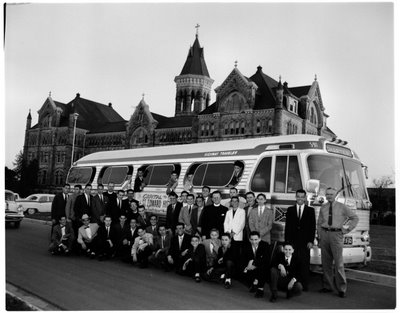
Addendum
It seems that my memory of the events and my imagination led me to the idea that our Greyhound bus was a Scenicruiser. I was wrong and this picture pleasantly sets the record straight. I received a communication from John King Class of 1961 who also went to Washington DC. He wrote:
I found this picture surfing an Austin history website at NTU. Recognize anyone in there?
John

Galanthus nivalis, the common snowdrop, has reliably early white drop like flowers with a green dot or spot. Several garden cultivars exist, some with larger flowers than the species, some with double flowers, as well as some later flowering varieties. Snowdrops are one of the earliest spring bulbs often flowering in early January. At a height of 4 - 8 inches (10-20cm) they shows off best in clumps, naturalized under deciduous trees or shrubs. You can see in the second scan of my garden snowdrops the detail that from afar looks like a green spot. After having lived in Mexico for so many years I cannot get used to this lovely plant that needs winter cold in order to faithfully come back every year. If I were to associate this beautiful little pure white flower with someone I know in Vancouver I would assert that Ballet BC's Simone Orlando is as close as anybody gets to being as beautiful as a snowdrop.
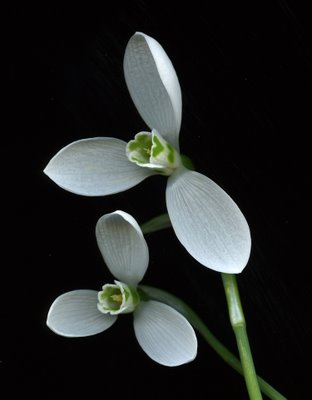
THE SNOWDROP AND THE CRITIC
By Thomas Paine
To the Editor of the Pennsylvania Magazine, 1775.
Sir—
I have given your very modest “Snow Drop” what, I think, Shakespeare calls “a local habitation and a name;” that is, I have made a poet of him, and have sent him to take possession of a page in your next Magazine: here he comes, disputing with a critic about the propriety of a prologue.
Enter Critic and SnowDrop.
CRITIC.
Prologues to magazines!—the man is mad,
No magazine a prologue ever had;
But let us hear what new and mighty things
Your wonder working magic fancy brings.
SNOW DROP.
Bit by the muse in an unlucky hour,
I’ve left myself at home, and turn’d a flower,
And thus disguised came forth to tell my tale,
A plain white Snow Drop gathered from the vale:
I come to sing that summer is at hand,
The summer time of wit you’ll understand;
And that this garden of our Magazine
Will soon exhibit such a pleasing scene,
That even critics shall admire the show
If their good grace will give us time to grow;
Beneath the surface of the parent earth
We’ve various seeds just struggling into birth;
Plants, fruits, and flowers, and all the smiling race,
That can the orchard or the garden grace;
Our numbers, Sir, so fast and endless are,
That when in full complexion we appear,
Each eye, each hand, shall pluck what suits its taste,
And every palate shall enjoy a feast;
The Rose and Lily shall address the fair,
And whisper sweetly out, “My dears,
take care”; With sterling worth,
the Plant of Sense shall rise,
And teach the curious to philosophize;
The keen eyed wit shall claim the Scented Briar,
And sober cits the Solid Grain admire;
While generous Juices sparkling from the Vine,
Shall warm the audience until they cry—divine!
And when the scenes of one gay month are o’er,
Shall clap their hands, and shout—encore, encore!
CRITIC.
All this is mighty fine! but prithee, when
The frost returns, how fight you then your men?
SNOW DROP.
I’ll tell you, Sir: we’ll garnish out the scenes
With stately rows of hardy Evergreens,
Trees that will bear the frost, and deck their tops
With everlasting flowers, like diamond drops;
We’ll draw, and paint, and carve, with so much skill,
That wondering wits shall cry,—diviner still!
CRITIC.
Better, and better, yet! but now suppose,
Some critic wight, in mighty verse or prose,
Should draw his gray goose weapon, dipt in gall,
And mow ye down, Plants, Flowers, Trees, and all.
SNOW DROP.
Why, then we’ll die like Flowers of sweet Perfume,
And yield a fragrance even in the tomb!
Addendum: Courtesy of my wife Rosemary. "Alex the snowdrops are not the ordinary ones. They are Galanthus elwesii : The flowers are much larger, appearing on 25cm (10in) stems, with two green marks on the inner segment of the petals and a honey fragrance. This species originates from Turkey."

In 1994 I had three very beautiful native Canadian "princesses" in my studio. I had been hired by a local company to promote a brand of BC Gold Komichi Konbu.
What is Komichi Konbu?
Spawn on kelp is a specialty seafood product composed of broad leaf sea kelp with a covering of herring eggs. It is also known in Japanese as komochi konbu and kazunoko konbu. Spawn on kelp has a creamy, delicate sea-like flavour and a crunchy texture. It can be used as an ingredient in a variety of dishes or on its own, either raw or cooked.
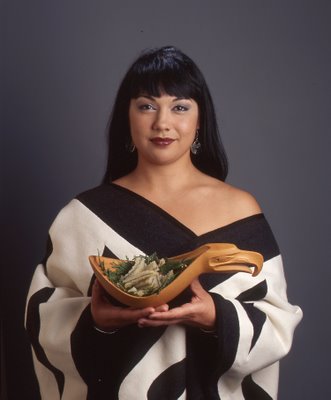
Both my eldest daughter Ale and I have been fascinated by Native Canadians. In my case my interest comes from realizing that Native Canadians look very much like the natives that populate the Americas as far as Patagonia. I have often found it frustrating that I cannot speak Spanish to Native Canadians! My daughter Ale was born in Mexico and her complexion is darkish. She considers herself very Mexican. A couple of years ago she picked up sticks and moved to Lillooet because she had the ambition of having a class made up mostly of Native Canadians. She now teaches grade 5 and her class is 65% Native Canadian. She is extremely happy in this endeavour.
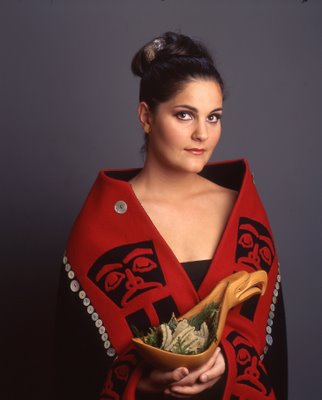
For me to have these beautiful "princesses" in my studio was an unusual delight. And best of all I was also nicely paid! In order of apperance we have here Princess Miko, Princess Leslie and Princess Danielle.

During the Easter Vacation a student trip to Washington, D.C. was planned and carried through to a more than successful student activity under the direction of Brother Vincent de Paul and with some guidance from representatives of the Greyhound Bus Line a “Capitol to Capitol” tour was arranged with stop-overs and extended stays in such places as New Orleans, Chattanooga, Ashville, Roanoke and finally a four day vacation in Washington, D.C. A personal welcome in Washington by such people as Miss Grace Tully, Representative Thornberry, Senator Yarborough, Mr. Perry, and Senator Kilday from San Antonio, made the stay in Washington Memorable. Areas of the Eastern states, hitherto unknown to Texans and other foreign students revealed natural wondrous views as seen on these pages. Conducted tours through all the important government buildings and treasure houses of art and science plus seeing historical monuments made the trip an educational as well as a vocational venture. Holy Thursday Mass at St Ignatius Church and a Good Friday morning spent at the Franciscan Monastery allowed for devotional exercises which were climaxed by Easter Sunday Mass in Nashville, Tennessee. The names of the boys who made the trip are listed below:
Douglas Williamson, Henry Altmiller, David Burratti, Lawrence Ballard, Francisco Calderoni, John Clark, Thomas Canales, Cesar Diaz, Joe Davis, Richard Ferris, Robert Franzetti, Ivan Gaiennie, Victor Giancintti, John Fischer, Mike Graham, Jorge Hayward, Richard Isaac, John King, Emile Lapeyrouse, Pat Lynch, Kenneth Manion, Fernando Martinez, Walter Miller, Otto Ramsey, Briand Rene, Dan Sherrod, Vincent Taylor, Thomas Huddleston, Clarence Olson, Ted Dugey, Ed Maurer, Jose Jimenes.
Edwardian, 1959

The mind works in unexpected ways. Yesterday I watched Pygmalion with Rosemary's cat Toby on my lap. This is the original Pygmalion (they don't sing!) directed by Anthony Asquith and Leslie Howard. It stars Leslie Howard and Wendy Hiller with
Wilfrid Lawson almost stealing the show as Alfred Doolittle.
Here are some irrelevant facts about the original stage production in English of Pygmalion on April 11, 1914. It seems the play was premiered in German in Vienna on October 16, 1913. The London-staged play was directed by Bernard Shaw himself and it featured Mrs Patrick Campbell as Eliza and Sir Herbert Beerbohm Tree as Henry Higgins.
1. Shaw's play shocked Edwardian audiences with Eliza's swearing in the line "Not bloody likely!". Campbell was considered to have risked her successful career by speaking the line.
2. A story goes that Shaw, as part of an ongoing feud with Winston Churchill, sent Churchill tickets to the opening night of Pygmalion, with an attached note saying that "I have included two tickets so that you may bring a friend, if you have any." Churchill sent a reply: "I regret to say that I am unable to attend that night; I would like tickets to the second performance, if there is one."
3. Thanks to Pygmalion, George Bernard Shaw was the first person to have been awarded both a Nobel Prize (Literature - 1925) and an Academy Award (Pygmalion - 1939).
What is the relevance of the film Pygmalion to my trip to Washington D.C. in 1958? The tenuous link (not in the least for me) is my mother. In 1958 as a more-or-less single mother sending me to an expensive boarding school while earning the probably not too generous salary of a school teacher must have been hard-pressed to find money to send me on this trip when I asked her if I could go.

It is probably one of the most frequent tragedies of our existence that we don't appreciate what we have or get until we don't have it or until the person who gave it to us is long gone. While watching Leslie Howard (my mother's favourite actor, besides Joseph Cotten) I realized how good Howard was and how absolutely terrific Wendy Hiller was, so believable in ways that Audrey Hepburn wasn't. I had seen the film many years ago with my mother but I was too young to appreciate Bernard Shaw's wit uttered by the actors of Pygmalion. I was much too young to understand my mother's skill, sacrifice, taste and how they all influenced in making me a much better person than I surely was or could have been without her influence. I was not quite picked up from the gutter - and changed into a glamorous society butterfly! But close enough. The film hammered into my head how lucky I have been in having had the mother I had. The film gave me another indication on how that school in Texas had helped to transform me into the marginally better person I am today.
That trip to Washington DC in our very own rented Greyhound Scenicruiser made me fall in love with the United States, with its South and with Washington D.C. The American Civil War, that had so fascinated me all those years, became more immediate since we toured some of the battle grounds. In Washington D.C. a visit to the Willard Hotel (read paragraph below) became a wonderful sleeper virus that led me to take Rosemary and Rebecca, so many years later to the very same hotel and many of those other places that Brother Vincent de Paul and Brother Dunstan took us. It was in Washington where I bought my first real camera (in a pawnshop) an Agfa Silette. I quicky outgrew it and my subsequent purchase of a Pentacon-F pushed me finally into what I do today.
The high point then (I wasn't that dense or stupid) and more so even now is that my mother had allerted her sister Dolly Humphrey that I was going to Washington D.C. My Aunt Dolly's husband, Bill had a sister, Helen Humphrey who was a highfalutin lawyer in DC. Aunt Helen picked me up after getting a green light after being under the critical scrutiny of Brother Vincent de Paul (below, right), and took me to a session of the US Supreme Court. After that she took me for tea to the Willard. I remember her probing intelligence and her quiet and easy charm.

There is one more interesting connection with Pygmalion. It is with a book that has been in my possession since 1977. I like to re-read it every few years. It is Computer Power and Human Reason - From Judgment To Calculation by Joseph Weizenbaum. On page 3 Weizenbaum writes:

I chose the name ELIZA (the author's bold) for the language analysis program because like the Eliza of Pygmalion fame, it could be taught to "speak" increasingly well. Because conversations must be about something, that is, because they must take place within some context, the program was constructed in a two-tier arrangement, the first tier consisting of the language analyzer and the second of a script.
This book was one of the first books to look into the possibility of artificial intelligence. I can only wonder now if Professor Henry Higgins would ever be able, not only to make a computer speak increasingly well, but also to think. Thanks to my mother and those brothers of the Holy Cross at St. Ed's I don't do such a bad job of thinking and speaking. I don't think that Professor Henry Higgins himself could possibly discern remaining traces of that Texan accent that I surely must have had at one time.

Addendum
It seems that my memory of the events and my imagination led me to the idea that our Greyhound bus was a Scenicruiser. I was wrong and this picture pleasantly sets the record straight. I received a communication from John King Class of 1961 who also went to Washington DC. He wrote:
I found this picture surfing an Austin history website at NTU. Recognize anyone in there?
John
The Snowdrop
Thursday, February 19, 2009

Galanthus nivalis, the common snowdrop, has reliably early white drop like flowers with a green dot or spot. Several garden cultivars exist, some with larger flowers than the species, some with double flowers, as well as some later flowering varieties. Snowdrops are one of the earliest spring bulbs often flowering in early January. At a height of 4 - 8 inches (10-20cm) they shows off best in clumps, naturalized under deciduous trees or shrubs. You can see in the second scan of my garden snowdrops the detail that from afar looks like a green spot. After having lived in Mexico for so many years I cannot get used to this lovely plant that needs winter cold in order to faithfully come back every year. If I were to associate this beautiful little pure white flower with someone I know in Vancouver I would assert that Ballet BC's Simone Orlando is as close as anybody gets to being as beautiful as a snowdrop.

THE SNOWDROP AND THE CRITIC
By Thomas Paine
To the Editor of the Pennsylvania Magazine, 1775.
Sir—
I have given your very modest “Snow Drop” what, I think, Shakespeare calls “a local habitation and a name;” that is, I have made a poet of him, and have sent him to take possession of a page in your next Magazine: here he comes, disputing with a critic about the propriety of a prologue.
Enter Critic and SnowDrop.
CRITIC.
Prologues to magazines!—the man is mad,
No magazine a prologue ever had;
But let us hear what new and mighty things
Your wonder working magic fancy brings.
SNOW DROP.
Bit by the muse in an unlucky hour,
I’ve left myself at home, and turn’d a flower,
And thus disguised came forth to tell my tale,
A plain white Snow Drop gathered from the vale:
I come to sing that summer is at hand,
The summer time of wit you’ll understand;
And that this garden of our Magazine
Will soon exhibit such a pleasing scene,
That even critics shall admire the show
If their good grace will give us time to grow;
Beneath the surface of the parent earth
We’ve various seeds just struggling into birth;
Plants, fruits, and flowers, and all the smiling race,
That can the orchard or the garden grace;
Our numbers, Sir, so fast and endless are,
That when in full complexion we appear,
Each eye, each hand, shall pluck what suits its taste,
And every palate shall enjoy a feast;
The Rose and Lily shall address the fair,
And whisper sweetly out, “My dears,
take care”; With sterling worth,
the Plant of Sense shall rise,
And teach the curious to philosophize;
The keen eyed wit shall claim the Scented Briar,
And sober cits the Solid Grain admire;
While generous Juices sparkling from the Vine,
Shall warm the audience until they cry—divine!
And when the scenes of one gay month are o’er,
Shall clap their hands, and shout—encore, encore!
CRITIC.
All this is mighty fine! but prithee, when
The frost returns, how fight you then your men?
SNOW DROP.
I’ll tell you, Sir: we’ll garnish out the scenes
With stately rows of hardy Evergreens,
Trees that will bear the frost, and deck their tops
With everlasting flowers, like diamond drops;
We’ll draw, and paint, and carve, with so much skill,
That wondering wits shall cry,—diviner still!
CRITIC.
Better, and better, yet! but now suppose,
Some critic wight, in mighty verse or prose,
Should draw his gray goose weapon, dipt in gall,
And mow ye down, Plants, Flowers, Trees, and all.
SNOW DROP.
Why, then we’ll die like Flowers of sweet Perfume,
And yield a fragrance even in the tomb!
Addendum: Courtesy of my wife Rosemary. "Alex the snowdrops are not the ordinary ones. They are Galanthus elwesii : The flowers are much larger, appearing on 25cm (10in) stems, with two green marks on the inner segment of the petals and a honey fragrance. This species originates from Turkey."
Komochi Konbu & Native Royalty
Wednesday, February 18, 2009

In 1994 I had three very beautiful native Canadian "princesses" in my studio. I had been hired by a local company to promote a brand of BC Gold Komichi Konbu.
What is Komichi Konbu?
Spawn on kelp is a specialty seafood product composed of broad leaf sea kelp with a covering of herring eggs. It is also known in Japanese as komochi konbu and kazunoko konbu. Spawn on kelp has a creamy, delicate sea-like flavour and a crunchy texture. It can be used as an ingredient in a variety of dishes or on its own, either raw or cooked.

Both my eldest daughter Ale and I have been fascinated by Native Canadians. In my case my interest comes from realizing that Native Canadians look very much like the natives that populate the Americas as far as Patagonia. I have often found it frustrating that I cannot speak Spanish to Native Canadians! My daughter Ale was born in Mexico and her complexion is darkish. She considers herself very Mexican. A couple of years ago she picked up sticks and moved to Lillooet because she had the ambition of having a class made up mostly of Native Canadians. She now teaches grade 5 and her class is 65% Native Canadian. She is extremely happy in this endeavour.

For me to have these beautiful "princesses" in my studio was an unusual delight. And best of all I was also nicely paid! In order of apperance we have here Princess Miko, Princess Leslie and Princess Danielle.
Tuesday, February 17, 2009

'I am a man. Nothing human is alien to me,'said the Roman, Terence. This Vlad's tale may not be 'alien', but it was still a very dark place to spend my time. Being still an actor in my heart, I always approach the characters I write as an actor would - through motivation. What events and relationships shaped their lives and affected their actions? What drove them? I sought for Vlad's motivations in the murky historical record, tried to piece together some plausible 'justification' for his actions. It was the hardest thing. And then I had an epiphany, about two thirds into the writing of the first draft - written longhand for the first time ever in an attempt to viscerally connect imagination, heart and hand - I decided not to judge him. I decided to show what he did and stop worrying why he did it. Essentially, I let him be who he was, whatever that was, to set his actions against his recorded life and in the context of the brutal place and epoch in which he lived. I would let the reader decide.
Author's Note, from Vlad - The Last Confession by C.C. Humphreys
History has not dealt Vlad Dracula, the 15th century ruler of Wallachia, a fair hand. What is most unusual of Vlad - The Last Confession (out a couple of months ago) a novel which is based on the historical events in the Wallachian ruler's life, is that the author, as he reveals in his author's note, took the unusual approach of an actor who happens to be a writer. I have read and enjoyed thoroughly three ( I could include here the memoirs and letters of Noel Coward) other actor/writers, Dirk Bogarde, David Niven and even photographed one of them, Liv Ullmann. By looking for an actor's justification, Vancouver author/actor/swordsman C.C. Humphreys has managed a measure of objectivity without affecting the exciting plot. The gory parts, an almost clinical description on the method of impalement with which Vlad kept order, and terrorized his enemies (and even kept a solid gold goblet at a public drinking fountain of his capital, without it being stolen) could be daunting for some. But this is nicely balanced with a vivid description of the art of falconry and the customs of the Turkish court of Murad Han and his son Mehmet Celebi who took Constantinople.
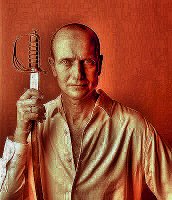
I understand this actor's justification as justification is always in the back of my head when I take a portrait. I must justify what I do or my portrait will be an empty one. If I cannot treat my subject as a human being, accept his dignity, regardless of the fact that he may be a dishonest trader or lying politician, I cannot take my picture.
Method acting can have its most positive points when you consider that Humphreys spent solitary hours in Dracula's castle to absorb the atmosphere. The book is full of this dark atmosphere and I longed to see Vlad's dark steel armour as Humphreys described it. When the reader finds out that the author is not only an actor but a swordsman, too, the battle scenes seem that much more vivid and realistic.
Perhaps the author meant to inject a bit of the events of that bloody 15th century that set up the problems of the former Yugoslavia and that area that we call the Balkans. After finishing this adventure novel, I understand a bit of what led to the partition of Yugoslavia. I would assert that Humphreys Vlad - The Last Confession read in conjunction with Robert D. Kaplan's Balkan Ghosts will serve you well if you are to understand what is happening in that part of the world.
Humphreys Vlad - The Last Confession has only partially satisfied my desire (it happens frequently) to read novels of adventure of the swashbuckling kind. Humphreys to me is similar to Cartagena, Spain born author Arturo Perez-Reverte who writes lovely but controversial essays and wonderful novels like The Spherical Chart and Club Dumas. But his fans pepper him with complaints written in pseudo 17th century Spanish asking him to get on with one more installment of his most popular novels featuring the dashing mercenary swordsman, Capitán Alatriste who reads Góngora, Cervantes and de Quevedo. At least two Alatriste novels have been translated into English.

In a similar vein I would like to communicate to the author that it is just fine to write stand alone novels like the recently deceased Michael Dibdin (we all waited for his Aurelio Zen books!) used to do but I do plead that I want more Jack Absolute, the sooner the better.
I especially need my Jack Absolute fix as Jack Absolute's competition, Matthew Hervey has just appeared in Allan Mallinson's Warrior (which I read before starting on Vlad) and Mallinson reveals that Hervey (of the 6th Light Dragoons) will not be appearing in the 11th novel for a while, "Indeed we must wait a little longer than usual: twice as long, in fact, for the eleventh book in the series will be published - Deo Volente - in two year's time, not one."
On the other hand, without revealing Vlad's ending, I can assert that even though the historical Vlad may have lost his head and had it displayed on a stake on the walls of Constantinople, things are not quite what they seem as the varcolaci (undead) can come back in more than one way. And who knows Vlad's - Last Confession might not really be his last.

'I am a man. Nothing human is alien to me,'said the Roman, Terence. This Vlad's tale may not be 'alien', but it was still a very dark place to spend my time. Being still an actor in my heart, I always approach the characters I write as an actor would - through motivation. What events and relationships shaped their lives and affected their actions? What drove them? I sought for Vlad's motivations in the murky historical record, tried to piece together some plausible 'justification' for his actions. It was the hardest thing. And then I had an epiphany, about two thirds into the writing of the first draft - written longhand for the first time ever in an attempt to viscerally connect imagination, heart and hand - I decided not to judge him. I decided to show what he did and stop worrying why he did it. Essentially, I let him be who he was, whatever that was, to set his actions against his recorded life and in the context of the brutal place and epoch in which he lived. I would let the reader decide.
Author's Note, from Vlad - The Last Confession by C.C. Humphreys
History has not dealt Vlad Dracula, the 15th century ruler of Wallachia, a fair hand. What is most unusual of Vlad - The Last Confession (out a couple of months ago) a novel which is based on the historical events in the Wallachian ruler's life, is that the author, as he reveals in his author's note, took the unusual approach of an actor who happens to be a writer. I have read and enjoyed thoroughly three ( I could include here the memoirs and letters of Noel Coward) other actor/writers, Dirk Bogarde, David Niven and even photographed one of them, Liv Ullmann. By looking for an actor's justification, Vancouver author/actor/swordsman C.C. Humphreys has managed a measure of objectivity without affecting the exciting plot. The gory parts, an almost clinical description on the method of impalement with which Vlad kept order, and terrorized his enemies (and even kept a solid gold goblet at a public drinking fountain of his capital, without it being stolen) could be daunting for some. But this is nicely balanced with a vivid description of the art of falconry and the customs of the Turkish court of Murad Han and his son Mehmet Celebi who took Constantinople.

I understand this actor's justification as justification is always in the back of my head when I take a portrait. I must justify what I do or my portrait will be an empty one. If I cannot treat my subject as a human being, accept his dignity, regardless of the fact that he may be a dishonest trader or lying politician, I cannot take my picture.
Method acting can have its most positive points when you consider that Humphreys spent solitary hours in Dracula's castle to absorb the atmosphere. The book is full of this dark atmosphere and I longed to see Vlad's dark steel armour as Humphreys described it. When the reader finds out that the author is not only an actor but a swordsman, too, the battle scenes seem that much more vivid and realistic.
Perhaps the author meant to inject a bit of the events of that bloody 15th century that set up the problems of the former Yugoslavia and that area that we call the Balkans. After finishing this adventure novel, I understand a bit of what led to the partition of Yugoslavia. I would assert that Humphreys Vlad - The Last Confession read in conjunction with Robert D. Kaplan's Balkan Ghosts will serve you well if you are to understand what is happening in that part of the world.
Humphreys Vlad - The Last Confession has only partially satisfied my desire (it happens frequently) to read novels of adventure of the swashbuckling kind. Humphreys to me is similar to Cartagena, Spain born author Arturo Perez-Reverte who writes lovely but controversial essays and wonderful novels like The Spherical Chart and Club Dumas. But his fans pepper him with complaints written in pseudo 17th century Spanish asking him to get on with one more installment of his most popular novels featuring the dashing mercenary swordsman, Capitán Alatriste who reads Góngora, Cervantes and de Quevedo. At least two Alatriste novels have been translated into English.

In a similar vein I would like to communicate to the author that it is just fine to write stand alone novels like the recently deceased Michael Dibdin (we all waited for his Aurelio Zen books!) used to do but I do plead that I want more Jack Absolute, the sooner the better.
I especially need my Jack Absolute fix as Jack Absolute's competition, Matthew Hervey has just appeared in Allan Mallinson's Warrior (which I read before starting on Vlad) and Mallinson reveals that Hervey (of the 6th Light Dragoons) will not be appearing in the 11th novel for a while, "Indeed we must wait a little longer than usual: twice as long, in fact, for the eleventh book in the series will be published - Deo Volente - in two year's time, not one."
On the other hand, without revealing Vlad's ending, I can assert that even though the historical Vlad may have lost his head and had it displayed on a stake on the walls of Constantinople, things are not quite what they seem as the varcolaci (undead) can come back in more than one way. And who knows Vlad's - Last Confession might not really be his last.
Monday, February 16, 2009

My grandmother used to always tell me, "La ignorancia es atrevida." This means that those who are ignorant are sometimes daring in what they do because they do not know any better. One August around the end of the 70s I went to the Abbotsford Air Show with my daughter Ale and my friend Paul Leisz. Both are in the picture in front of a US Navy Blue Angels A-4 Skyhawk. I attempted to photograph the Blue Angel formations and mostly failed in my enterprise as I did not know what I was doing. My most memorably stupid mistake what taking pictures of a Blue Angel flying upside down. I had no mountain or horizon reference in my picture. All you had to do was to turn the picture upside down and the airplane was flying right side up. By the time I caught up with the Blue Angels again in 1994 I sort of knew what I was doing. Look here. In 2002 I went all the way to Pensacola, Florida to the home of the Blue Angels. I wonder if any of the planes suspended from the National Naval Aviation Museum at the Pensacola Naval Air Station were any of the ones this amateur had photographed back in 1980?
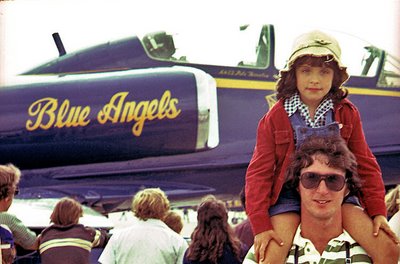
The only person in my family that was ever interested in Airplanes was Ale. She went back with me several times through the years. She found a job working for the industry side of the show which was called Airshow Canada. She was so well-liked that she went to work for the Chilean Air Force one year in a show in Santiago.

I attempted to interest Rebecca in airplanes but her enthusiasm waned very quickly. The one time I took her I asked her which was her favourite airplane. "It's the Tomcat,"she told me. "Why?"I asked her. Her reply was most satisfactory, "Because it is the loudest."
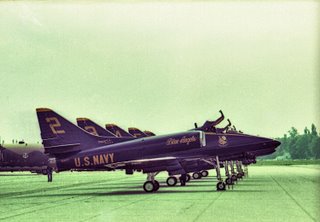
In the additional blog below I show one of the most remarkable pictures ever taken of a Skyhawk about to attack a ship. The photograph (Click on it to enlarge it. The Skyhawk is right smack in the middle.) affects me close to my heart because I have a special affection for this grand and beautiful airplane. The reason for this affection is here.

The trap at first worked when a FAA A-4C Skyhawk coded C-304 of Grupo 4 de Caza deployed to San Julian was shot down north east of Pebble Island by a Sea Dart missile while returning from a mission to San Carlos Water. Capitán Jorge Osvaldo García successfully ejected but was not recovered from the water, (his body was washed ashore in a dinghy at Golding Island in 1983). Garcia's wingman was also shot down during the raid on San Carlos, by a Sea Cat from HMS Yarmouth (also claimed by various others in the area including a Rapier battery), but he was luckier, and ejected into captivity, in front of waiting News Crews.
They then came under attack by several waves of Argentine A-4 Skyhawks specifically sent to sink them. Despite managing to shoot down two attackers earlier in the day, on the final occasion a wave of four enemy aircraft flew so low that Coventry's targeting radar could not distinguish between them and the land and failed to lock on. Broadsword attempted to target the first pair of attackers with her Sea Wolf missile system, but her own tracking system locked down during the attack and could not be reset before the aircraft released their bombs. Of the four bombs released, one struck Broadsword's flight deck and – though it failed to explode – damaged the ship's Lynx helicopter. Though she was still unable to gain a lock on the second pair of Skyhawks, Coventry launched a Sea Dart in an attempt to distract them and turned to starboard in order to reduce her profile. On Broadsword the Sea Wolf system had been reset and had successfully acquired the attacking aircraft, but was again unable to deploy when Coventry's turn took her directly into the line of fire.
Coventry used her 4.5 inch gun and small arms against the attacking aircraft. Coventry was struck by three of the four bombs released, two exploded and she immediately began listing to port. One of the bombs had struck the computer room and the blast destroyed it and the operations room nearby, incapacitating almost all senior officers.
Within 20 minutes she had been abandoned and had completely capsized, with the loss of 19 of her crew. After the ship was struck, her crew, waiting to be rescued, sang "Always Look on the Bright Side of Life" from Monty Python's Life of Brian. She sank the next day. A memorial cross was erected on Pebble Island after the war.
From Wikipedia, the free encyclopedia

Yesterday, Saturday, Rebecca and I went to the Playhouse Theatre to experience a matinée performance of the Turning Point Ensemble (in association with Vancouver 2010 Cultural Olympiad and the SFU Contemporary Arts) of Erik Satie's Relâche. As we entered I spotted a friend. "Rebecca I want you to meet a poet, he is a member of the Canadian Communist Party." With a smile on his face Jamie Reid said," I am not a member of the Canadian Communist Party. I was a member of the Communist Party of Canada (Marxist-Leninist)." Reid handed me a copy of his latest poems. In it I found a poet who had collaborated with Satie in his Furniture Music:
homage to max jacob
I was severely mistaken in writing to a poet acquaintance that
Max Jacob took his own life.
In fact, it was only and maybe merely his afterlife he took, and he
took it deliberately as a Catholic, which he had become by
choice, not birth.
After converting to the Church of Rome, he joined the gang of
Poets and artists on Montmartre in order to sin disgracefully, so
he said.
It was not for this reason that the Gestapo later arrested him and
put him in the concentration camp where he died of lung
disease. It was because he had been born a Jew.
His conversion therefore completely failed to save his life.
I hope my poet acquaintance, who told me he feels his own
work is most like Max Jacob’s, does not come to suffer a similar
fate.
May he contrive to enjoy all sins untramelled, no matter how
considerable, without feeling any need for punishment, as did
poor Catholic Max.
May I, too, live in hope
to do the same, dear,
merciful God.
From homages by Jamie Reid, January 2009 by permission from author.
Rebecca had a chat with Christopher and Jennifer Gaze. She talked to heart surgeon Larry Burr about cross country skiing and violinist Marc Destrubé explained to Rebecca, "Erik Satie did not like anything. He only ate white foods like eggs, sugar, shredded bones, animal fat, salt, coconuts, rice, turnips, pastry, cheese (white varieties), cotton salad, and certain kinds of fish."
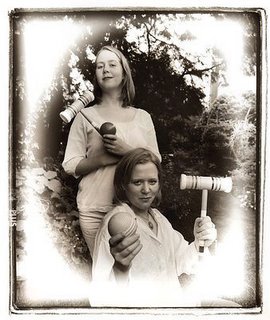
Phoebe MacRae (seen here sitting with her sister, Caitlin, standing), we were most surprised, did not play the Virgin Mary nor did she appear with a croquet mallet. She opted for singing in her beautiful soprano the Trois Mélodies de 1886.
Both Rebecca and I noticed the man, Edmond Kilpatrick. (here seen with Rebecca at Arts Umbrella) who was making the rows of paper boats on a table while cooly watching a woman, Tiffany Tregarthen (as sinuous as a snake so said Jamie Reid) dance (beautifully choreographed by Simone Orlando) as if she had not been wearing high heels.

I could go on and on in the above pseudo-Dadaist/Surrealist vein. Or I could tell you what a good time Rebecca and I had at the performance. I will do neither.
My preference is to point out the strange but wonderful paradox of Vancouver that so often feels like a backwater (especially culturally) to the rest of Canada and the world.
On Friday I attended a performance of the Pacific Baroque Orchestra at St James Anglican. The leader of the group was the renowned violinist Marc Destrubé who also leads the Axelrod Quartet that is playing in Vancouver on February 27. Why was he at the 2pm matinée? Destrubé knows a rare and good thing when he sees it. The chances that anybody would ever see a live performance of Erik Satie's Relâche in one's lifetime are most unlikely. And even more so that the unlikely event would be held in Vancouver.
So the paradox is that our city offers a variety of cultural events that are first notch yet attendance is sparse in many cases while people complain that there is no culture in Vancouver, that periodicals, newspapers and magazines do not promote culture and the arts. They further add that they do not inform us or urge us to attend these events. People that I know at the CBC tell me that they have orders from above that culture and the arts are at the bottom of their priorities. People I know at the CBC tell me that no CBC affiliated radio station in the interior of BC would be interested in covering this month's tour of the Pacific Baroque Orchestra. One of the CBC spokepersons told me, "In the interior they are only interested in sports and jobs."
At yesterday's matinée of Relâche I saw no more than 5 children including my Rebecca. Just a few days ago I had been talking to art gallery owner Linda Lando and she told me, "Part of the problem lies in the school. They just don't teach them"
All I had to do to turn on Rebecca to Eric Satie was to play in our car my copy of Satie - Piano Works with Daniel Varsano and Philippe Entremont. Satie's 3 Gymnopédies are instantly charming to children. When Rebecca asked me a bit about what we had seen I told her that Satie was protesting against the idea that music, dance, culture and the arts did not have to be serious or overly long. It could be funny, entertaining, accessible and, best of all, did not have to be "understood" to be enjoyed.

Jamie Reid reads his Homages
Addendum
I should also mention that I had a second reason for being at the Satie performance which is that I'm a member of the Turning Point Enemble (and couldn't do the Satie because of the Pacific Baroque Orchestra conflict). Should also mention that the Pacific Baroque Orchestra West Van concert this afternoon was rather well-attended. I should also mention that I did a half-hour interview about the Satie program, even though I wasn't playing, for Radio Canada's Le Pont des Arts. The fact that they have a two-hour arts journal in the rush-hour time slot on their Radio One says something about different priorities in our different cultures...And this was my third lengthy interviewd for them in the past three months.
Marc Destrubé

My grandmother used to always tell me, "La ignorancia es atrevida." This means that those who are ignorant are sometimes daring in what they do because they do not know any better. One August around the end of the 70s I went to the Abbotsford Air Show with my daughter Ale and my friend Paul Leisz. Both are in the picture in front of a US Navy Blue Angels A-4 Skyhawk. I attempted to photograph the Blue Angel formations and mostly failed in my enterprise as I did not know what I was doing. My most memorably stupid mistake what taking pictures of a Blue Angel flying upside down. I had no mountain or horizon reference in my picture. All you had to do was to turn the picture upside down and the airplane was flying right side up. By the time I caught up with the Blue Angels again in 1994 I sort of knew what I was doing. Look here. In 2002 I went all the way to Pensacola, Florida to the home of the Blue Angels. I wonder if any of the planes suspended from the National Naval Aviation Museum at the Pensacola Naval Air Station were any of the ones this amateur had photographed back in 1980?

The only person in my family that was ever interested in Airplanes was Ale. She went back with me several times through the years. She found a job working for the industry side of the show which was called Airshow Canada. She was so well-liked that she went to work for the Chilean Air Force one year in a show in Santiago.

I attempted to interest Rebecca in airplanes but her enthusiasm waned very quickly. The one time I took her I asked her which was her favourite airplane. "It's the Tomcat,"she told me. "Why?"I asked her. Her reply was most satisfactory, "Because it is the loudest."

In the additional blog below I show one of the most remarkable pictures ever taken of a Skyhawk about to attack a ship. The photograph (Click on it to enlarge it. The Skyhawk is right smack in the middle.) affects me close to my heart because I have a special affection for this grand and beautiful airplane. The reason for this affection is here.
The Skyhawk & HMSS Coventry

The trap at first worked when a FAA A-4C Skyhawk coded C-304 of Grupo 4 de Caza deployed to San Julian was shot down north east of Pebble Island by a Sea Dart missile while returning from a mission to San Carlos Water. Capitán Jorge Osvaldo García successfully ejected but was not recovered from the water, (his body was washed ashore in a dinghy at Golding Island in 1983). Garcia's wingman was also shot down during the raid on San Carlos, by a Sea Cat from HMS Yarmouth (also claimed by various others in the area including a Rapier battery), but he was luckier, and ejected into captivity, in front of waiting News Crews.
They then came under attack by several waves of Argentine A-4 Skyhawks specifically sent to sink them. Despite managing to shoot down two attackers earlier in the day, on the final occasion a wave of four enemy aircraft flew so low that Coventry's targeting radar could not distinguish between them and the land and failed to lock on. Broadsword attempted to target the first pair of attackers with her Sea Wolf missile system, but her own tracking system locked down during the attack and could not be reset before the aircraft released their bombs. Of the four bombs released, one struck Broadsword's flight deck and – though it failed to explode – damaged the ship's Lynx helicopter. Though she was still unable to gain a lock on the second pair of Skyhawks, Coventry launched a Sea Dart in an attempt to distract them and turned to starboard in order to reduce her profile. On Broadsword the Sea Wolf system had been reset and had successfully acquired the attacking aircraft, but was again unable to deploy when Coventry's turn took her directly into the line of fire.
Coventry used her 4.5 inch gun and small arms against the attacking aircraft. Coventry was struck by three of the four bombs released, two exploded and she immediately began listing to port. One of the bombs had struck the computer room and the blast destroyed it and the operations room nearby, incapacitating almost all senior officers.
Within 20 minutes she had been abandoned and had completely capsized, with the loss of 19 of her crew. After the ship was struck, her crew, waiting to be rescued, sang "Always Look on the Bright Side of Life" from Monty Python's Life of Brian. She sank the next day. A memorial cross was erected on Pebble Island after the war.
From Wikipedia, the free encyclopedia
Erik Satie, Jamie Reid, No Performance Today & A Row Of Paper Boats
Sunday, February 15, 2009

Yesterday, Saturday, Rebecca and I went to the Playhouse Theatre to experience a matinée performance of the Turning Point Ensemble (in association with Vancouver 2010 Cultural Olympiad and the SFU Contemporary Arts) of Erik Satie's Relâche. As we entered I spotted a friend. "Rebecca I want you to meet a poet, he is a member of the Canadian Communist Party." With a smile on his face Jamie Reid said," I am not a member of the Canadian Communist Party. I was a member of the Communist Party of Canada (Marxist-Leninist)." Reid handed me a copy of his latest poems. In it I found a poet who had collaborated with Satie in his Furniture Music:
homage to max jacob
I was severely mistaken in writing to a poet acquaintance that
Max Jacob took his own life.
In fact, it was only and maybe merely his afterlife he took, and he
took it deliberately as a Catholic, which he had become by
choice, not birth.
After converting to the Church of Rome, he joined the gang of
Poets and artists on Montmartre in order to sin disgracefully, so
he said.
It was not for this reason that the Gestapo later arrested him and
put him in the concentration camp where he died of lung
disease. It was because he had been born a Jew.
His conversion therefore completely failed to save his life.
I hope my poet acquaintance, who told me he feels his own
work is most like Max Jacob’s, does not come to suffer a similar
fate.
May he contrive to enjoy all sins untramelled, no matter how
considerable, without feeling any need for punishment, as did
poor Catholic Max.
May I, too, live in hope
to do the same, dear,
merciful God.
From homages by Jamie Reid, January 2009 by permission from author.
Rebecca had a chat with Christopher and Jennifer Gaze. She talked to heart surgeon Larry Burr about cross country skiing and violinist Marc Destrubé explained to Rebecca, "Erik Satie did not like anything. He only ate white foods like eggs, sugar, shredded bones, animal fat, salt, coconuts, rice, turnips, pastry, cheese (white varieties), cotton salad, and certain kinds of fish."

Phoebe MacRae (seen here sitting with her sister, Caitlin, standing), we were most surprised, did not play the Virgin Mary nor did she appear with a croquet mallet. She opted for singing in her beautiful soprano the Trois Mélodies de 1886.
Both Rebecca and I noticed the man, Edmond Kilpatrick. (here seen with Rebecca at Arts Umbrella) who was making the rows of paper boats on a table while cooly watching a woman, Tiffany Tregarthen (as sinuous as a snake so said Jamie Reid) dance (beautifully choreographed by Simone Orlando) as if she had not been wearing high heels.

I could go on and on in the above pseudo-Dadaist/Surrealist vein. Or I could tell you what a good time Rebecca and I had at the performance. I will do neither.
My preference is to point out the strange but wonderful paradox of Vancouver that so often feels like a backwater (especially culturally) to the rest of Canada and the world.
On Friday I attended a performance of the Pacific Baroque Orchestra at St James Anglican. The leader of the group was the renowned violinist Marc Destrubé who also leads the Axelrod Quartet that is playing in Vancouver on February 27. Why was he at the 2pm matinée? Destrubé knows a rare and good thing when he sees it. The chances that anybody would ever see a live performance of Erik Satie's Relâche in one's lifetime are most unlikely. And even more so that the unlikely event would be held in Vancouver.
So the paradox is that our city offers a variety of cultural events that are first notch yet attendance is sparse in many cases while people complain that there is no culture in Vancouver, that periodicals, newspapers and magazines do not promote culture and the arts. They further add that they do not inform us or urge us to attend these events. People that I know at the CBC tell me that they have orders from above that culture and the arts are at the bottom of their priorities. People I know at the CBC tell me that no CBC affiliated radio station in the interior of BC would be interested in covering this month's tour of the Pacific Baroque Orchestra. One of the CBC spokepersons told me, "In the interior they are only interested in sports and jobs."
At yesterday's matinée of Relâche I saw no more than 5 children including my Rebecca. Just a few days ago I had been talking to art gallery owner Linda Lando and she told me, "Part of the problem lies in the school. They just don't teach them"
All I had to do to turn on Rebecca to Eric Satie was to play in our car my copy of Satie - Piano Works with Daniel Varsano and Philippe Entremont. Satie's 3 Gymnopédies are instantly charming to children. When Rebecca asked me a bit about what we had seen I told her that Satie was protesting against the idea that music, dance, culture and the arts did not have to be serious or overly long. It could be funny, entertaining, accessible and, best of all, did not have to be "understood" to be enjoyed.

Jamie Reid reads his Homages
Addendum
I should also mention that I had a second reason for being at the Satie performance which is that I'm a member of the Turning Point Enemble (and couldn't do the Satie because of the Pacific Baroque Orchestra conflict). Should also mention that the Pacific Baroque Orchestra West Van concert this afternoon was rather well-attended. I should also mention that I did a half-hour interview about the Satie program, even though I wasn't playing, for Radio Canada's Le Pont des Arts. The fact that they have a two-hour arts journal in the rush-hour time slot on their Radio One says something about different priorities in our different cultures...And this was my third lengthy interviewd for them in the past three months.
Marc Destrubé
Saturday, February 14, 2009
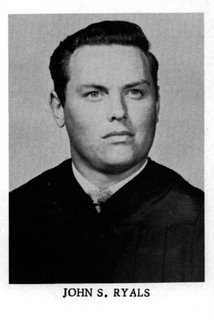
Sometime in August 1984 (I remember it was a Friday because of subsequent events) I was reading a book by Jan Morris on Wreck Beach in Vancouver. Jan wrote about a journey across Texas to the Mexican border. I was so hit by nostalgia for Texas that I went home and told Rosemary, "I am going to Texas on Monday. I am going to visit my dentist friend from St Ed's, Stephen Burdick who lives in Houston." I called directory assistance for Houston and remembering Stephen’s middle name, Allan, I asked for Dr Stephen A. Burdick. Within minutes I was talking to my frien and who said he would drive me to our old school in Austin.
While I have always tried to keep in touch with the people of my past, it can be difficult to do so with the stress of living and making a living in the present.
On one extremely hot Houston evening, Stephen Burdick and I met with four or five more of our former classmates (ones that lived in Houston or nearby) poolside at the Holiday Inn. I was shocked by the surprise of seeing boys that were men. These were men whom I had last seen as boys 23 years before. One of them, John Arnold in his white short sleeved button-down shirt (and tie) looked like Gerald Ford. Maurice Badeaux, another of classmates and also with Arnold a former roommate) whispered in my ear, "He's a spook with the CIA." Sixt three of us had graduated from St Ed's High School in Austin, Texas in 1961. Some of us were boarders. Others were day students. We mentioned those who we remembered. Some had not finished with us in 1961but had left some impression. The Anglos had a bit of a problem remembering the Garzas, the Garcias and the Gonzalezes. We almost forgot the Hungarians, the two Katos (Csaba and Nicholas) and Istvan Rozanich. One name we all remembered was John "Bear" Ryals. He was a big guy. He was a quiet, soft spoken big guy who in my memory of him (he attended St Ed's the full four years) never lost his temper or beat up anybody.
"He died in Vietnam," they all said. I remember thinking, "Ryals died in Vietnam." All those articles I had read in Time, all those body counts I had read in the newspapers had meant nothing until now. I knew someone who had died in Vietnam.
Off and on I have found other classmates and I correspond with some, frequently.
If I am going to be really honest I can affirm that in the 48 years that have elapsed I have forgotten many of those 63 classmates. I can also affirm that I may have been shy, rude or a nerd because I made few friends in those four years. The few that I made, like Dr. Stephen Burdick, were that kind of friendship where the communication barriers of the 60s and the physical distance between Texas and Argentina almost guaranteed a fade into oblivion. It took Jan Morris to put that first spark of interest.
As I prepare for he exciting prospect of a first ever all classes (1925 -1972) reunion this June 12 (to 14) I wonder why I am excited. A four year stint as a boarder in a marginally strict Catholic school leaves more impressions, obviously (to me, only now!) than sharing the deck and the captain's table with other old people of my age on a cruise ship. God forbid that I will be ever caught on such a deck!
My earth-shaking revelation is that those four years cemented a bond that I was not aware of. One classmate, Lee Lytton III who hailed from a Sarita, Texas, a hick town (my opinion then) tormented me for a few years by calling me Monk. It seemed that my nose in combination with my jaw line produced a simian profile. Lytton was suave (I should have suspected then that there was more to Sarita than I knew), had a wonderful sophisticated sense of humor and in spite of his glasses seemed to be popular with girls. He could dance. I couldn't. Lytton was a member of the cheerleaders. From my vantage point in the school band I could only lust after Judy Reyes, while Lytton could hold her hand and jump up during our not too frequent touchdowns. We now communicate freely by email. I can sense the bond of those shared four years and I look forward to seeing him in June. Like everybody else, Lytton said, John Ryals Died in Vietnam.
Trying to find a classmate by Google and other methods has been frustrating but also exciting when I find someone. Some of us are technology impaired and "we don't do email." For those I used on-line white pages and Skype. Our school yearbooks, the Edwardians, thankfully noted our middle name initial. That helps. But many of those names lead nowhere quickly. As an example, my search for William B. Schieffer reached a dead end at a disconnected phone number in San Marcos, Texas. Before Schieffer and I became friends (he was a day student so he could drive a car. This was a privilege we all were most jealous of.) he forced me to the floor, sat on top of me and said, "If you tell me one more time that my Nash Metropolitan looks like a bath tub I will beat you up."
I called Charles Rodgers who lives in Tyler, Texas. Rodgers had no recollection of me even though we had both been borders. He was tall, good looking and he liked to smile and sing. I asked him what he did. "I am in the funeral business." I threw some names at him. My ears perked up when he said, "Ryals called from, I believe it was Massachusetts. He told me he was coming my way. But he never showed up."
This was a ray of hope after months of going through all kinds of war dead lists from the US Army, US Navy, Air force and Marines. I never got anywhere even though John Ryals's middle name was the most unusual Shelly.
I tried a site called Classmates.com. Once you sign up you can see a pretty detailed list of classes. I find many for 1958-1962. The deal is that you cannot communicate (or get a confirmation that your message was received) until you pay. Once you pay you become a Gold Member. This sounded like a racket so I did not pay. To my pleasant shock I found John S Ryals in that list. Best of all he was a Gold Member. This would mean that if I emailed him and put my person email in the message, he would be able to answer back without me having to pay. Consider the Kismet of the situation. Of all the St. Ed's classmates of mine in the year 1958-1961 the only Gold Member is Ryals. I sent my email. The reply, amply proves that truth is most definitely stranger than fiction.
First I should tell you this is not John it is his wife Sarah. I usually do the computer stuff. It is good to hear from someone that attended St Edwards. John has been wondering about reunions for many years, but never knew how to find out when they are, or who to contact.
If you read John's write-up you will know that he is living in Massachusetts. He stayed up there after getting out of the Navy. He has 3 kids 1 boy, 2 girls, and 7 grandchildren, 4 boys 3 girls.
Yes John had quite a problem while in the Navy, I did not know him then. I don't know where they were going but off the coast of Naples the destroyer he was on was struck by an aircraft carrier. It took several hours to get him out, 10 cases of toilet paper saved his life. They airlifted him to the aircraft carrier, operated on him, and then he was in the hospital in Naples for 3 months. While the ship was being repaired the crew restored an orphanage in Naples.
We are in Naples, FL for the winter, will start back to MA the first part of April. John lives on. I don't know if we will make the reunion, we have to go to Savannah, GA. One of the grandsons is into gymnastics and has a competition in Savannah in June.
Right now John is out with the guys at the rec hall playing poker. I will make sure he gets your email in the morning. If you want, you can email John back at this address. Talk to you later.
Sarah Ryals
The Collision
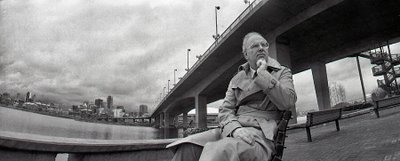
Magazines and newspapers of yore, BD (before their decline) used to run articles that went through predictable cycles. One of my favourites was when editors would assign young writers to drive a cab and then write about the experience. Another was "Where are they now?"
This later theme worked especially well when one of the "them" had faded from our memory. The two men I cite here in the "where are they?" have quite a few things in common. For one I photographed both men in March 1990 for a business magazine called Equity. Both men were developers. One of them (Michael Audain) was already very wealthy. The other, Bob Rennie (here with his two children) was on his way.
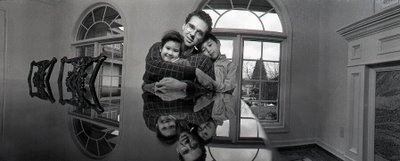
Both men are around. Both men are famous. One of them is of that rare breed, a philanthropist of the arts.
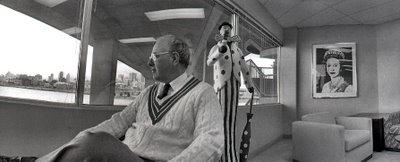
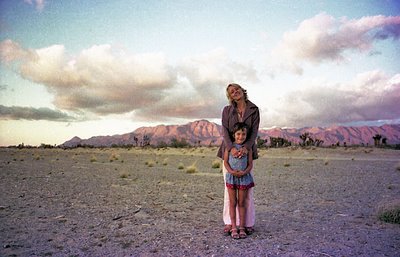
In 1974 Rosemary (the pioneer of our family) told me, "I think Mexico right now is unstable. I don't see much of a future for us and for Ale and Hilary. We should move to Canada." Rosemary was not only a pioneer but practical, too. We had decided to send all of our belongings by a moving company but when it came to traveling to our destination, Vancouver, Rosemary suggested we buy a roof rack for our arctic white VW beetle. A year before we had driven all the way to San Francisco using the newly opened Baja California Highway. This time around we drove up the west coast of Mexico through one of the most spectacular and dry deserts of the world, el Gran Desierto de Altar which is part of the bigger Sonoran Desert. We saw volcanos so small that our sense of scale became warped. We saw the skeletons of cars and trucks that had not made their destination. Our home was the off white VW with its orange tarp.

At the Desierto de Altar all I remember was that it was very early in the morning and the mountains (that sense of scale again) were either close and small or far away and large. We really could not tell. Even though the girls were tired and sleeping I stopped and snapped this picture of Rosemary and Ale. I took the picture using Kodacolor II with my decidedly unsharp Pentacon F with its Tessar F-2.8 lens. If you compare this picture with the others you will note that the negatives have suffered emulsion breakdown since 1975 and I am unable to correct the colour across the board. It could have been worse if I had not remembered that the VW was not white but a curious blend of white with a tad of green/cyan.

This snapshot of Rosemary and Ale has become an icon for us. It represents a time when we took chances, saw an uncertain but decidedly rosy future and our children were many years from being older now, than Rosemary and I were then. The picture of Ale on the beach I took on the Gulf of California somewhere near a place called Bahía Kino.
When we visit Ale in Lillooet I sometimes feel a comforting feeling. I think it could be whiffs of the dessert, of that lovely Gran Desierto de Altar and how one can sometimes partially go back home again.


Sometime in August 1984 (I remember it was a Friday because of subsequent events) I was reading a book by Jan Morris on Wreck Beach in Vancouver. Jan wrote about a journey across Texas to the Mexican border. I was so hit by nostalgia for Texas that I went home and told Rosemary, "I am going to Texas on Monday. I am going to visit my dentist friend from St Ed's, Stephen Burdick who lives in Houston." I called directory assistance for Houston and remembering Stephen’s middle name, Allan, I asked for Dr Stephen A. Burdick. Within minutes I was talking to my frien and who said he would drive me to our old school in Austin.
While I have always tried to keep in touch with the people of my past, it can be difficult to do so with the stress of living and making a living in the present.
On one extremely hot Houston evening, Stephen Burdick and I met with four or five more of our former classmates (ones that lived in Houston or nearby) poolside at the Holiday Inn. I was shocked by the surprise of seeing boys that were men. These were men whom I had last seen as boys 23 years before. One of them, John Arnold in his white short sleeved button-down shirt (and tie) looked like Gerald Ford. Maurice Badeaux, another of classmates and also with Arnold a former roommate) whispered in my ear, "He's a spook with the CIA." Sixt three of us had graduated from St Ed's High School in Austin, Texas in 1961. Some of us were boarders. Others were day students. We mentioned those who we remembered. Some had not finished with us in 1961but had left some impression. The Anglos had a bit of a problem remembering the Garzas, the Garcias and the Gonzalezes. We almost forgot the Hungarians, the two Katos (Csaba and Nicholas) and Istvan Rozanich. One name we all remembered was John "Bear" Ryals. He was a big guy. He was a quiet, soft spoken big guy who in my memory of him (he attended St Ed's the full four years) never lost his temper or beat up anybody.
"He died in Vietnam," they all said. I remember thinking, "Ryals died in Vietnam." All those articles I had read in Time, all those body counts I had read in the newspapers had meant nothing until now. I knew someone who had died in Vietnam.
Off and on I have found other classmates and I correspond with some, frequently.
If I am going to be really honest I can affirm that in the 48 years that have elapsed I have forgotten many of those 63 classmates. I can also affirm that I may have been shy, rude or a nerd because I made few friends in those four years. The few that I made, like Dr. Stephen Burdick, were that kind of friendship where the communication barriers of the 60s and the physical distance between Texas and Argentina almost guaranteed a fade into oblivion. It took Jan Morris to put that first spark of interest.
As I prepare for he exciting prospect of a first ever all classes (1925 -1972) reunion this June 12 (to 14) I wonder why I am excited. A four year stint as a boarder in a marginally strict Catholic school leaves more impressions, obviously (to me, only now!) than sharing the deck and the captain's table with other old people of my age on a cruise ship. God forbid that I will be ever caught on such a deck!
My earth-shaking revelation is that those four years cemented a bond that I was not aware of. One classmate, Lee Lytton III who hailed from a Sarita, Texas, a hick town (my opinion then) tormented me for a few years by calling me Monk. It seemed that my nose in combination with my jaw line produced a simian profile. Lytton was suave (I should have suspected then that there was more to Sarita than I knew), had a wonderful sophisticated sense of humor and in spite of his glasses seemed to be popular with girls. He could dance. I couldn't. Lytton was a member of the cheerleaders. From my vantage point in the school band I could only lust after Judy Reyes, while Lytton could hold her hand and jump up during our not too frequent touchdowns. We now communicate freely by email. I can sense the bond of those shared four years and I look forward to seeing him in June. Like everybody else, Lytton said, John Ryals Died in Vietnam.
Trying to find a classmate by Google and other methods has been frustrating but also exciting when I find someone. Some of us are technology impaired and "we don't do email." For those I used on-line white pages and Skype. Our school yearbooks, the Edwardians, thankfully noted our middle name initial. That helps. But many of those names lead nowhere quickly. As an example, my search for William B. Schieffer reached a dead end at a disconnected phone number in San Marcos, Texas. Before Schieffer and I became friends (he was a day student so he could drive a car. This was a privilege we all were most jealous of.) he forced me to the floor, sat on top of me and said, "If you tell me one more time that my Nash Metropolitan looks like a bath tub I will beat you up."
I called Charles Rodgers who lives in Tyler, Texas. Rodgers had no recollection of me even though we had both been borders. He was tall, good looking and he liked to smile and sing. I asked him what he did. "I am in the funeral business." I threw some names at him. My ears perked up when he said, "Ryals called from, I believe it was Massachusetts. He told me he was coming my way. But he never showed up."
This was a ray of hope after months of going through all kinds of war dead lists from the US Army, US Navy, Air force and Marines. I never got anywhere even though John Ryals's middle name was the most unusual Shelly.
I tried a site called Classmates.com. Once you sign up you can see a pretty detailed list of classes. I find many for 1958-1962. The deal is that you cannot communicate (or get a confirmation that your message was received) until you pay. Once you pay you become a Gold Member. This sounded like a racket so I did not pay. To my pleasant shock I found John S Ryals in that list. Best of all he was a Gold Member. This would mean that if I emailed him and put my person email in the message, he would be able to answer back without me having to pay. Consider the Kismet of the situation. Of all the St. Ed's classmates of mine in the year 1958-1961 the only Gold Member is Ryals. I sent my email. The reply, amply proves that truth is most definitely stranger than fiction.
First I should tell you this is not John it is his wife Sarah. I usually do the computer stuff. It is good to hear from someone that attended St Edwards. John has been wondering about reunions for many years, but never knew how to find out when they are, or who to contact.
If you read John's write-up you will know that he is living in Massachusetts. He stayed up there after getting out of the Navy. He has 3 kids 1 boy, 2 girls, and 7 grandchildren, 4 boys 3 girls.
Yes John had quite a problem while in the Navy, I did not know him then. I don't know where they were going but off the coast of Naples the destroyer he was on was struck by an aircraft carrier. It took several hours to get him out, 10 cases of toilet paper saved his life. They airlifted him to the aircraft carrier, operated on him, and then he was in the hospital in Naples for 3 months. While the ship was being repaired the crew restored an orphanage in Naples.
We are in Naples, FL for the winter, will start back to MA the first part of April. John lives on. I don't know if we will make the reunion, we have to go to Savannah, GA. One of the grandsons is into gymnastics and has a competition in Savannah in June.
Right now John is out with the guys at the rec hall playing poker. I will make sure he gets your email in the morning. If you want, you can email John back at this address. Talk to you later.
Sarah Ryals
The Collision
One Philanthropist Of The Arts
Friday, February 13, 2009

Magazines and newspapers of yore, BD (before their decline) used to run articles that went through predictable cycles. One of my favourites was when editors would assign young writers to drive a cab and then write about the experience. Another was "Where are they now?"
This later theme worked especially well when one of the "them" had faded from our memory. The two men I cite here in the "where are they?" have quite a few things in common. For one I photographed both men in March 1990 for a business magazine called Equity. Both men were developers. One of them (Michael Audain) was already very wealthy. The other, Bob Rennie (here with his two children) was on his way.

Both men are around. Both men are famous. One of them is of that rare breed, a philanthropist of the arts.

Gran Desierto de Altar
Thursday, February 12, 2009

In 1974 Rosemary (the pioneer of our family) told me, "I think Mexico right now is unstable. I don't see much of a future for us and for Ale and Hilary. We should move to Canada." Rosemary was not only a pioneer but practical, too. We had decided to send all of our belongings by a moving company but when it came to traveling to our destination, Vancouver, Rosemary suggested we buy a roof rack for our arctic white VW beetle. A year before we had driven all the way to San Francisco using the newly opened Baja California Highway. This time around we drove up the west coast of Mexico through one of the most spectacular and dry deserts of the world, el Gran Desierto de Altar which is part of the bigger Sonoran Desert. We saw volcanos so small that our sense of scale became warped. We saw the skeletons of cars and trucks that had not made their destination. Our home was the off white VW with its orange tarp.

At the Desierto de Altar all I remember was that it was very early in the morning and the mountains (that sense of scale again) were either close and small or far away and large. We really could not tell. Even though the girls were tired and sleeping I stopped and snapped this picture of Rosemary and Ale. I took the picture using Kodacolor II with my decidedly unsharp Pentacon F with its Tessar F-2.8 lens. If you compare this picture with the others you will note that the negatives have suffered emulsion breakdown since 1975 and I am unable to correct the colour across the board. It could have been worse if I had not remembered that the VW was not white but a curious blend of white with a tad of green/cyan.

This snapshot of Rosemary and Ale has become an icon for us. It represents a time when we took chances, saw an uncertain but decidedly rosy future and our children were many years from being older now, than Rosemary and I were then. The picture of Ale on the beach I took on the Gulf of California somewhere near a place called Bahía Kino.
When we visit Ale in Lillooet I sometimes feel a comforting feeling. I think it could be whiffs of the dessert, of that lovely Gran Desierto de Altar and how one can sometimes partially go back home again.

Wednesday, February 11, 2009
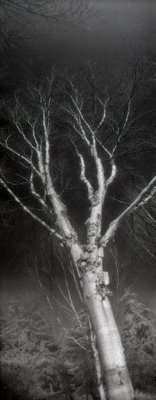
I was walking on 43d Avenue and within sight of my house on Athlone, when I spotted white stuff on my boulevard lawn. I immediately thought of the children from the nearby elementary school who have a habit of throwing the remnants of their lunch on the way home. When I was close I knew I was wrong. I was most pleasantly surprised. A recent wind must have blown off a large swath of the peeling bark of my Betula utilis var. jacquemontii or Himalayan Birch. Any tree as beautiful as this one should require (in my books) a mouthful to pranounce. I first spotted this white ghost (a grove of them) at VanDusen Botanical Garden one late February some 17 years ago. Both Rosemary and I knew we would plant one in our garden. Our specimen has grown quickly and is almost as big as the VanDusen ones. It is a sentinel of my winter garden. Even though I am not an American this tree reminds me (as well as the VanDusen specimens) of Confederate soldiers wearing their bleached grays, standing their ground in spite of an inevitable defeat.

The two panoramic pictures I took in February 1992 when Rosemary said, "Let's go for a walk in VanDusen." I replied, "You must be crazy. What can we see that is of possible interest?" Of course She was right. In my own small way I contributed by bringing along that swivel lensed Widelux loaded with Kodak Infrared film.
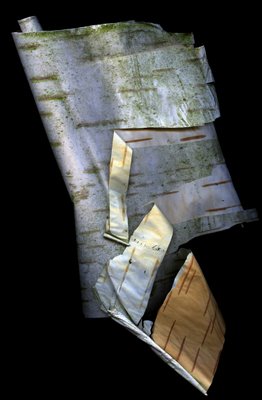
The other two images are scans of the bark I found yesterday. The green comes from the grass that the bark has been on for perhaps a few days or weeks. The brown colour is on the inside. This image I scanned from the bottom, placing the bark on the flatbed scanner. The second image is a double scan. I treated the bark as a transparency and my scanner passed on both the top and bottom simultaneously.

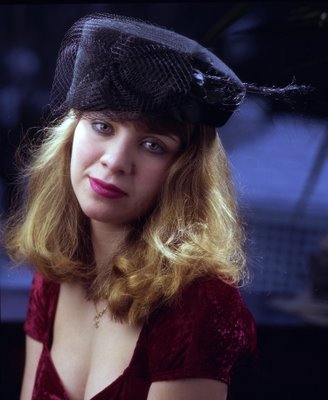
All my life I have been surrounded by women even though I never had a sister. I almost had a little red headed sister but she was born dead. When I was 10, my father left home and left me to the mercy of my mother and grandmother. When I saw my father again in 1965 his first question to me after looking at me with an affection I had missed for so many years was, "How is the old battle ax?" He meant my grandmother, of course. He asked with a smile as he had always liked my grandmother. I think my father loved women, just like me.
Only a couple of days ago at our wedding anniversary dinner at a restaurant I beckoned at Lauren (6) to sit on my lap. Her hair smelled of fresh Granny Smith apple. I made a point to not only enjoy it but to mention it. Her father, Bruce Stewart, said, "I washed her hair this morning." Rebecca (11) asked me, "Papi why do you smell the hair of little girls?" I told her that not only did I smell the hair of women when I could but, like my mother, I also like to smell behind the ears.
My mother used to do that all the time. With perhaps a complete ignorance of Inuit customs she would explain to me when I would ask her (just like Rebecca asked on Sunday night), "Alex Eskimos don't know how to kiss. They like to rub noses and get pleasure from smelling each other." My mother, after smelling me behind my ears often told me I had the exquisite scent of an English gentleman. To this day one of my fondest pleasures is to breathe deeply behind Rosemary's ear (and the other one, too If I have a chance). I don't think that Rebecca quite understands this pleasure yet.
There seems to be much less emphasis these days to the pleasures of scent. There are arts that cater to the eyes and the ears. Even some sculptures beg us to use our sense of touch. But I don't know of any that directly cater to our noses except as an ancillary approach to the art of cuisine (with the further ancillary art of wine sniffing). Rebecca should know better considering that she can identify at least 10 roses in my garden (with her eyes closed) by scent alone.
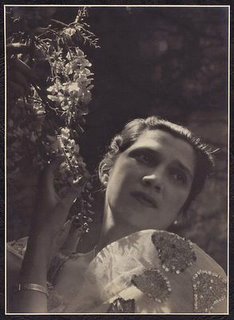
The only scent of a man that I have any memory of is that of my father who used to smell of clean soap laced with an attractive aroma (at least it was then and in my head now) his cigarettes which came in metal tins that read Player's Navy Cut Tobacco.
I like girls and I like girls that smell nice.
My mother used to use Chanel No.5. Few use it now but when I get a whiff of it here and there I always think of my mother. For many years I used to buy Hermes Caleche for Rosemary every time I flew on Japan Airlines to Mexico. They had that delightful perfume in their in-flight catalogue store. But it has been at least 20 years now that both Rosemary and I don't use perfume or any lotions. She insists on unscented deodorant.
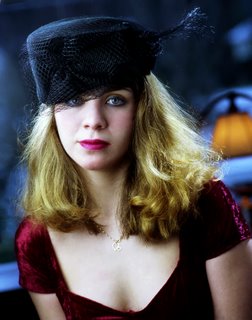
To me a woman who wears a good perfume (I wonder why I didn't remember to tell Rebecca that any woman knows you dab perfume behind your ears!) is doubly a woman. One of the most elegantly feminine women I know is my younger daughter Hilary Stewart. There is a special reason why Hilary is so feminine and elegant. This is because anytime I see her and watch her crooked smile (my crooked smile) I know it came through me from my mother. That smile of Hilary's is the smile of my mother. She inherited, not only that smile but an elegance and grace that my mother had in spades. Taking Hilary to a concert (especially when she dresses up and puts on perfume) is exhilerating. Hilary, quite here and now, as she sits by me with that smile on her face as we listen to the music, is also a ghost. She is my mother's ghost- a most beautiful and elegant ghost inside the living flesh of my daughter Hilary.

In 1971 with the help of my mother, Rosemary and I bought a little house in the outskirts of Mexico City in the State of Mexico. It was called Arboledas and our house was half a block from Los Bebedores. This was a boulevard of huge eucaliptus trees that ended at a tall white concrete wall. Under it were two parallel rectangular pools where the animals that had once grazed in those parts could have had a drink, hence the name bebedoros or "drinking pools". At the time we had only one daughter, she was 3 and her name was Alexandra. Our Mexican neighbours thought that was much too so they called her Ale (pronounced Ah with the le of let). One day our housekeeper came to me, "Señor hay un problema con Ale!" She was on the floor of the kitchen. She looked dead. One of the cabinets was open and I spotted a bottle of Carbona (carbon tetrachloride) an upholstery spot remover. I immediately called our pediatrician who told me to rush her to hospital after inducing vomiting. Something just didn't sound right.
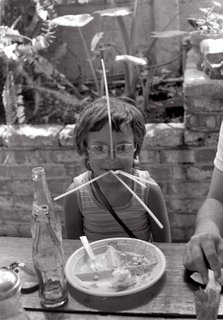
I had been a Boy Scout in my youth and I remember that for some poisons, vomiting could make a situation worse if the poison happened to be corrosive. I rushed Ale to the bathtub and poured cold water on her face. Her eye balls were turned up but the cold water brought some life to her. A neighbourhood acquaintance, a singer called Piruli took me in his car (and calmed me down) to the local doctor just a few blocks away. The kindly doctor immediately came out with a stomach pump and asked me if I had induced vomiting. I nodded to the contrary and he smiled. After Ale was revived he calmly told me, "She would not have made it to the hospital."
A couple of year later our housekeeper Clemen and Ale went for a walk on the Bebederos. Ale decided to pull a wild flower. A nearby little girl shouted, "Don't touch my flowers and threw a large chunk of brick which hit Ale on her forehead. There was lots of bleeding. When I saw Ale I almost fainted (I don't like the sight of blood.) I took Ale to our friend Carlos Zamora's house who made some curious little bandaids with scissors and white adhesive tape. He used them to bring the edges of the gash together. And that was that.

Ale has always been a happy girl but in moderation. Had she been born in the 50s she would have been a hippie. There is a streak of melancholy in her face, behind her smile, that almost breaks my heart. I sometimes wonder if her two near-death experiences made her grow up quickly. I know that Ale is wise beyond her keen intelligence. She is one of those terrible persons who can coast and do extremely well without really trying. She can read a book upside down as fast as I can read a book normally.
As Rosemary and I file all these old pictures and yesterday and we celebrated our 41st wedding anniversary (that always makes me think) I thought that my mother died when I was 30. I find it amazing (more than my wedding anniversary) that my sad looking Ale, So beautiful, so elegant, is 40.
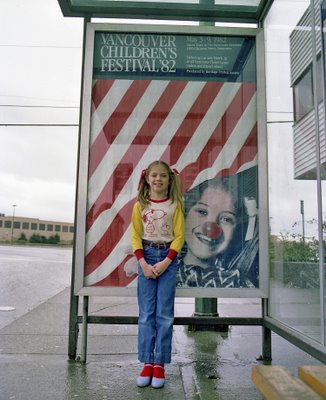
Peripatetic editor Charles Campbell was summarily fired from the Georgia Straight in January 1998. he went to work for the Vancouver Sun. By May he had landed on his feet and he was the editor of a new Thursday Vancouver Sum magazine called Queue. When my wife Rosemary saw it (in a rare lapse of her inability to like almost anything) she declared, "Charles has his magazine." That first issue (May 21 -28) featured a last page little essay called Rear Window. Campbell had told me once that he had conceived of this section thinking of my extensive files. The purpose of Rear Window was to relate some Vancouver event of the past to a present situation. Until Queue finally died some years later I had contributed many essays and pictures. This first one (written in the third person, and this was dropped for the subsequent Rear Windows), which featured a picture I had taken of my daughter Hilary which was used for a poster of the 1982 Vancouver Children's Festival read:

In 1982, the heady days of the big-budget variety shows in the CBC Vancouver Studios 40 and 41 were over. CBC graphic designer Ray Mah was getting restless, and he began to freelance. One of his first projects was the 1982 Vancouver International Children's Festival. He called a photographer, Alex Waterhouse-Hayward, who had taken photos of Rene Simard for one of those CBC variety shows. To this day Waterhouse-Hayward doesn't if he was hired because of his own talents or because Mah had gotten a glimpse of his 10-year-old daughter, whose crooked smile he thought was perfect for the project. The picture was taken in Waterhouse-Hayward’s basement, where he rigged a sheet to mimic the folds of a kid peeking out from behind a festival tent. Hilary is now 26, but some things haven't changed. Her 10-month-old daughter Rebecca, has the same crooked smile, the one she inherited from her grandfather.

To this I can only add that I miss the fact that so many events from our Vancouver past are now so sadly forgotten and few publications go beyond a rosy nostalgia without the perspicacity of Campbell's knowledge that the past has meaning when interpreted with the present.
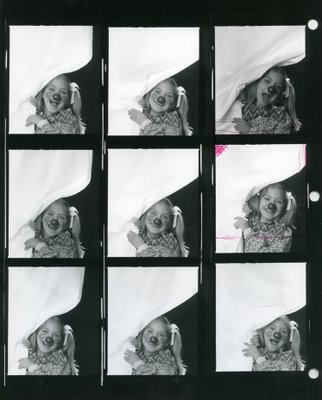
I took the first picture of Hilary here at a bus stop on Willingdon in Burnaby and very close to Lougheed Highway. Ray May is still restless and would perhaps want to re-design my business card which he designed sometime in 1982. When he broaches the subject I tell him that his design was so timeless that even today when I produce my card people ask.

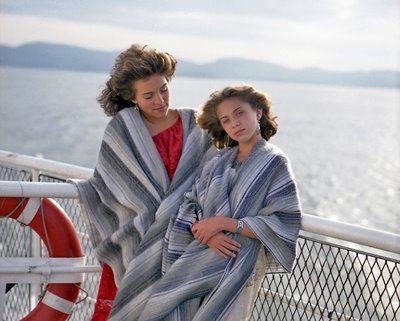
I have written before in this blog on how it is becoming increasingly more difficult for me to have my family make my granddaughters available for photography.
Rosemary and I filed our family pictures beginning with January 2009 and we went as far back as 2001. From then on the pictures, transparencies and negatives are not as well organized. I find pictures but not the negatives and the other way around, too. Eventually all will be organized. Today I happened to find this picture. I took it in 1986 the ferry to Mayne Island. It is near Active Pass.
In 1986 I was riding the crest of the business and city magazine wave. I was making lots of money. I decided to hire artist Jim McKenzie to paint my daughters. Because McKenzie uses a camera first to make his hyper realistic paintings we needed to give him access to Ale and Hilary. At the time McKenzie was well known for his ferry paintings. He know calls himself a West Coast Realist.
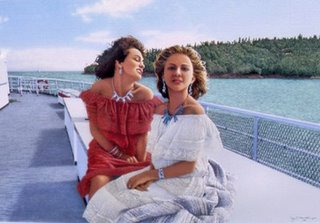
I asked him to photograph them on board. While he was at it I took my own. This one is one of my favourites. In the third picture which I took at the Heffel Gallery on Granville you can see some more McKenzie. The striking woman is not part of the picture. Rosalyn Te Omra worked at the gallery (and still does). I positioned her in such a way so that she is part of the painting which had attracted me in the beginning to hire the McKenzie.
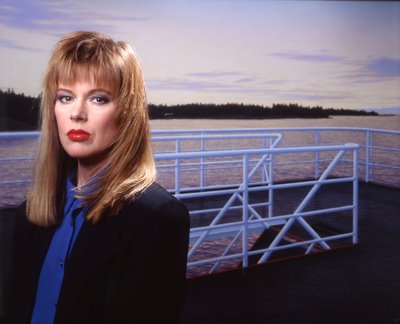
Thinking about the picture, it has ocurred to me that when I photograph Rebecca and Lauren I have had at least 19 years of experience learning how to do it with their mother and aunt!
Now if there were only a new surge in magazine work I would call McKenzie and put Rebecca and Lauren on the ferry to Mayne Island, via Active Pass!
Romance In The BC Ferries

Photographer W. Eugene Smith's idea of a good time was to retreat to his messy darkroom with cigarettes, a bottle of Scotch, good music and a negative to work on.
I began my darkroom activities in 1962 when my artist friend, Robert Hijar, who was getting a fine arts degree at the University of the Americas told me, "I have access to the darkroom. I can teach you to process negatives and to print. But we will have to use the darkroom when nobody else uses it." That time was between midnight and the early hours of the morning. I would arrive all tired at home at 5 in the morning and crash to bed. The funny thing is that even though I was 20 years old my mother did not believe I had been working in a darkroom. She invented all kinds of tawdry affairs of which I was most unlikely to have.
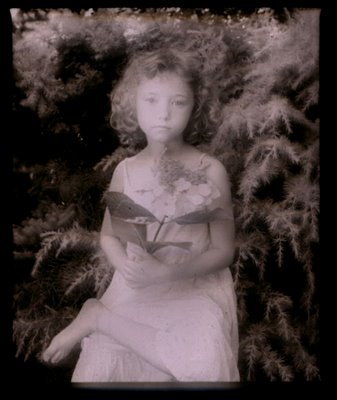
In that darkroom I learned to process film and print it under adverse conditions. The tap water was extremely cold as wa the darkroom. The walls of crumbling dusty bricks were painted white and the second class "Toluca Rocket" bus would rumble past and vibrate the enlarger and ruin my prints. The Rocket had 15 or more forward gears. As it passed by on the steep c the bus would gear down up. But all these adverse conditions were more than compensated by the good company of my friend and his state-of-the-art reel to reel tape recorder (courtesy of his parents who were CIA agents). We listened mostly to what was then called West Coast Jazz. Our favorite was a Stan Getz album called Focus which featured music composed and arranged by Eddie Sauter.
When I eventually had my own darkroom I still worked late nights (and for many years smoked a pipe until one day I got extremely dizzy and quit) but I chose not to play too much music. I loved the noise of the running water washing my prints and the electric sounds of my Charles Beseler enlarger's colour head. It was in the darkroom where I honed my printing style and learned to manipulate negatives which were far from perfect. It was in the darkroom where I learned the futility of cropping negatives under an enlarger and going for the more efficient and elegant method of cropping with my eyes, in camera.
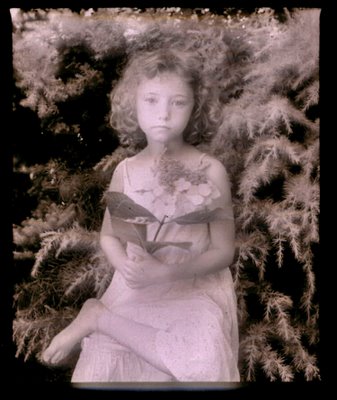
Nobody in my family has wanted to follow me into the darkroom. Rebecca flees the moment she smells the fixer. She says it will cause her problems. I do not tell her that I have used selenium toner for about 40 years and that it is supposed to be a carcinogen.
In the last few years my loneliness in the darkroom has been compounded by a lonely darkroom that rarely sees me. While I process the b+w film that I still happily shoot, more often than not I scan the negative to put an image in this blog or send bigger files to magazines, law firms and other companies that hire me.
Fiddling with a negative on my scanner while I look into the garden is pleasant. It is not dark and I even play Stan Getz's Focus in the stereo set behind me as my computer and scanner are on a Edwardian desk in the living room.

On a day like today, a day in which I have plenty of time to fiddle or as my grandmother used to say: Cuando el diablo no tiene nada que hacer con el rabo espanta moscas.Which translates to: when the devil has nothing to do he swats flies with his tail.
I spend working with the scanner. It is relaxing and fun. I began with a stark negative of Rebecca which I took in 2004 with Kodak Technical Pan Film in the 120 format. This film is the sharpest film ever made by anybody and it has an extended range into red. The film blocks blue and accepts more red. This means that skin blemishes (mostly red) appear lighter or disappear. The result is almost ghostly.
The first image here is the negative scanned more or less as is. In the second one I placed the negative on my scanner and then I covered it with a sheet of white paper. I scanned the negative from below. The scanner gets a bit of the texture of paper. The result is still a negative which when I reverse I get what you see here. The colour I can add in whatever direction I want be it cool or war. In the third image I "corrected" for the opacity of the paper and made it less hazy. In the fourth image I still used the paper but I closed the scanner lid and scanned the negative simultaneously from both sides.
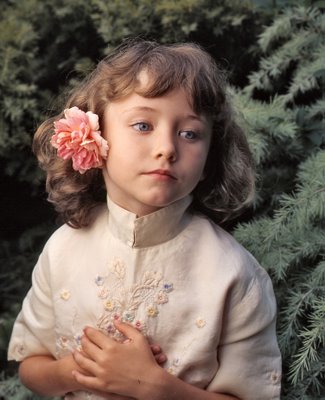
A boat, beneath a sunny sky,
Lingering onward dreamily
In an evening of July -
Children three that nestle near,
Eager eye and willing ear,
Pleased a simple tale to hear -
Long has paled that sunny sky:
Echoes fade and memories die:
Autumn frosts have slain July.
She still haunts me, phantomwise,
Alice moving under skies
Never seen by waking eyes.
Children yet, the tale to hear,
Eager eye and willing ear,
Lovingly shall nestle near.
In Wonderland they lie,
Dreaming as the days go by,
Dreaming as the summers die: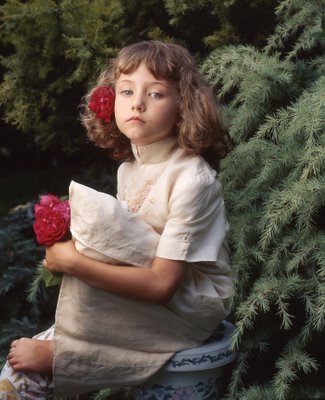
Ever drifting down the stream -
Lingering in the golden gleam -
Life, what is it but a dream?
Lewis Carol, Epilogue to Through the Looking-Glass

Of late I have felt a nostalgia for a hot Buenos Aires midnight at Pizzeria Burgio on Cabildo Avenue. Four years ago in November, Rosemary, Rebecca and I sat at a table on the sidewalk. I ordered a pizza, cokes for the girls and an ice-cold moscato for myself. Rebecca was curious and had a sip. Moscato tastes like very good sweet grape juice, but it isn't! Rebecca loved it. I told her, "Don't tell your other grandmother. She might not approve."
I discern a difference between nostalgia and a longing. I long for spring with the roses in bloom and their crisp aroma. I long for taking pictures of Rebecca and of Lauren as they walk barefoot on the lawn. I can smell it and imagine their delight in the coolness of the grass as its moisture slips between their toes.

In 1967 I went to Mass in Mexico City. I had not attended Mass for some years except in Buenos Aires. To my amazement, at a point during the Mass, perfect strangers on either side of me began to hug me. I could not understand what was happening. It seems that the liturgy reforms of the Vatican Council II (1962-1965) presided by Pope John XIII and Pope Paul VI had somehow passed me by! The other funny thing is that the priest faced us at all times. The mystery of what he had previously done with his back to us was now revealed. A few months later I heard that the church had held a most unusual Mariachi Mass.
Bishop Richard Williamson, of the Society of St Pius X (Fraternitas Sacerdotalis Sancti Pii X, FSSPX) is alive and well and living in Argentina. As a matter of fact he is the head of the Seminario de Nuestra Señora Corredentora (co-redeemer in Spanish) in the outskirts of Buenos Aires in La Reja, Moreno. This seminary is one of many worldwide run by the extremely conservative Society of Saint Pius X. It's South American branch can be found here. There is another rather handsome site here.
There has been a messy uproar of late when the German pope decided to revoke the excomunication of four Bishops (one of them is Williamson) who had originally been consecrated by the ultra-conservative French Archbishop Marcel Lefebvre. Few of the articles on the formerly Enlish and Anglican, but now most Roman Catholic Richard Williamson mention that he is alive and well in Argentina. They find it more important to inform us that this man regards The Sound of Music as satanic, on the grounds that Maria undermined Captain von Trapp's paternal authority.

That fine venerable and orthodox Argentine newspaper La Nación adds an interesting tidbit of Williamson lore. It seems that the young seminarians at La Reja (far shorter than Seminario de Nuestra Señora Corredentora), have to write with fountain pens and are not allowed to watch television. But the conservative Bishop does embrace technology when it is convenient. As a matter of fact La Nación reveals that Williamson has a blog called Dinoscopus and has managed to post 88 times in almost three years. Williamson's cartoon, below left, is from his blog.
I would like to interject here that while Bishop Williamson and I have our differences there are a few points in common. I have blogged not almost three years but a few days more. We are alike in not wanting creeps and idiots to contribute to our blogs so we do not allow comments. We both have ties to the lefebvristas which is how Argentines call ultra conservative Catholics. Williamson's followers are most certainly lefevbristas and I have a grand nephew, a member of the Opus Dei whose father says, "My son is to the right of Lefebvre." Since my grand nephew's father takes things lightly (en joda, as they would say in Argentina) I am not sure if I believe him. He did tell me that his son had invited him to an old-time Mass with incense. He declined saying to his son, "I hate the smell of incense and besides I don't want to spend a whole Mass watching the priest's rear end."
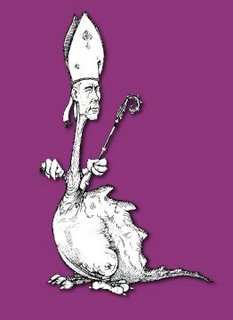
The whole Bishop Williamson brouhaha brings to mind how my wise brothers/teachers of the Congregation of the Holy Cross handled with aplomb a situation that seems almost unreal and funny to me now when I think of it. At St. Ed's High School in Austin, I had a very good friend the first year I was there (1957) when I was in grade 9. His name was John Straney. He had also lived in Mexico and spoke excellent Spanish. In a neighbouring Texas scrub we had built a fort and we played there. We talked about the Nazis and their wonderful tanks and airplanes. We marveled at their cool uniforms. We discussed all the variant models of the Meschersmitt Me-109. One day later in the year he lost interest and never wanted to return to the fort. I did not understand that Straney was growing up faster than I was. For the next three years our relationship cooled and he moved to the more sophisticated circle of a Lee (Buddy)Lytton and John McShane.
It was in his 11th grade that Straney began to publicly assert his belief in the non existence of God. In a Catholic boarding school that can be pretty serious. I remember having various arguments with Straney where I applied every "proof" I knew for the existence of God. I told him of Aristotle's Unmoved Mover to no avail. Straney would not budge. I finally just gave up. But it is only now that I realize that the Brothers of the Holy Cross wisely never took him to task. They did not expell him. They kept their cool. Straney finally guarded his belief to himself. We all graduated in harmony. I have since found out from Lee Lytton that Straney was one of the earliest of our class to die. It is my hope that Straney led a useful and happy life. God or no God I am sure Straney would have happily accompanied me to my favourite church in Mexico City that featured Gregorian Chant. Straney would have admired and enjoyed the juxtaposition of modern architecture with an ancient rite.

I was walking on 43d Avenue and within sight of my house on Athlone, when I spotted white stuff on my boulevard lawn. I immediately thought of the children from the nearby elementary school who have a habit of throwing the remnants of their lunch on the way home. When I was close I knew I was wrong. I was most pleasantly surprised. A recent wind must have blown off a large swath of the peeling bark of my Betula utilis var. jacquemontii or Himalayan Birch. Any tree as beautiful as this one should require (in my books) a mouthful to pranounce. I first spotted this white ghost (a grove of them) at VanDusen Botanical Garden one late February some 17 years ago. Both Rosemary and I knew we would plant one in our garden. Our specimen has grown quickly and is almost as big as the VanDusen ones. It is a sentinel of my winter garden. Even though I am not an American this tree reminds me (as well as the VanDusen specimens) of Confederate soldiers wearing their bleached grays, standing their ground in spite of an inevitable defeat.

The two panoramic pictures I took in February 1992 when Rosemary said, "Let's go for a walk in VanDusen." I replied, "You must be crazy. What can we see that is of possible interest?" Of course She was right. In my own small way I contributed by bringing along that swivel lensed Widelux loaded with Kodak Infrared film.

The other two images are scans of the bark I found yesterday. The green comes from the grass that the bark has been on for perhaps a few days or weeks. The brown colour is on the inside. This image I scanned from the bottom, placing the bark on the flatbed scanner. The second image is a double scan. I treated the bark as a transparency and my scanner passed on both the top and bottom simultaneously.

Scent, Memory & That Most Feminine Hilary Stewart
Tuesday, February 10, 2009

All my life I have been surrounded by women even though I never had a sister. I almost had a little red headed sister but she was born dead. When I was 10, my father left home and left me to the mercy of my mother and grandmother. When I saw my father again in 1965 his first question to me after looking at me with an affection I had missed for so many years was, "How is the old battle ax?" He meant my grandmother, of course. He asked with a smile as he had always liked my grandmother. I think my father loved women, just like me.
Only a couple of days ago at our wedding anniversary dinner at a restaurant I beckoned at Lauren (6) to sit on my lap. Her hair smelled of fresh Granny Smith apple. I made a point to not only enjoy it but to mention it. Her father, Bruce Stewart, said, "I washed her hair this morning." Rebecca (11) asked me, "Papi why do you smell the hair of little girls?" I told her that not only did I smell the hair of women when I could but, like my mother, I also like to smell behind the ears.
My mother used to do that all the time. With perhaps a complete ignorance of Inuit customs she would explain to me when I would ask her (just like Rebecca asked on Sunday night), "Alex Eskimos don't know how to kiss. They like to rub noses and get pleasure from smelling each other." My mother, after smelling me behind my ears often told me I had the exquisite scent of an English gentleman. To this day one of my fondest pleasures is to breathe deeply behind Rosemary's ear (and the other one, too If I have a chance). I don't think that Rebecca quite understands this pleasure yet.
There seems to be much less emphasis these days to the pleasures of scent. There are arts that cater to the eyes and the ears. Even some sculptures beg us to use our sense of touch. But I don't know of any that directly cater to our noses except as an ancillary approach to the art of cuisine (with the further ancillary art of wine sniffing). Rebecca should know better considering that she can identify at least 10 roses in my garden (with her eyes closed) by scent alone.

The only scent of a man that I have any memory of is that of my father who used to smell of clean soap laced with an attractive aroma (at least it was then and in my head now) his cigarettes which came in metal tins that read Player's Navy Cut Tobacco.
I like girls and I like girls that smell nice.
My mother used to use Chanel No.5. Few use it now but when I get a whiff of it here and there I always think of my mother. For many years I used to buy Hermes Caleche for Rosemary every time I flew on Japan Airlines to Mexico. They had that delightful perfume in their in-flight catalogue store. But it has been at least 20 years now that both Rosemary and I don't use perfume or any lotions. She insists on unscented deodorant.

To me a woman who wears a good perfume (I wonder why I didn't remember to tell Rebecca that any woman knows you dab perfume behind your ears!) is doubly a woman. One of the most elegantly feminine women I know is my younger daughter Hilary Stewart. There is a special reason why Hilary is so feminine and elegant. This is because anytime I see her and watch her crooked smile (my crooked smile) I know it came through me from my mother. That smile of Hilary's is the smile of my mother. She inherited, not only that smile but an elegance and grace that my mother had in spades. Taking Hilary to a concert (especially when she dresses up and puts on perfume) is exhilerating. Hilary, quite here and now, as she sits by me with that smile on her face as we listen to the music, is also a ghost. She is my mother's ghost- a most beautiful and elegant ghost inside the living flesh of my daughter Hilary.
Alexandra Elizabeth's Happy Melancholy
Monday, February 09, 2009

In 1971 with the help of my mother, Rosemary and I bought a little house in the outskirts of Mexico City in the State of Mexico. It was called Arboledas and our house was half a block from Los Bebedores. This was a boulevard of huge eucaliptus trees that ended at a tall white concrete wall. Under it were two parallel rectangular pools where the animals that had once grazed in those parts could have had a drink, hence the name bebedoros or "drinking pools". At the time we had only one daughter, she was 3 and her name was Alexandra. Our Mexican neighbours thought that was much too so they called her Ale (pronounced Ah with the le of let). One day our housekeeper came to me, "Señor hay un problema con Ale!" She was on the floor of the kitchen. She looked dead. One of the cabinets was open and I spotted a bottle of Carbona (carbon tetrachloride) an upholstery spot remover. I immediately called our pediatrician who told me to rush her to hospital after inducing vomiting. Something just didn't sound right.

I had been a Boy Scout in my youth and I remember that for some poisons, vomiting could make a situation worse if the poison happened to be corrosive. I rushed Ale to the bathtub and poured cold water on her face. Her eye balls were turned up but the cold water brought some life to her. A neighbourhood acquaintance, a singer called Piruli took me in his car (and calmed me down) to the local doctor just a few blocks away. The kindly doctor immediately came out with a stomach pump and asked me if I had induced vomiting. I nodded to the contrary and he smiled. After Ale was revived he calmly told me, "She would not have made it to the hospital."
A couple of year later our housekeeper Clemen and Ale went for a walk on the Bebederos. Ale decided to pull a wild flower. A nearby little girl shouted, "Don't touch my flowers and threw a large chunk of brick which hit Ale on her forehead. There was lots of bleeding. When I saw Ale I almost fainted (I don't like the sight of blood.) I took Ale to our friend Carlos Zamora's house who made some curious little bandaids with scissors and white adhesive tape. He used them to bring the edges of the gash together. And that was that.

Ale has always been a happy girl but in moderation. Had she been born in the 50s she would have been a hippie. There is a streak of melancholy in her face, behind her smile, that almost breaks my heart. I sometimes wonder if her two near-death experiences made her grow up quickly. I know that Ale is wise beyond her keen intelligence. She is one of those terrible persons who can coast and do extremely well without really trying. She can read a book upside down as fast as I can read a book normally.
As Rosemary and I file all these old pictures and yesterday and we celebrated our 41st wedding anniversary (that always makes me think) I thought that my mother died when I was 30. I find it amazing (more than my wedding anniversary) that my sad looking Ale, So beautiful, so elegant, is 40.
A Peripatetic Charles Campbell, A Restless Ray Mah & Hilary's Red Ball Nose
Sunday, February 08, 2009

Peripatetic editor Charles Campbell was summarily fired from the Georgia Straight in January 1998. he went to work for the Vancouver Sun. By May he had landed on his feet and he was the editor of a new Thursday Vancouver Sum magazine called Queue. When my wife Rosemary saw it (in a rare lapse of her inability to like almost anything) she declared, "Charles has his magazine." That first issue (May 21 -28) featured a last page little essay called Rear Window. Campbell had told me once that he had conceived of this section thinking of my extensive files. The purpose of Rear Window was to relate some Vancouver event of the past to a present situation. Until Queue finally died some years later I had contributed many essays and pictures. This first one (written in the third person, and this was dropped for the subsequent Rear Windows), which featured a picture I had taken of my daughter Hilary which was used for a poster of the 1982 Vancouver Children's Festival read:

In 1982, the heady days of the big-budget variety shows in the CBC Vancouver Studios 40 and 41 were over. CBC graphic designer Ray Mah was getting restless, and he began to freelance. One of his first projects was the 1982 Vancouver International Children's Festival. He called a photographer, Alex Waterhouse-Hayward, who had taken photos of Rene Simard for one of those CBC variety shows. To this day Waterhouse-Hayward doesn't if he was hired because of his own talents or because Mah had gotten a glimpse of his 10-year-old daughter, whose crooked smile he thought was perfect for the project. The picture was taken in Waterhouse-Hayward’s basement, where he rigged a sheet to mimic the folds of a kid peeking out from behind a festival tent. Hilary is now 26, but some things haven't changed. Her 10-month-old daughter Rebecca, has the same crooked smile, the one she inherited from her grandfather.

To this I can only add that I miss the fact that so many events from our Vancouver past are now so sadly forgotten and few publications go beyond a rosy nostalgia without the perspicacity of Campbell's knowledge that the past has meaning when interpreted with the present.

I took the first picture of Hilary here at a bus stop on Willingdon in Burnaby and very close to Lougheed Highway. Ray May is still restless and would perhaps want to re-design my business card which he designed sometime in 1982. When he broaches the subject I tell him that his design was so timeless that even today when I produce my card people ask.

Ale & Hilary - Active Pass To Mayne Island
Saturday, February 07, 2009

I have written before in this blog on how it is becoming increasingly more difficult for me to have my family make my granddaughters available for photography.
Rosemary and I filed our family pictures beginning with January 2009 and we went as far back as 2001. From then on the pictures, transparencies and negatives are not as well organized. I find pictures but not the negatives and the other way around, too. Eventually all will be organized. Today I happened to find this picture. I took it in 1986 the ferry to Mayne Island. It is near Active Pass.
In 1986 I was riding the crest of the business and city magazine wave. I was making lots of money. I decided to hire artist Jim McKenzie to paint my daughters. Because McKenzie uses a camera first to make his hyper realistic paintings we needed to give him access to Ale and Hilary. At the time McKenzie was well known for his ferry paintings. He know calls himself a West Coast Realist.

I asked him to photograph them on board. While he was at it I took my own. This one is one of my favourites. In the third picture which I took at the Heffel Gallery on Granville you can see some more McKenzie. The striking woman is not part of the picture. Rosalyn Te Omra worked at the gallery (and still does). I positioned her in such a way so that she is part of the painting which had attracted me in the beginning to hire the McKenzie.

Thinking about the picture, it has ocurred to me that when I photograph Rebecca and Lauren I have had at least 19 years of experience learning how to do it with their mother and aunt!
Now if there were only a new surge in magazine work I would call McKenzie and put Rebecca and Lauren on the ferry to Mayne Island, via Active Pass!
Romance In The BC Ferries
Focus In The Darkroom
Friday, February 06, 2009

Photographer W. Eugene Smith's idea of a good time was to retreat to his messy darkroom with cigarettes, a bottle of Scotch, good music and a negative to work on.
I began my darkroom activities in 1962 when my artist friend, Robert Hijar, who was getting a fine arts degree at the University of the Americas told me, "I have access to the darkroom. I can teach you to process negatives and to print. But we will have to use the darkroom when nobody else uses it." That time was between midnight and the early hours of the morning. I would arrive all tired at home at 5 in the morning and crash to bed. The funny thing is that even though I was 20 years old my mother did not believe I had been working in a darkroom. She invented all kinds of tawdry affairs of which I was most unlikely to have.

In that darkroom I learned to process film and print it under adverse conditions. The tap water was extremely cold as wa the darkroom. The walls of crumbling dusty bricks were painted white and the second class "Toluca Rocket" bus would rumble past and vibrate the enlarger and ruin my prints. The Rocket had 15 or more forward gears. As it passed by on the steep c the bus would gear down up. But all these adverse conditions were more than compensated by the good company of my friend and his state-of-the-art reel to reel tape recorder (courtesy of his parents who were CIA agents). We listened mostly to what was then called West Coast Jazz. Our favorite was a Stan Getz album called Focus which featured music composed and arranged by Eddie Sauter.
When I eventually had my own darkroom I still worked late nights (and for many years smoked a pipe until one day I got extremely dizzy and quit) but I chose not to play too much music. I loved the noise of the running water washing my prints and the electric sounds of my Charles Beseler enlarger's colour head. It was in the darkroom where I honed my printing style and learned to manipulate negatives which were far from perfect. It was in the darkroom where I learned the futility of cropping negatives under an enlarger and going for the more efficient and elegant method of cropping with my eyes, in camera.

Nobody in my family has wanted to follow me into the darkroom. Rebecca flees the moment she smells the fixer. She says it will cause her problems. I do not tell her that I have used selenium toner for about 40 years and that it is supposed to be a carcinogen.
In the last few years my loneliness in the darkroom has been compounded by a lonely darkroom that rarely sees me. While I process the b+w film that I still happily shoot, more often than not I scan the negative to put an image in this blog or send bigger files to magazines, law firms and other companies that hire me.
Fiddling with a negative on my scanner while I look into the garden is pleasant. It is not dark and I even play Stan Getz's Focus in the stereo set behind me as my computer and scanner are on a Edwardian desk in the living room.

On a day like today, a day in which I have plenty of time to fiddle or as my grandmother used to say: Cuando el diablo no tiene nada que hacer con el rabo espanta moscas.Which translates to: when the devil has nothing to do he swats flies with his tail.
I spend working with the scanner. It is relaxing and fun. I began with a stark negative of Rebecca which I took in 2004 with Kodak Technical Pan Film in the 120 format. This film is the sharpest film ever made by anybody and it has an extended range into red. The film blocks blue and accepts more red. This means that skin blemishes (mostly red) appear lighter or disappear. The result is almost ghostly.
The first image here is the negative scanned more or less as is. In the second one I placed the negative on my scanner and then I covered it with a sheet of white paper. I scanned the negative from below. The scanner gets a bit of the texture of paper. The result is still a negative which when I reverse I get what you see here. The colour I can add in whatever direction I want be it cool or war. In the third image I "corrected" for the opacity of the paper and made it less hazy. In the fourth image I still used the paper but I closed the scanner lid and scanned the negative simultaneously from both sides.
Longing Is Not Nostalgia But It Is As Sweet
Thursday, February 05, 2009

A boat, beneath a sunny sky,
Lingering onward dreamily
In an evening of July -
Children three that nestle near,
Eager eye and willing ear,
Pleased a simple tale to hear -
Long has paled that sunny sky:
Echoes fade and memories die:
Autumn frosts have slain July.
She still haunts me, phantomwise,
Alice moving under skies
Never seen by waking eyes.
Children yet, the tale to hear,
Eager eye and willing ear,
Lovingly shall nestle near.
In Wonderland they lie,
Dreaming as the days go by,
Dreaming as the summers die:

Ever drifting down the stream -
Lingering in the golden gleam -
Life, what is it but a dream?
Lewis Carol, Epilogue to Through the Looking-Glass

Of late I have felt a nostalgia for a hot Buenos Aires midnight at Pizzeria Burgio on Cabildo Avenue. Four years ago in November, Rosemary, Rebecca and I sat at a table on the sidewalk. I ordered a pizza, cokes for the girls and an ice-cold moscato for myself. Rebecca was curious and had a sip. Moscato tastes like very good sweet grape juice, but it isn't! Rebecca loved it. I told her, "Don't tell your other grandmother. She might not approve."
I discern a difference between nostalgia and a longing. I long for spring with the roses in bloom and their crisp aroma. I long for taking pictures of Rebecca and of Lauren as they walk barefoot on the lawn. I can smell it and imagine their delight in the coolness of the grass as its moisture slips between their toes.
The Dinoscopus & John M. Straney
Wednesday, February 04, 2009
In 1967 I went to Mass in Mexico City. I had not attended Mass for some years except in Buenos Aires. To my amazement, at a point during the Mass, perfect strangers on either side of me began to hug me. I could not understand what was happening. It seems that the liturgy reforms of the Vatican Council II (1962-1965) presided by Pope John XIII and Pope Paul VI had somehow passed me by! The other funny thing is that the priest faced us at all times. The mystery of what he had previously done with his back to us was now revealed. A few months later I heard that the church had held a most unusual Mariachi Mass.
Bishop Richard Williamson, of the Society of St Pius X (Fraternitas Sacerdotalis Sancti Pii X, FSSPX) is alive and well and living in Argentina. As a matter of fact he is the head of the Seminario de Nuestra Señora Corredentora (co-redeemer in Spanish) in the outskirts of Buenos Aires in La Reja, Moreno. This seminary is one of many worldwide run by the extremely conservative Society of Saint Pius X. It's South American branch can be found here. There is another rather handsome site here.
There has been a messy uproar of late when the German pope decided to revoke the excomunication of four Bishops (one of them is Williamson) who had originally been consecrated by the ultra-conservative French Archbishop Marcel Lefebvre. Few of the articles on the formerly Enlish and Anglican, but now most Roman Catholic Richard Williamson mention that he is alive and well in Argentina. They find it more important to inform us that this man regards The Sound of Music as satanic, on the grounds that Maria undermined Captain von Trapp's paternal authority.

That fine venerable and orthodox Argentine newspaper La Nación adds an interesting tidbit of Williamson lore. It seems that the young seminarians at La Reja (far shorter than Seminario de Nuestra Señora Corredentora), have to write with fountain pens and are not allowed to watch television. But the conservative Bishop does embrace technology when it is convenient. As a matter of fact La Nación reveals that Williamson has a blog called Dinoscopus and has managed to post 88 times in almost three years. Williamson's cartoon, below left, is from his blog.
I would like to interject here that while Bishop Williamson and I have our differences there are a few points in common. I have blogged not almost three years but a few days more. We are alike in not wanting creeps and idiots to contribute to our blogs so we do not allow comments. We both have ties to the lefebvristas which is how Argentines call ultra conservative Catholics. Williamson's followers are most certainly lefevbristas and I have a grand nephew, a member of the Opus Dei whose father says, "My son is to the right of Lefebvre." Since my grand nephew's father takes things lightly (en joda, as they would say in Argentina) I am not sure if I believe him. He did tell me that his son had invited him to an old-time Mass with incense. He declined saying to his son, "I hate the smell of incense and besides I don't want to spend a whole Mass watching the priest's rear end."

The whole Bishop Williamson brouhaha brings to mind how my wise brothers/teachers of the Congregation of the Holy Cross handled with aplomb a situation that seems almost unreal and funny to me now when I think of it. At St. Ed's High School in Austin, I had a very good friend the first year I was there (1957) when I was in grade 9. His name was John Straney. He had also lived in Mexico and spoke excellent Spanish. In a neighbouring Texas scrub we had built a fort and we played there. We talked about the Nazis and their wonderful tanks and airplanes. We marveled at their cool uniforms. We discussed all the variant models of the Meschersmitt Me-109. One day later in the year he lost interest and never wanted to return to the fort. I did not understand that Straney was growing up faster than I was. For the next three years our relationship cooled and he moved to the more sophisticated circle of a Lee (Buddy)Lytton and John McShane.
It was in his 11th grade that Straney began to publicly assert his belief in the non existence of God. In a Catholic boarding school that can be pretty serious. I remember having various arguments with Straney where I applied every "proof" I knew for the existence of God. I told him of Aristotle's Unmoved Mover to no avail. Straney would not budge. I finally just gave up. But it is only now that I realize that the Brothers of the Holy Cross wisely never took him to task. They did not expell him. They kept their cool. Straney finally guarded his belief to himself. We all graduated in harmony. I have since found out from Lee Lytton that Straney was one of the earliest of our class to die. It is my hope that Straney led a useful and happy life. God or no God I am sure Straney would have happily accompanied me to my favourite church in Mexico City that featured Gregorian Chant. Straney would have admired and enjoyed the juxtaposition of modern architecture with an ancient rite.
Tuesday, February 03, 2009
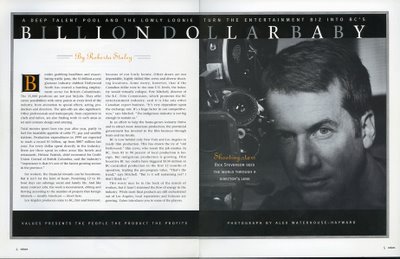
This morning I walked on the "Cambied" area of Granville Street, between Drake and West Georgia. I entered Leo's Camera Supply and thought about a column, written by Pete McMartin, that I had read earlier in the Vancouver Sun. It was about Granville Street, but further south by 16th Avenue.
Pete McMartin wrote a passionate protest against the B.C. Supreme Court Justice Sunni Stromberg-Stein's ruling that Falung Gong must remove a shack and a row of billboards the group has maintained in front of the Chinese consulate since 2001.
Mr. Mc Martin wrote:
Now I would not dare to fault the judge's decision. She was just doing her job and interpreting the law as she saw it. But what do I find fault with?
Here, in the city of Bob Hunter and Greenpeace, of Harry Rankin, of the country's most vibrant social activism, there has been a disturbing silence. The most disturbing silence of all can be found at city hall...
As it has increasingly become more difficult for me to find my way to one of my two favourite camera supply stores in town, (the other is Beau Photo on 6th and Granville) because of constant construction and blocking of streets I have thought that my difficulty is nothing compared to the problem of running a camera supply store in the 21st century with the added injury of curtailed access.
Vancouver is blessed in having several photo labs. Those legions who shoot digital and do not need film to be processed might explore the beautiful light jet prints (only available in these labs) that can transform a digital file into a work of art. Vancouver is blessed in having several photo stores that compete with the best that New York has to offer. These are Leo' and Beau Photo. Leo's in particular has that smell, an exciting smell that comes from the metal of some of those film cameras that were indeed made of metal and not of policarbonates It is a smell that an oldie like me would say is the smell of a real camera store.
What makes these stores a Vancouver treasure is that they stock stuff that you would have to look at length to find on line. Walking into Leo's you see state-of-the-art Canons (the ones you need car loans to buy) but you also see Leicas and beefy dangerous looking motor driven Nikon F3s. The young men who work at Leo's know their stuff and some more.
What do you need to pack in your camera bag to take pictures at Machu Picchu? Ask David Donaldson. Peter Foweraker will tell you the subtle differences in using developer HC-110 in Dilution B or C and throw a really good used camera bag in the bargain. If your DSLR card is noted as corrupted on you computer, after your trip back from the Antarctic, you can bet that Chris Screech will somehow retrieve those valuable pictures.
But it is Jeff Jin whom I usually consult the most. He will explain that the LCD's of a flat screen monitor glow when they are turned off so that it is difficult to get a real black with some of them. You are having problems with your PC's mating with Photoshop? Jin who is an expert with his Mac will not tell you how sorry (and stupid you are) in that you don't also have a Mac, but will actually help you solve the problem.
For years I have more or less had a successful photographic business. I always like to point out that the necessary ingredient for success in Vancouver is a good support staff. You need a good repairman ( Horst Wenzel), someone to keep your flashes going (Viktor) a good lab (George King, The Lab, ABC Photocolour) a good drum scanner and giclée printer (that's Grant Simmons at DISC). And of course a good store. Besides Leo's and Beau Photo I have found stuff at Lens and Shutter and used bargains at Kerrisdale Camera Supply.
I am sure that you might just get that DSLR you want cheaper by mail order or by going to the Future Shop. But it is a Leo's where they will patiently tell you how it works. They are part of that necessary support staff.
To keep these treasures in Vancouver thriving one has to do business with them. Instead of clicking on that computer I would rather hop on my B-Line Bus and go to Leo's or to be wowed by the incredible variety of film stock at Beau. I like to linger, talk to the boys (there are girls at Beau, too!) and perhaps run into photographers that I know.
In 1999 I had a sweet job to take pictures for a magazine published by the BC Central Credit Union. The art director, Chris Dahl insisted I photograph one of my subjects, a film director, with a movie camera. That seemed easy. It wasn't. It was a busy film weekend. I could not find a camera at Panavision. Nobody would rent me an Arriflex.
In desperation I went to Leo's. I asked Jef Lin, "Can you help?" He answered, "We have three. Which model do you want?" I left minutes later with a beautiful Arriflex (seen in the picture above with director Rick Stevenson. Incredibly, Gin took a chance and I walked with the simple signing of a paper. When you do business with good people the trust is mutual.
Returning to the Pete McMartin column he writes about Bob Hunter and Harry Rankin. He is absolutely right. But I think that if McMartin went out to the street he would be hard-pressed to find anyone who would know who those fine and dead gentleman were.
That is our tragedy. In Vancouver we not only miss that which we no longer have but we sometimes compound it by forgetting we had it at all.

My concept of music and sound was just about like everybody else's until sometime around 1959 when Brother Edwin Reggio CSC looked at me straight in the face and said, "I need an alto saxophone player for the school band and you are going to be it." Even though he was not taller that I was, he was strongly built and I felt I could not refuse the man.
I was never anything more than an efficient player. I could get a very sweet and mellow sound from my instrument but I compensated adversely by not reading music well. I was good enough not only to play for the school band but also for the special swing band. I learned to watch Brother Edwin's short, but well toned arms as he directed us in playing such classics as Sweet Lorraine, Stars and Stripes Forever and Cherry Pink And Apple Blossom White. With the swing band we played stuff like Basin Street Blues and Dixieland tunes that pushed my musical reading limits.
One day I asked Brother Edwin the difference between a cornet and a trumpet. His answer was short and strange, "A cornet blends better with a Bb clarinet." I have long since determined that Brother Edwin was absolutely right." That small musical lesson inspired me to listen to the sounds of different instruments and to discern the differences. In the evenings in our 10th grade dormitory (about 40 students in bunkbeds in a dormitory so Gothic and high that in wet weather I swore I could see clouds drifting into it) our prefect, Brother Rene Lenhard played his favourite classical records. My personal favourite was Ravel's Bolero because almost each instrument (particularly that wonderful trombone)had a solo. It was my "Young Person's Guide to the Orchestra" before I knew the existence of Benjamin Britten or Henry Purcell.
My interest in playing the alto saxophone faded as soon as I left the school. But my rudimentary knowledge of the instrument made me appreciate the tones of such jazz players as Paul Desmond, Stan Getz, Gerry Mulligan, Ben Webster, Lester Young and Zoot Sims. I tried to get clear sounds out of the oboes and clarinets of my fellow band members. I could not. I learned to respect those who play these difficult instruments.
I sailed smoothly from mono to stereo and bypassed quadraphonic recordings. I suffered with the wow and cassettes. By 1970 most of my high school students in Mexico City had heard that my mother was deaf and that somehow she had taught me to lip read. The rumours flew in the school. The truth is that I had developed not only a keen ear for sounds, even from subdued conversations from the last rows of my classroom, but also an ability (one that I retain to this day) of being able to listen to several conversations at the same time.
At about this time I switched from enjoying cowboy, pirate and war movies to the sexier European films of Antonioni and other Italian masters. I remember when Rosemary and I saw the 2001 - The Space Odyssey around 1969 in a brand new Mexico City theatre that had advanced sound. It was exhilerating. It was also at this time that I noticed some advances in how sound was used in films. You would as an example watch a nomad on a camel transversing the side of a sand dune when suddenly you could hear the sounds of a piano. In what seemed a long moment of time the scene would change to an exotic Cairo bar and focus on the hands of a pianist. I found this technique interesting and I liked that it was non-linear.
But I was still shocked sometime in the late 70s when I saw Robert Altman's Nashville. The sound was revolutionary. The sound was like the different simultaneous conversations of my students in class back in Mexico City. At first I thought this director, this Robert Altman (I had never heard of him before) was nuts. Then I began to appreciate that, at long last, someone was recording conversation as it truly happens. Since Nashville I have seen most of his films and I particularly enjoyed watching The Company (2003) with Rebecca a couple of years back. Any film that has a backstage, a stage and an audience (this film was about the Joffrey Ballet) is Altman territory with all those simultaneous conversations behind and in front of the curtain.
Tonight, without knowing that it was an Altman film (but I caught on in minutes) Rosemary and I saw most of his last film, the 2006 A Prarie Home Companion. It has that stage, that back stage, that audience, a recently dead man and a white trenchcoat woman with a double role, she plays an angel and the angel of death. There was no cornet or clarinet in sight but I appreciate to this day Brother Edwin's lesson. He taught me not only the value of sound but to appreciate its importance in the making of a good film.
In the picture above, taken by Brother Edwin with his Konica in 1960, that's me, top left.
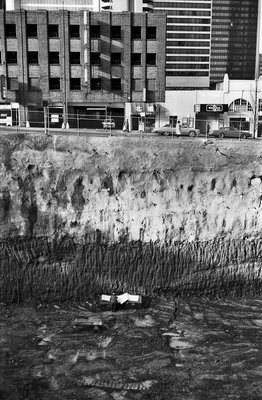
I took this photograph in 1984. While in my youth (in the 60s ) I would have never been caught going anywhere without a camera, by the 80s I only had one with me when when working for a paying magazine or corporate job. Through the years I have attempted to hang a little camera around my neck and take pictures wherever I go. I get ambitious and then frustrated thinking that I should have brought a tripod, or another lens, or colour film, etc. Within days my determination to have a camera with me falters and that's it.
Around 1980 I obtained a good deal on a Minolta camera that could accomodate Leica thread lenses. My Minolta CLE came with a wide angle, a normal lens and a telephoto. For a while I went everywhere with it. When I saw this hole (the corner of West Georgia with Howe I snapped a few. In retrospect I should have had the camera on a tripod as the picture is slightly fuzzy.
The hole became the Bank of British Columbia and its last director was Edgar Kaiser Jr. The bank folded and was taken over by the Hong Kong Bank.
Yesterday while going through the Stephen Drake files (for yesterday's blog) I found an envelope that did not belong there. It said:
Bank of Hong Kong
Hong Kong Bank
Construction hole
Every time I think of this bank and of the Hotel Vancouver (or is it the Vancouver Hotel?) I have the problem. That is why the envelope had both names.
I had lost the two negatives around 1990. Losing any of my pictures is painful. I am glad to have found them. Notice on the top right the name of the bar, Bradley's. It was run by Gary Taylor. It was a place that I haunted for some years.

This morning I walked on the "Cambied" area of Granville Street, between Drake and West Georgia. I entered Leo's Camera Supply and thought about a column, written by Pete McMartin, that I had read earlier in the Vancouver Sun. It was about Granville Street, but further south by 16th Avenue.
Pete McMartin wrote a passionate protest against the B.C. Supreme Court Justice Sunni Stromberg-Stein's ruling that Falung Gong must remove a shack and a row of billboards the group has maintained in front of the Chinese consulate since 2001.
Mr. Mc Martin wrote:
Now I would not dare to fault the judge's decision. She was just doing her job and interpreting the law as she saw it. But what do I find fault with?
Here, in the city of Bob Hunter and Greenpeace, of Harry Rankin, of the country's most vibrant social activism, there has been a disturbing silence. The most disturbing silence of all can be found at city hall...
As it has increasingly become more difficult for me to find my way to one of my two favourite camera supply stores in town, (the other is Beau Photo on 6th and Granville) because of constant construction and blocking of streets I have thought that my difficulty is nothing compared to the problem of running a camera supply store in the 21st century with the added injury of curtailed access.
Vancouver is blessed in having several photo labs. Those legions who shoot digital and do not need film to be processed might explore the beautiful light jet prints (only available in these labs) that can transform a digital file into a work of art. Vancouver is blessed in having several photo stores that compete with the best that New York has to offer. These are Leo' and Beau Photo. Leo's in particular has that smell, an exciting smell that comes from the metal of some of those film cameras that were indeed made of metal and not of policarbonates It is a smell that an oldie like me would say is the smell of a real camera store.
What makes these stores a Vancouver treasure is that they stock stuff that you would have to look at length to find on line. Walking into Leo's you see state-of-the-art Canons (the ones you need car loans to buy) but you also see Leicas and beefy dangerous looking motor driven Nikon F3s. The young men who work at Leo's know their stuff and some more.
What do you need to pack in your camera bag to take pictures at Machu Picchu? Ask David Donaldson. Peter Foweraker will tell you the subtle differences in using developer HC-110 in Dilution B or C and throw a really good used camera bag in the bargain. If your DSLR card is noted as corrupted on you computer, after your trip back from the Antarctic, you can bet that Chris Screech will somehow retrieve those valuable pictures.
But it is Jeff Jin whom I usually consult the most. He will explain that the LCD's of a flat screen monitor glow when they are turned off so that it is difficult to get a real black with some of them. You are having problems with your PC's mating with Photoshop? Jin who is an expert with his Mac will not tell you how sorry (and stupid you are) in that you don't also have a Mac, but will actually help you solve the problem.
For years I have more or less had a successful photographic business. I always like to point out that the necessary ingredient for success in Vancouver is a good support staff. You need a good repairman ( Horst Wenzel), someone to keep your flashes going (Viktor) a good lab (George King, The Lab, ABC Photocolour) a good drum scanner and giclée printer (that's Grant Simmons at DISC). And of course a good store. Besides Leo's and Beau Photo I have found stuff at Lens and Shutter and used bargains at Kerrisdale Camera Supply.
I am sure that you might just get that DSLR you want cheaper by mail order or by going to the Future Shop. But it is a Leo's where they will patiently tell you how it works. They are part of that necessary support staff.
To keep these treasures in Vancouver thriving one has to do business with them. Instead of clicking on that computer I would rather hop on my B-Line Bus and go to Leo's or to be wowed by the incredible variety of film stock at Beau. I like to linger, talk to the boys (there are girls at Beau, too!) and perhaps run into photographers that I know.
In 1999 I had a sweet job to take pictures for a magazine published by the BC Central Credit Union. The art director, Chris Dahl insisted I photograph one of my subjects, a film director, with a movie camera. That seemed easy. It wasn't. It was a busy film weekend. I could not find a camera at Panavision. Nobody would rent me an Arriflex.
In desperation I went to Leo's. I asked Jef Lin, "Can you help?" He answered, "We have three. Which model do you want?" I left minutes later with a beautiful Arriflex (seen in the picture above with director Rick Stevenson. Incredibly, Gin took a chance and I walked with the simple signing of a paper. When you do business with good people the trust is mutual.
Returning to the Pete McMartin column he writes about Bob Hunter and Harry Rankin. He is absolutely right. But I think that if McMartin went out to the street he would be hard-pressed to find anyone who would know who those fine and dead gentleman were.
That is our tragedy. In Vancouver we not only miss that which we no longer have but we sometimes compound it by forgetting we had it at all.
Robert Altman - A Cornet & A Bb Clarinet
Monday, February 02, 2009

My concept of music and sound was just about like everybody else's until sometime around 1959 when Brother Edwin Reggio CSC looked at me straight in the face and said, "I need an alto saxophone player for the school band and you are going to be it." Even though he was not taller that I was, he was strongly built and I felt I could not refuse the man.
I was never anything more than an efficient player. I could get a very sweet and mellow sound from my instrument but I compensated adversely by not reading music well. I was good enough not only to play for the school band but also for the special swing band. I learned to watch Brother Edwin's short, but well toned arms as he directed us in playing such classics as Sweet Lorraine, Stars and Stripes Forever and Cherry Pink And Apple Blossom White. With the swing band we played stuff like Basin Street Blues and Dixieland tunes that pushed my musical reading limits.
One day I asked Brother Edwin the difference between a cornet and a trumpet. His answer was short and strange, "A cornet blends better with a Bb clarinet." I have long since determined that Brother Edwin was absolutely right." That small musical lesson inspired me to listen to the sounds of different instruments and to discern the differences. In the evenings in our 10th grade dormitory (about 40 students in bunkbeds in a dormitory so Gothic and high that in wet weather I swore I could see clouds drifting into it) our prefect, Brother Rene Lenhard played his favourite classical records. My personal favourite was Ravel's Bolero because almost each instrument (particularly that wonderful trombone)had a solo. It was my "Young Person's Guide to the Orchestra" before I knew the existence of Benjamin Britten or Henry Purcell.
My interest in playing the alto saxophone faded as soon as I left the school. But my rudimentary knowledge of the instrument made me appreciate the tones of such jazz players as Paul Desmond, Stan Getz, Gerry Mulligan, Ben Webster, Lester Young and Zoot Sims. I tried to get clear sounds out of the oboes and clarinets of my fellow band members. I could not. I learned to respect those who play these difficult instruments.
I sailed smoothly from mono to stereo and bypassed quadraphonic recordings. I suffered with the wow and cassettes. By 1970 most of my high school students in Mexico City had heard that my mother was deaf and that somehow she had taught me to lip read. The rumours flew in the school. The truth is that I had developed not only a keen ear for sounds, even from subdued conversations from the last rows of my classroom, but also an ability (one that I retain to this day) of being able to listen to several conversations at the same time.
At about this time I switched from enjoying cowboy, pirate and war movies to the sexier European films of Antonioni and other Italian masters. I remember when Rosemary and I saw the 2001 - The Space Odyssey around 1969 in a brand new Mexico City theatre that had advanced sound. It was exhilerating. It was also at this time that I noticed some advances in how sound was used in films. You would as an example watch a nomad on a camel transversing the side of a sand dune when suddenly you could hear the sounds of a piano. In what seemed a long moment of time the scene would change to an exotic Cairo bar and focus on the hands of a pianist. I found this technique interesting and I liked that it was non-linear.
But I was still shocked sometime in the late 70s when I saw Robert Altman's Nashville. The sound was revolutionary. The sound was like the different simultaneous conversations of my students in class back in Mexico City. At first I thought this director, this Robert Altman (I had never heard of him before) was nuts. Then I began to appreciate that, at long last, someone was recording conversation as it truly happens. Since Nashville I have seen most of his films and I particularly enjoyed watching The Company (2003) with Rebecca a couple of years back. Any film that has a backstage, a stage and an audience (this film was about the Joffrey Ballet) is Altman territory with all those simultaneous conversations behind and in front of the curtain.
Tonight, without knowing that it was an Altman film (but I caught on in minutes) Rosemary and I saw most of his last film, the 2006 A Prarie Home Companion. It has that stage, that back stage, that audience, a recently dead man and a white trenchcoat woman with a double role, she plays an angel and the angel of death. There was no cornet or clarinet in sight but I appreciate to this day Brother Edwin's lesson. He taught me not only the value of sound but to appreciate its importance in the making of a good film.
In the picture above, taken by Brother Edwin with his Konica in 1960, that's me, top left.
Bank of British Columbia - Lost & Found
Sunday, February 01, 2009

I took this photograph in 1984. While in my youth (in the 60s ) I would have never been caught going anywhere without a camera, by the 80s I only had one with me when when working for a paying magazine or corporate job. Through the years I have attempted to hang a little camera around my neck and take pictures wherever I go. I get ambitious and then frustrated thinking that I should have brought a tripod, or another lens, or colour film, etc. Within days my determination to have a camera with me falters and that's it.
Around 1980 I obtained a good deal on a Minolta camera that could accomodate Leica thread lenses. My Minolta CLE came with a wide angle, a normal lens and a telephoto. For a while I went everywhere with it. When I saw this hole (the corner of West Georgia with Howe I snapped a few. In retrospect I should have had the camera on a tripod as the picture is slightly fuzzy.
The hole became the Bank of British Columbia and its last director was Edgar Kaiser Jr. The bank folded and was taken over by the Hong Kong Bank.
Yesterday while going through the Stephen Drake files (for yesterday's blog) I found an envelope that did not belong there. It said:
Bank of Hong Kong
Hong Kong Bank
Construction hole
Every time I think of this bank and of the Hotel Vancouver (or is it the Vancouver Hotel?) I have the problem. That is why the envelope had both names.
I had lost the two negatives around 1990. Losing any of my pictures is painful. I am glad to have found them. Notice on the top right the name of the bar, Bradley's. It was run by Gary Taylor. It was a place that I haunted for some years.






